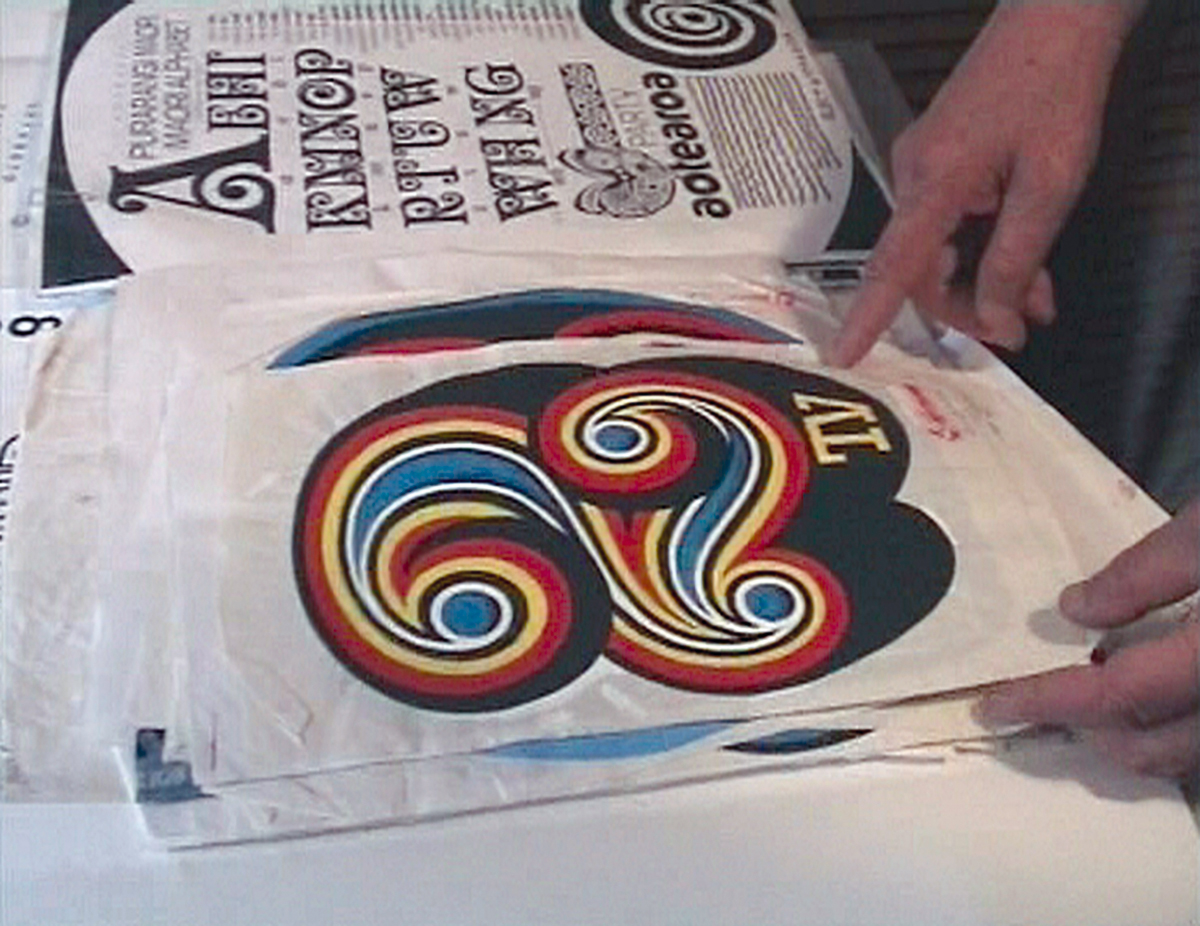Churchward Video Notes A–J – Joseph Churchward, David Bennewith, Warren Olds
On the weekend of January 20 & 21, 2007 David Bennewith and Warren Olds met in the Wellington suburb of Hataitai to have a conversation with type designer Joseph Churchward (b.1932, Samoa).
The following transcripts are extracts from video footage made over these two days in his basement studio-come home. Above the din of the television (always on) and the occasional roar of an airplane arriving or departing from Wellington airport we were personally guided through the extensive accumulation of Churchward’s alphabets, layout work, proposals, correspondence, contracts and family histories.
These extracts are presented in alphabetical order according to an index of notes made while first watching the footage.
5 dollar note
[#1 52:54]
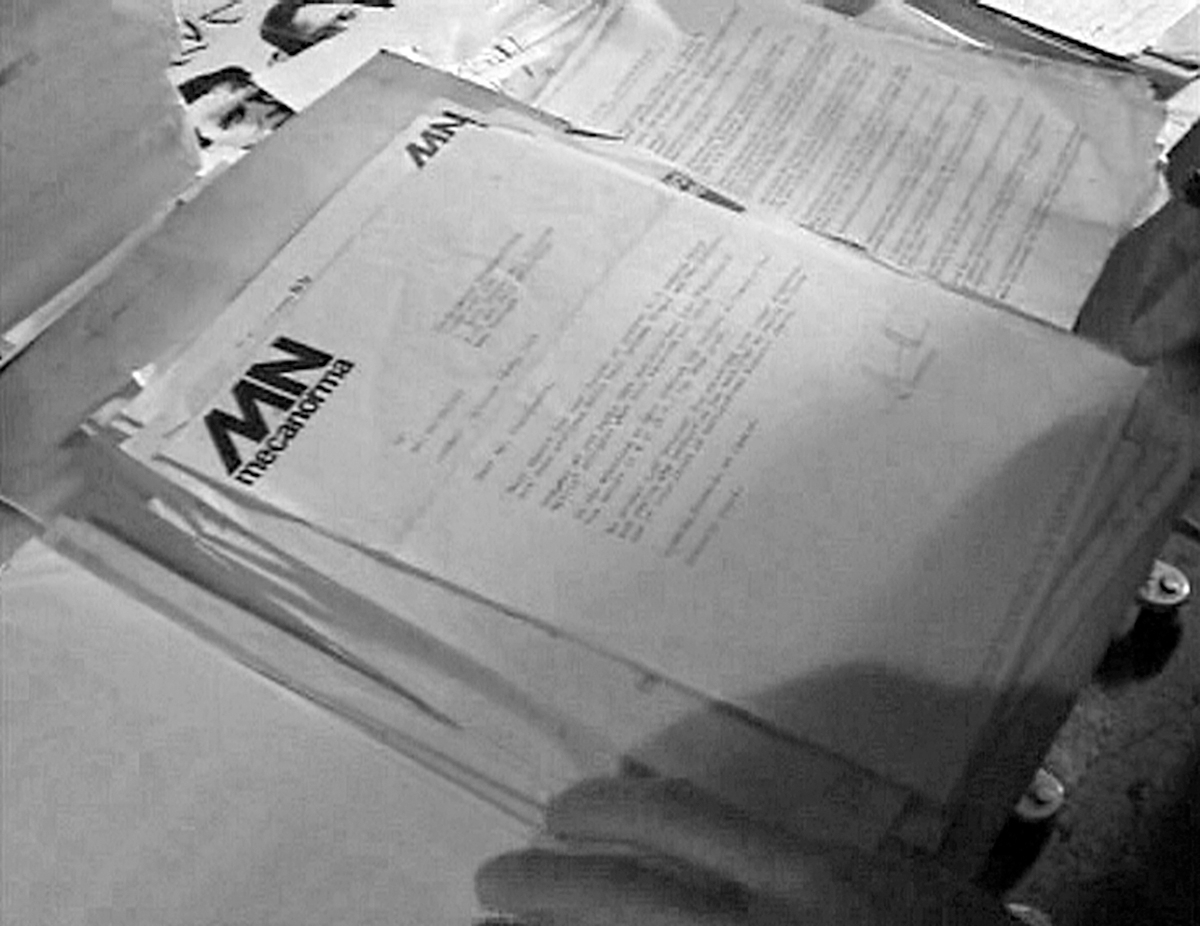
Look, here are a whole lot of agreements from the old days, and they’ve all disappeared [the companies] since I [Churchward International Typefaces] collapsed. There’s Berthold… But what I was looking for… I had some news from America just before I collapsed, they wanted to offer a big contract for all my typefaces, and it was a massive company. But I never replied to them…
Look, here’s Linotype...
So, you worked with a lot of different companies?
Yes, and they’ve all got my fonts. When I came back from Samoa—I’m not sure which company it was—I contacted them for royalties and they just sent me a 5 dollar note.
That’s pretty tough.
And no correspondence or anything. It was just a 5 dollar note attached to the letterhead.
8 million dollars
[#1 20:09]
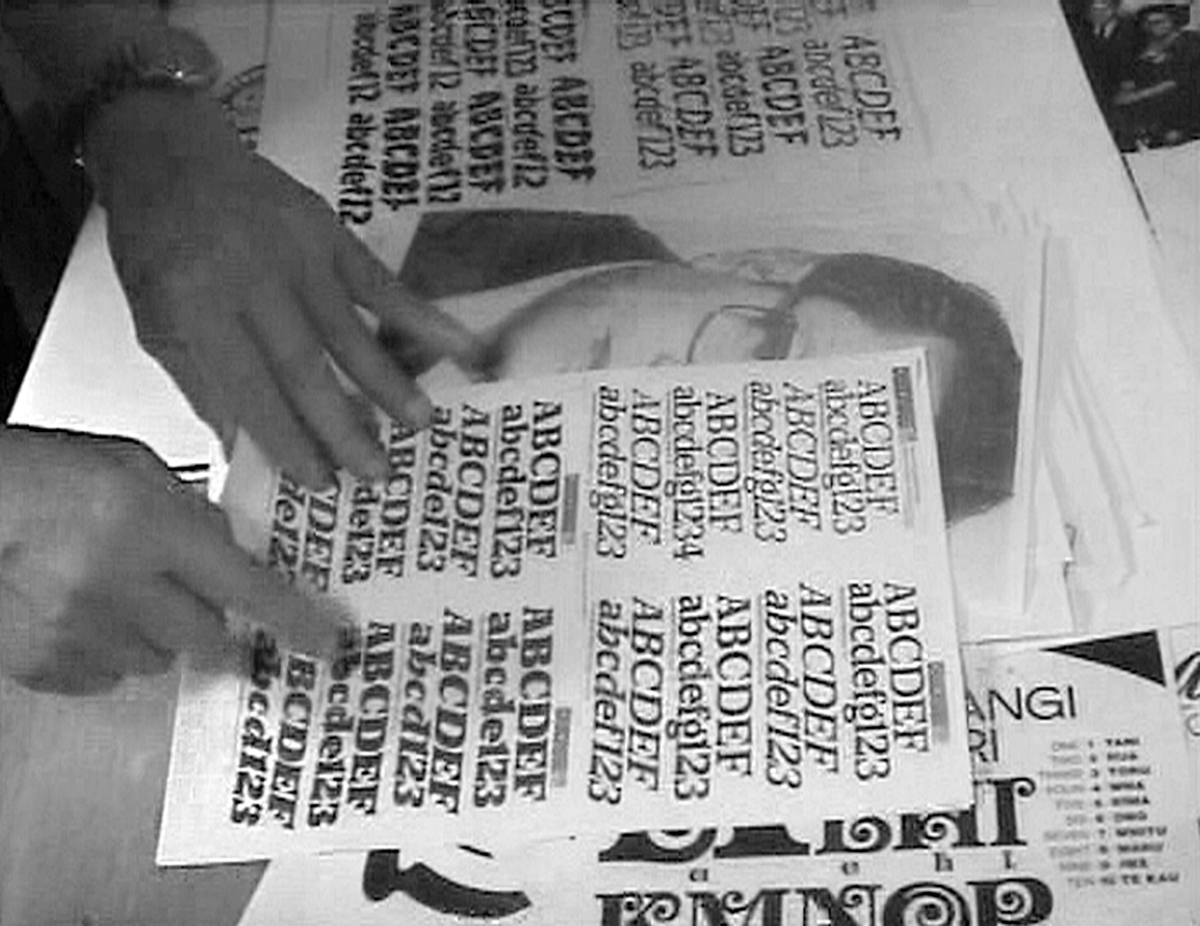
Now, these… When you go back [to Holland]. I would like to sell them, there’s 48 of this [Churchward Chinatype], and 48 of that [Churchward Newstype]. I’m thinking about—don’t laugh—how about 8 million. Now if I get 8 million I’ll give you 2.
Okay… thanks, I’ll get onto it.
8 thousand
[#1 101:05]
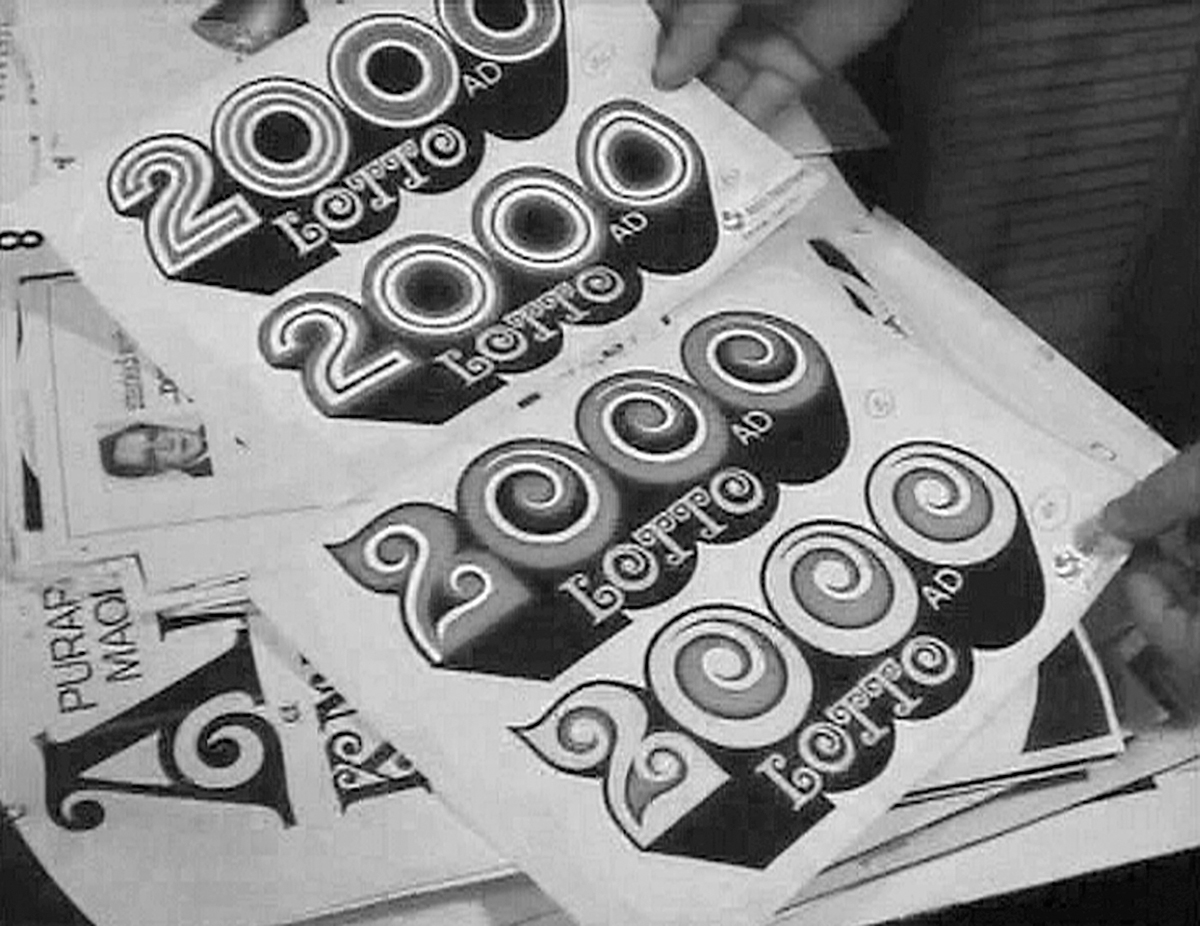
500 alphabets
[#1 13:31]
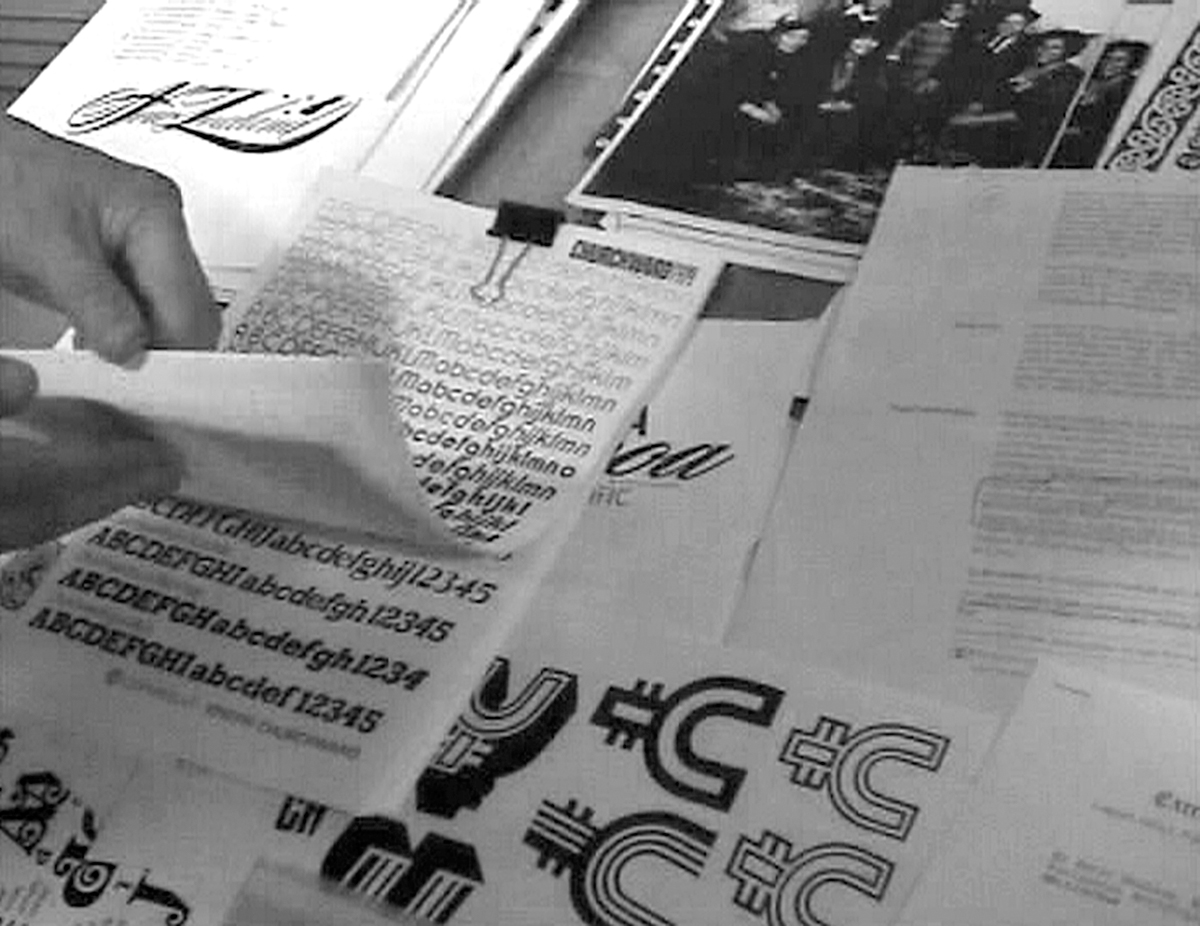
All of a sudden I’ve decided I’m going to aim for 500 [alphabets]. When I go 6-feet under I don’t think anybody will ever beat me.
A library of symbols
[#1 30:12]
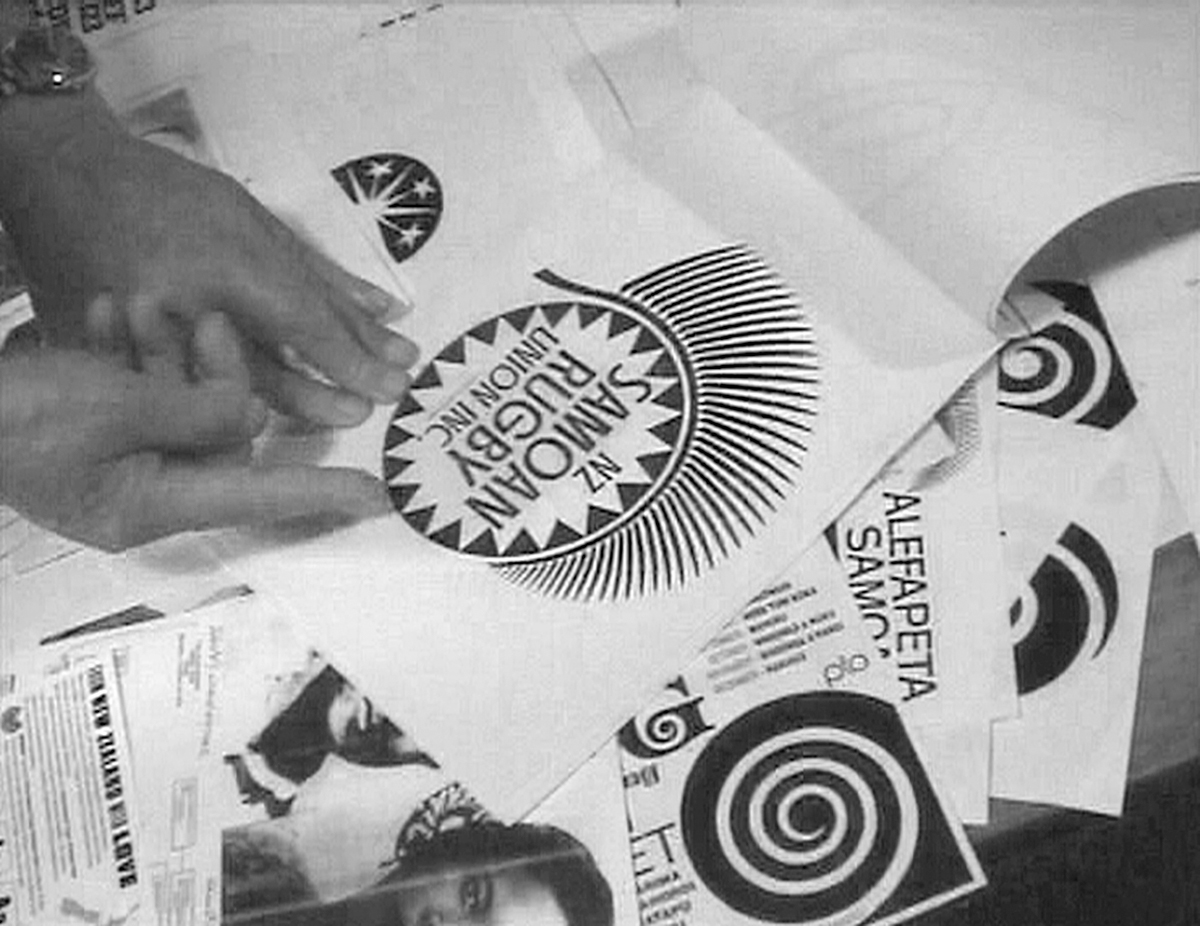
I notice you have a library of symbols that you use quite a lot.
I take the original forms—but I cut things off or add things on. You see
from this—I make that. It’s the same, only I’ve filled it in. Well maybe that’s what an artist is—he’s a fiddler! You can get many variations from the same basic form.
So, it’s variations?
Yes—alternatives.
A New Zealand Helvetica
[#1 77:30]
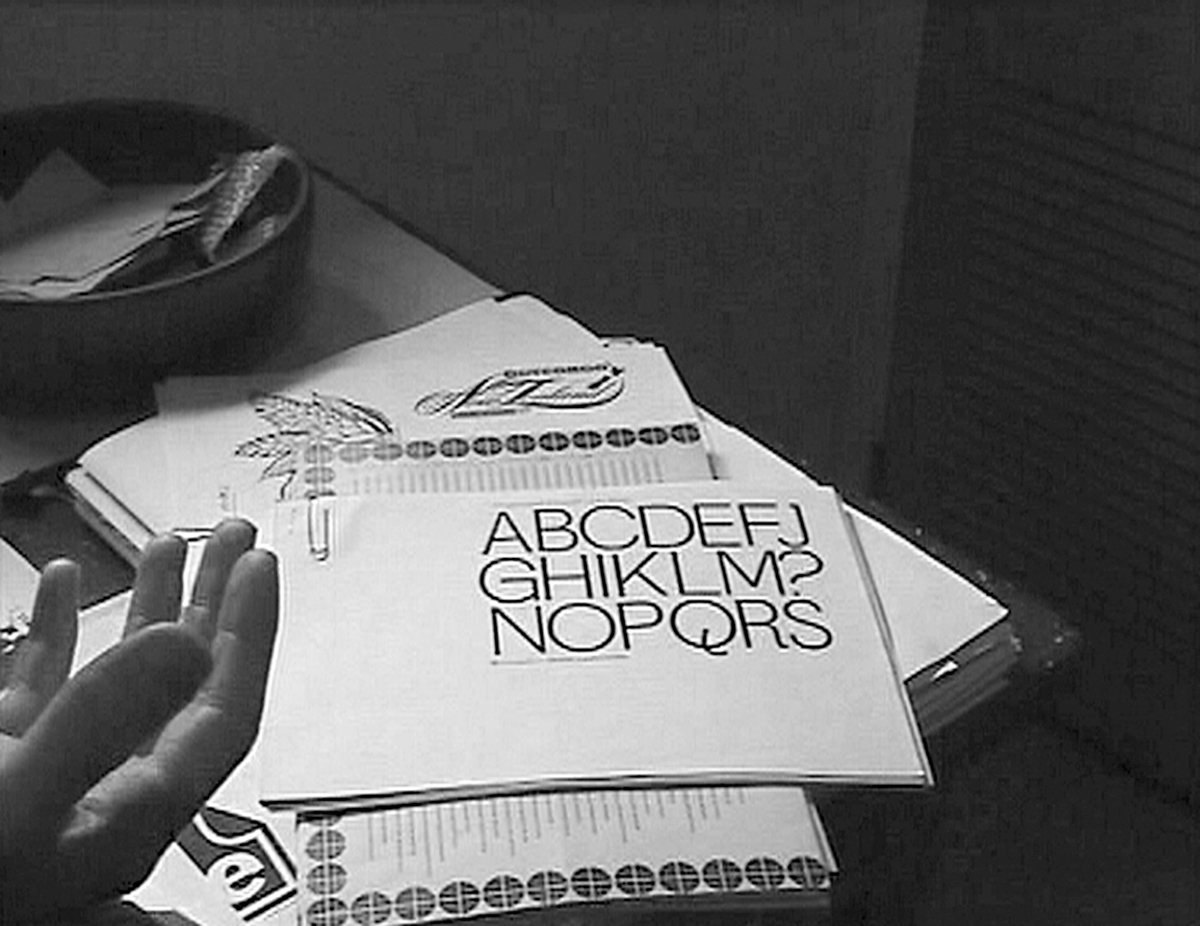
To come back to the Helvetica—do you think that this could be a ‘New Zealand Helvetica’? [Churchward Sans Serif]
No, I can’t call it Helvetica.
Not call it Helvetica, but instead, people could use it here in New Zealand as they use Helvetica. Using something from New Zealand.
Oh yes, do you realise that I’m the only type designer in the South Pacific?
Ah no, there’s a few more.
Oh yeah? But I bet they haven’t done as many as I have.
Going back—if this typeface was available to use in a computer. Do you think people would be proud to use it because it is from New Zealand? Do you think that it is important that it is made in New Zealand?
I think it is better for them to love it because it looks good. Then later on they will discover it’s from New Zealand—and then—it’s better still.
[…] Some words look nice when you look at them—and I think this is because of the style.
Accident, close call
[#3 107:56]
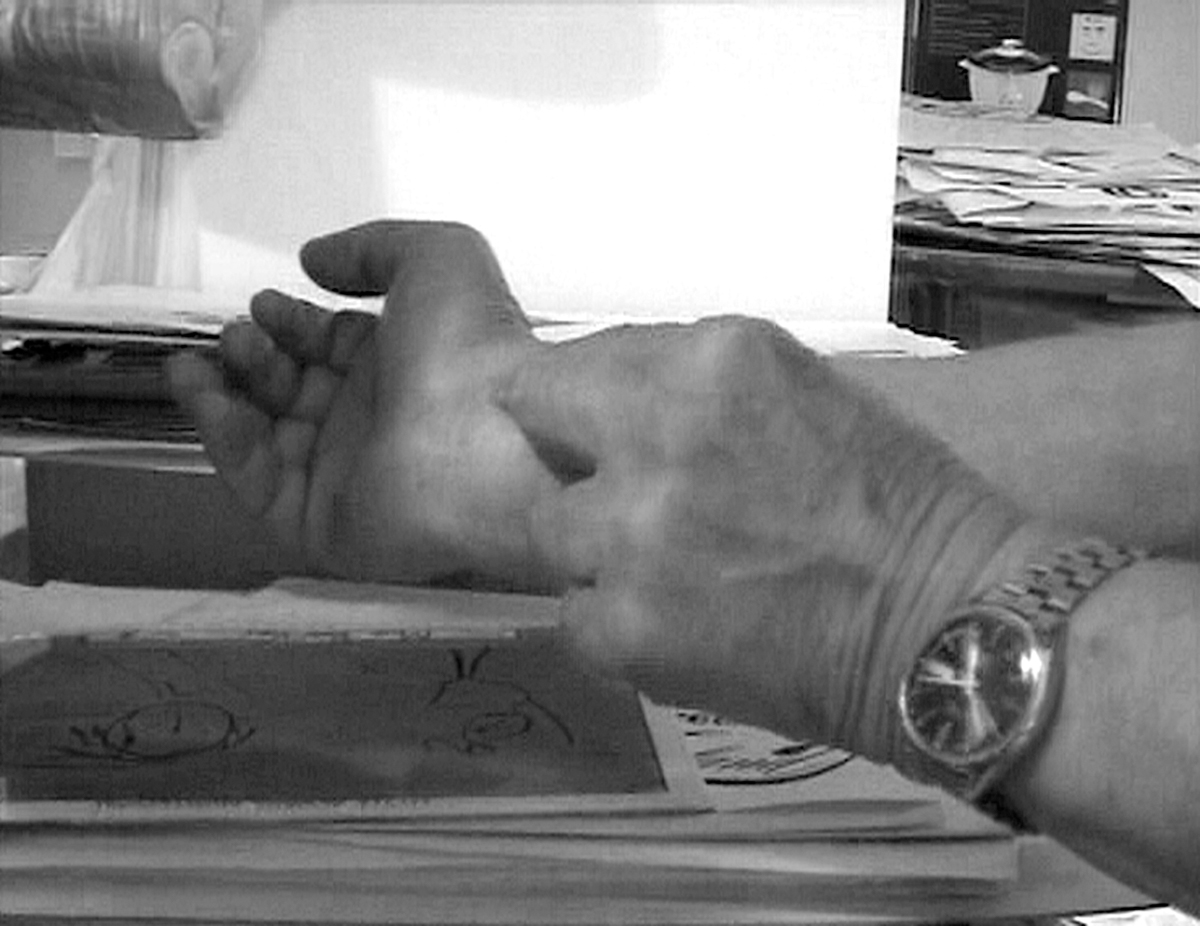
I nearly lost my hand [at art school]. Look at the cut—from here to here. I was chasing somebody and he let go of a swinging glass door and I went to save myself and my arm went straight through the door. I pulled it out and my whole hand was hanging by the skin and I went straight to hospital.
Is that your writing hand?
Yeah. And I got a shock to see my hand hanging from the skin, there was blood everywhere. One of the teachers grabbed me and took me straight to the hospital and I was operated on right away. They all came to visit me, headmaster and everyone.
How long did it take to heal?
About 3-4 months. I’m so glad I can still use it, this is where all the lettering comes from. Perhaps my hand was gifted with typeface designing—I now feel like it might be a reward! It’s worth 443 alphabets!
All by myself
[#1 33:46]
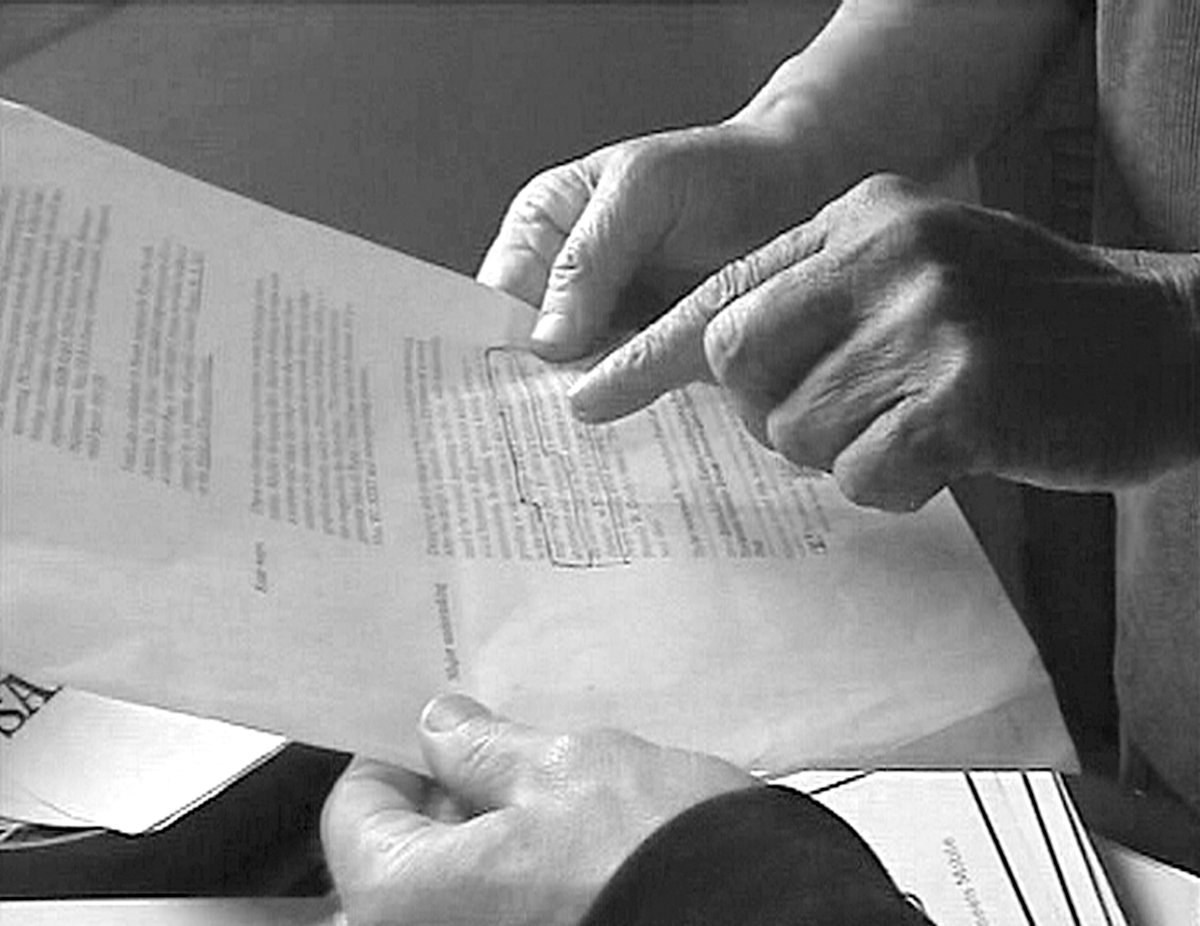
The work you are doing now, you are working mostly by yourself and not with a team of other people. Do you see this work—coming back to that conversation before about having your name on the designs—I imagine most of the finished artwork you did for commissions that your name wasn’t on those.
Well, if you are working for somebody then you have no right to put your name on it. But if you do the work yourself you have every right to put your name on it.
What is the difference between a proposal and a commission?
Putting your name on is a signature. It depends... it gives me a right to the thing [design].
All together, now
[#1 1:12 image / text #2 87:20]
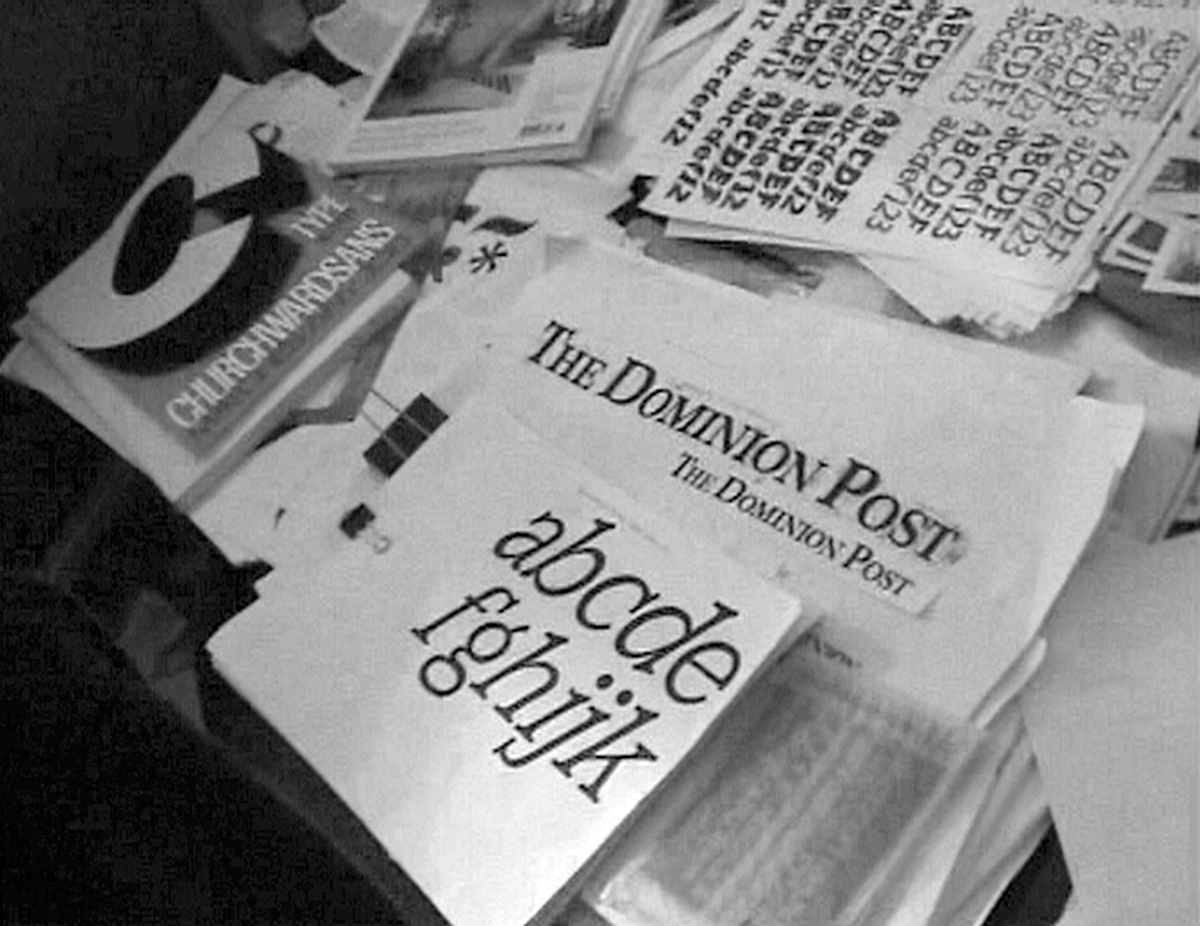
I was going to write about you, describing you as an enthusiastic person. If you could think of some words to describe your work—all of it together...
To me—now—it has been a gift. A gift that I had to produce.
A gift you give—or a gift that has been given to you?
Sometimes my wife says I’m talking a lot of rubbish. I say ‘When I go 6-feet under I would just love that everybody uses them’—that’s why I do it. While I’m alive it’s money, but when I’m gone, mankind is welcome to use them. It’s my gift to human beings.
Approach to practice
[#3 93:27]
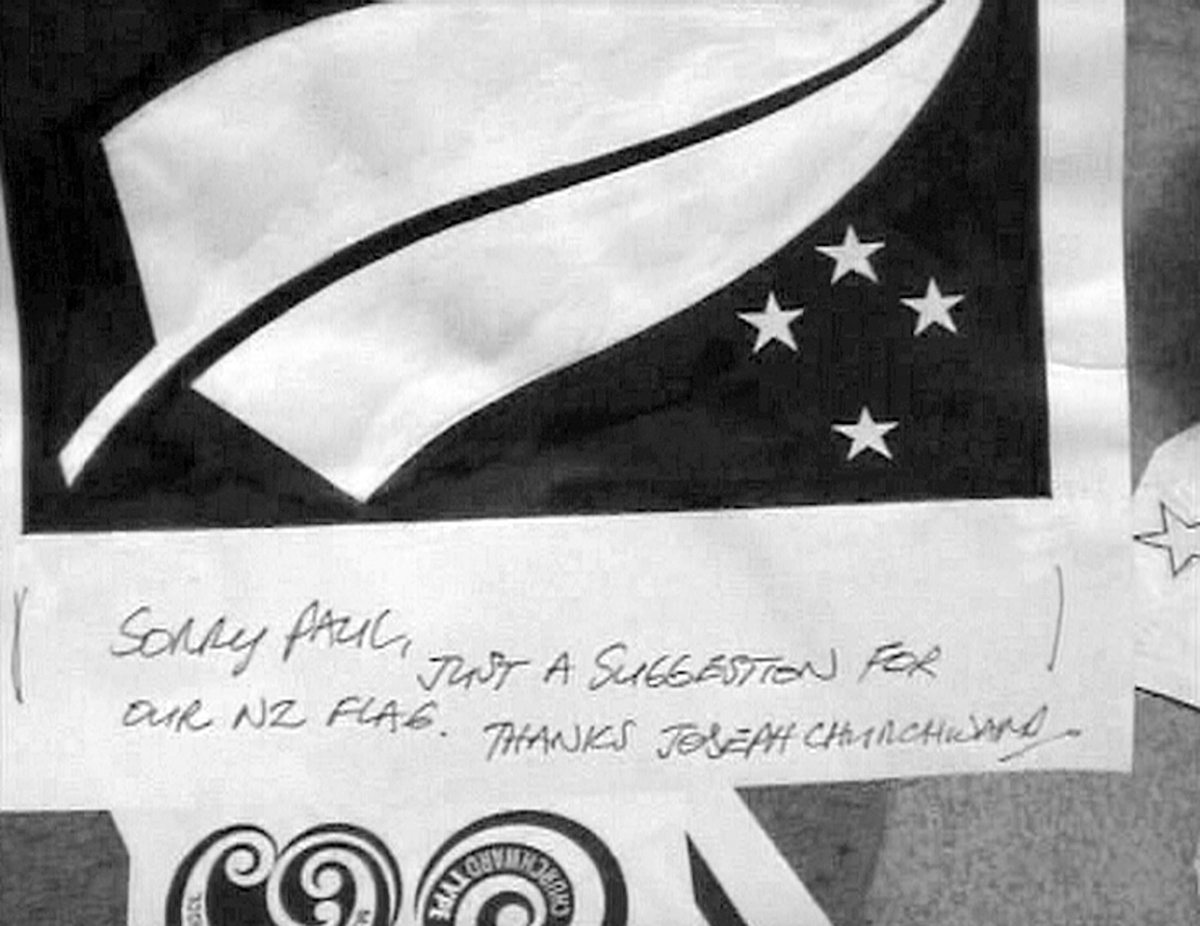
That’s why I was asking the question about your approach to your practise—whether it was something you have to do, or whether it’s just a job you have to do before you retire.
Sometimes I think I’m better 6-feet under—more peaceful... No nagging from upstairs. All women nag aye? It’s their gun against the men.
Art school
[#3 105:34]
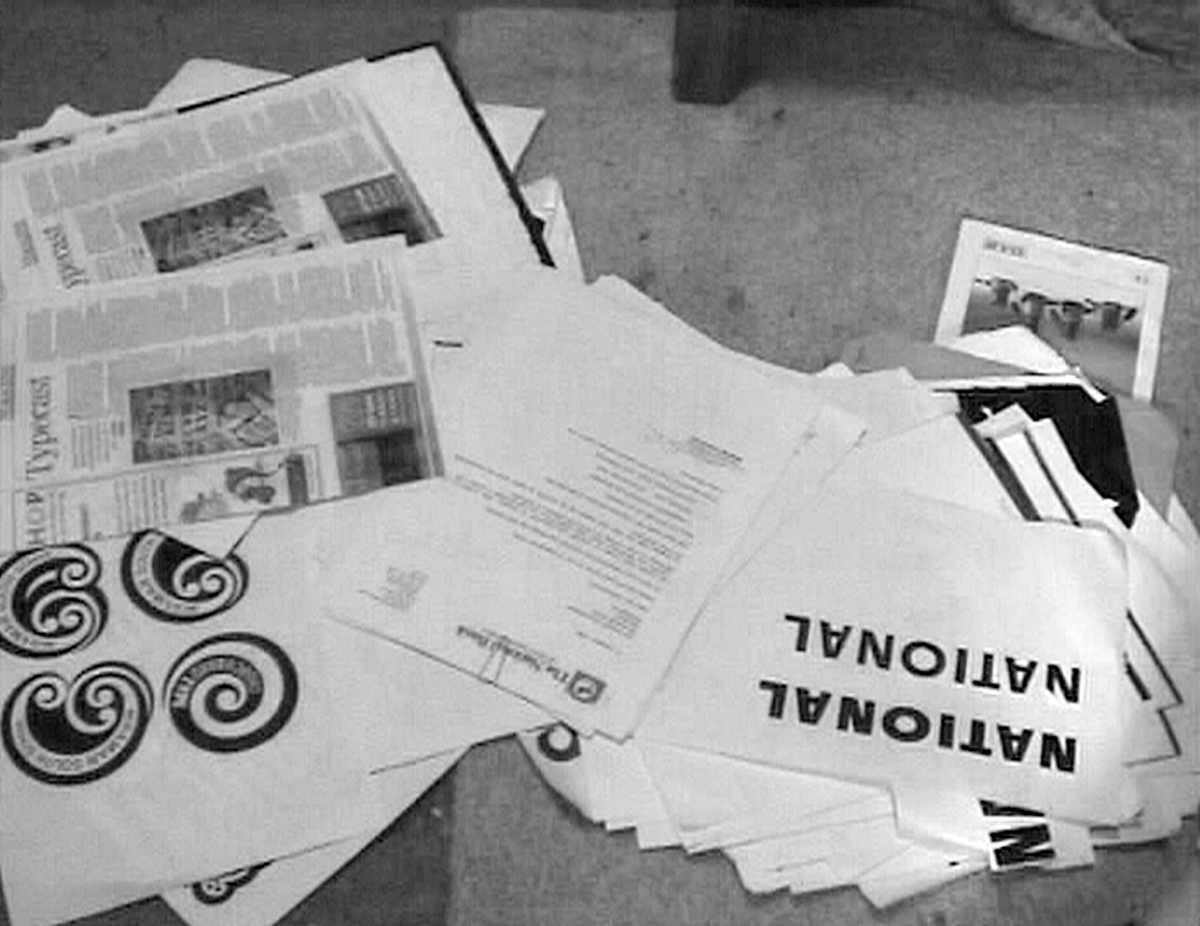
Did you have a good time at Wellington Technical College?
Yeah.
Did you learn a lot?
Oh yeah.
And were you just doing lettering there?
We did all sorts of things, after school we used to do life-drawing, and we used to do modelling…
So, it was quite a general art education?
But they discovered I was good at lettering; that’s how I got the certificate.
Artist/practitioner
[# 69:02]
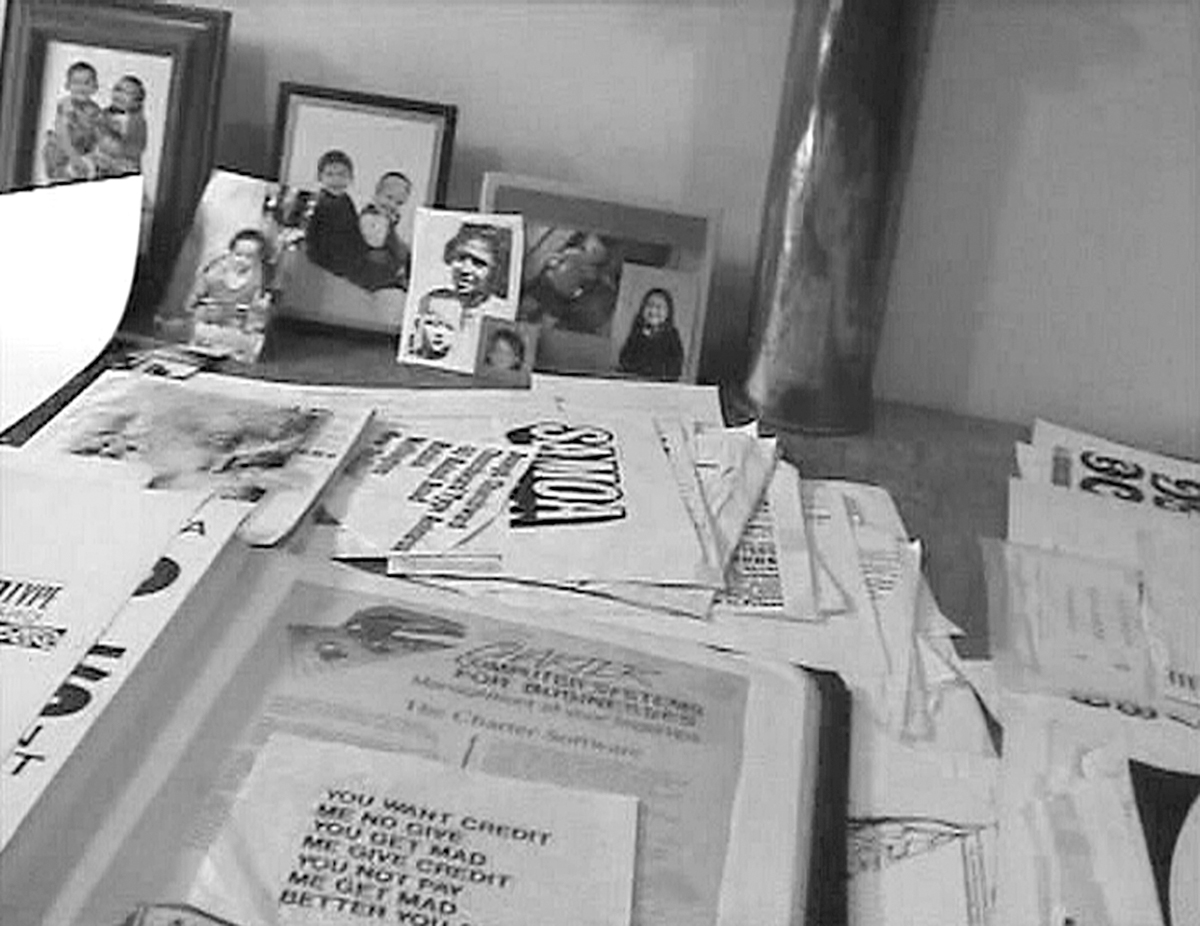
I was going to ask whether you see your self as an artist or a practitioner? Because, some people, they go to work and in the weekend they don’t want to think about it.
Well you see, it’s always with me. It’s always in my head. Sometimes I’m in bed and I think of an idea and then I get up and I draw it.
Art, lettering
[#1 12:41]
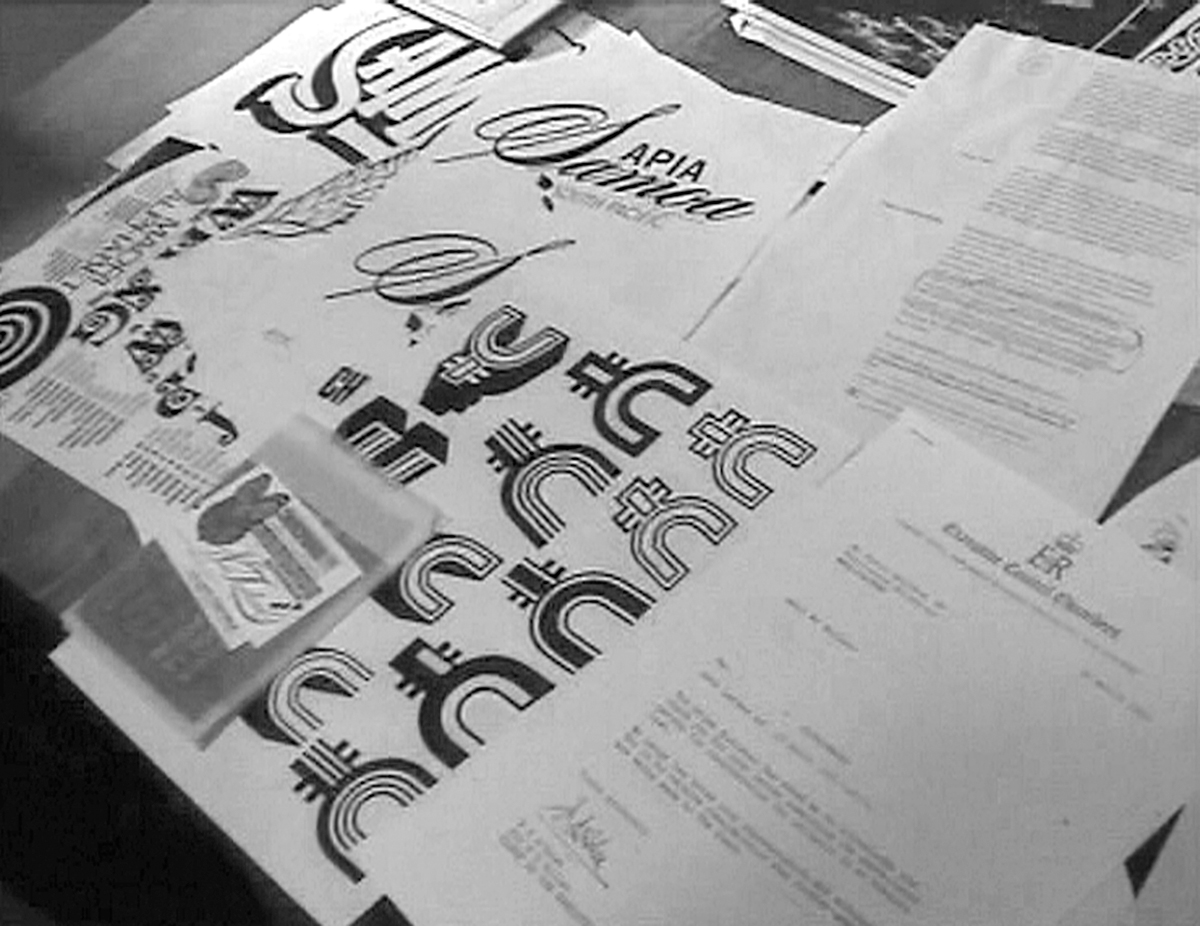
I remember you telling me that you applied for an Arts Council grant.
The fella I applied to was the boss of Saatchi and Saatchi—I’ve forgotten his name—but they said ‘Lettering is not art’.
What did you think about that?
Disgusting. Actually I’m slowly starting to think I’m getting this sort of treatment because I’m Chinese.
Really?
I’m Tongan, Samoan, Chinese, Scottish and English. My Scottish great grandfather was born in New York—so I might be American too!
Artwork, other kinds
[#1 93:01]
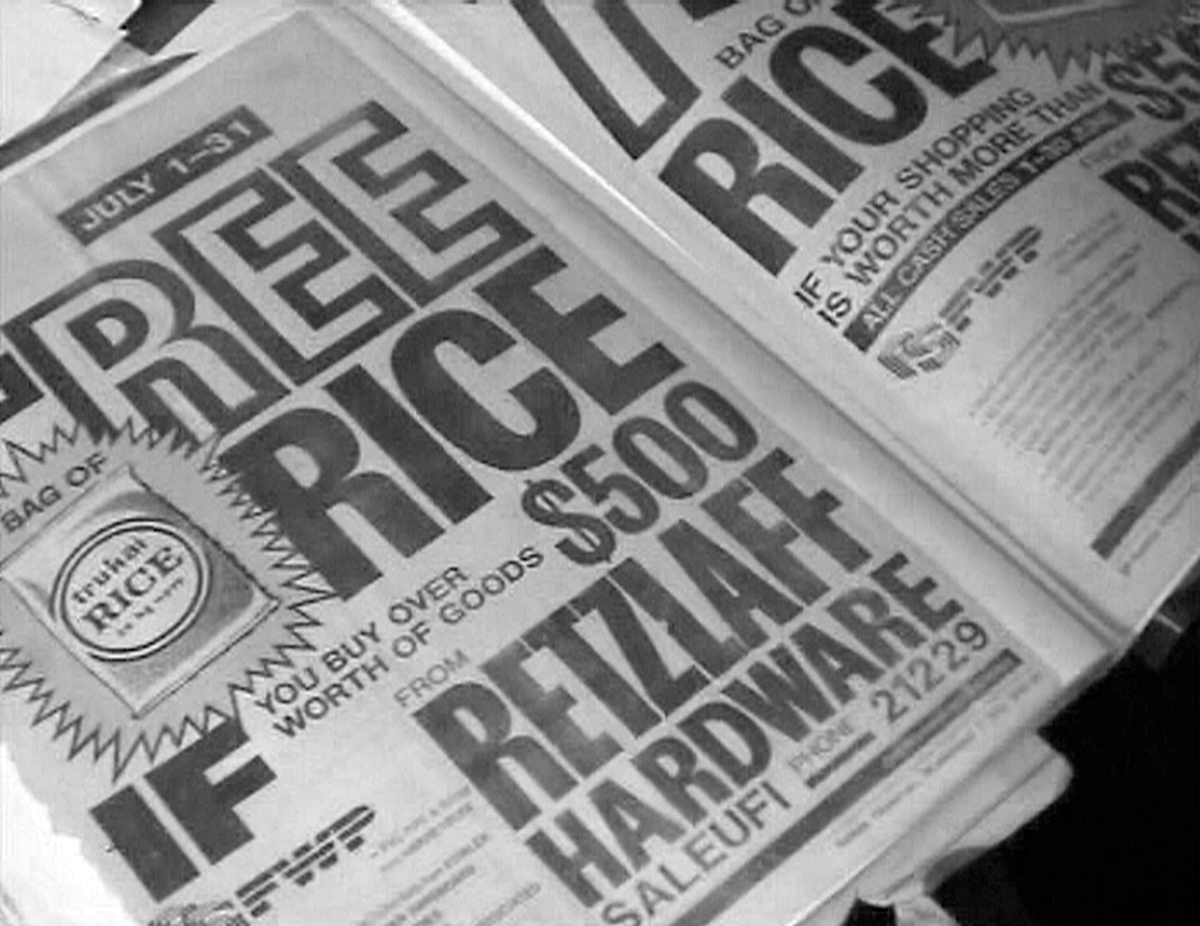
Did you ever want to make any other kind of artwork? You know how sometimes designers leave design and they want to be a painter or something—was that anything you thought about doing?
No, I just stick to lettering.
Banana boat
[#3 61:18]
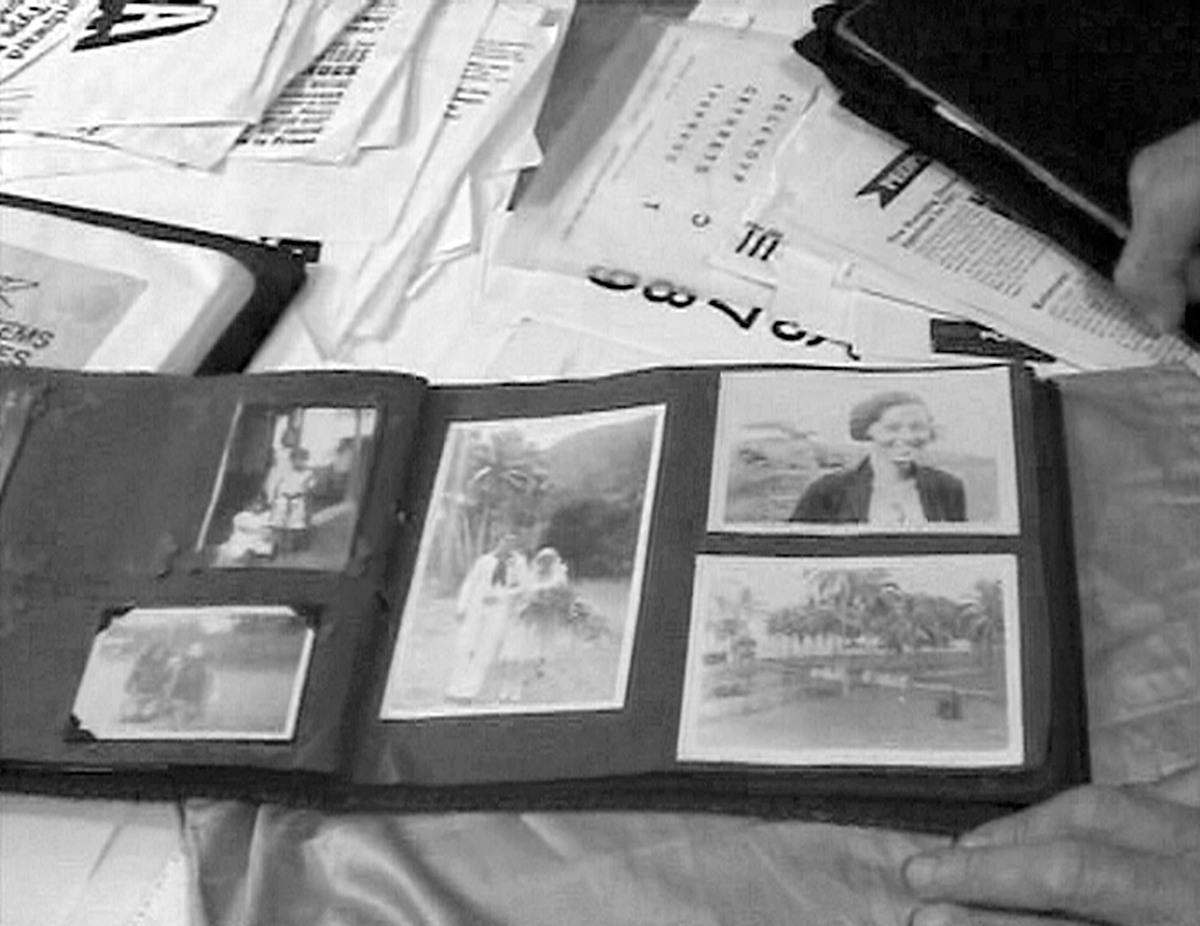
We came in 1946 on the banana boats and there was not enough room, so they put beds where they carried the bananas—in the hold. We slept there until we got to Fiji, then we got a proper cabin.
Baselines, measurements
[#4 09:36]
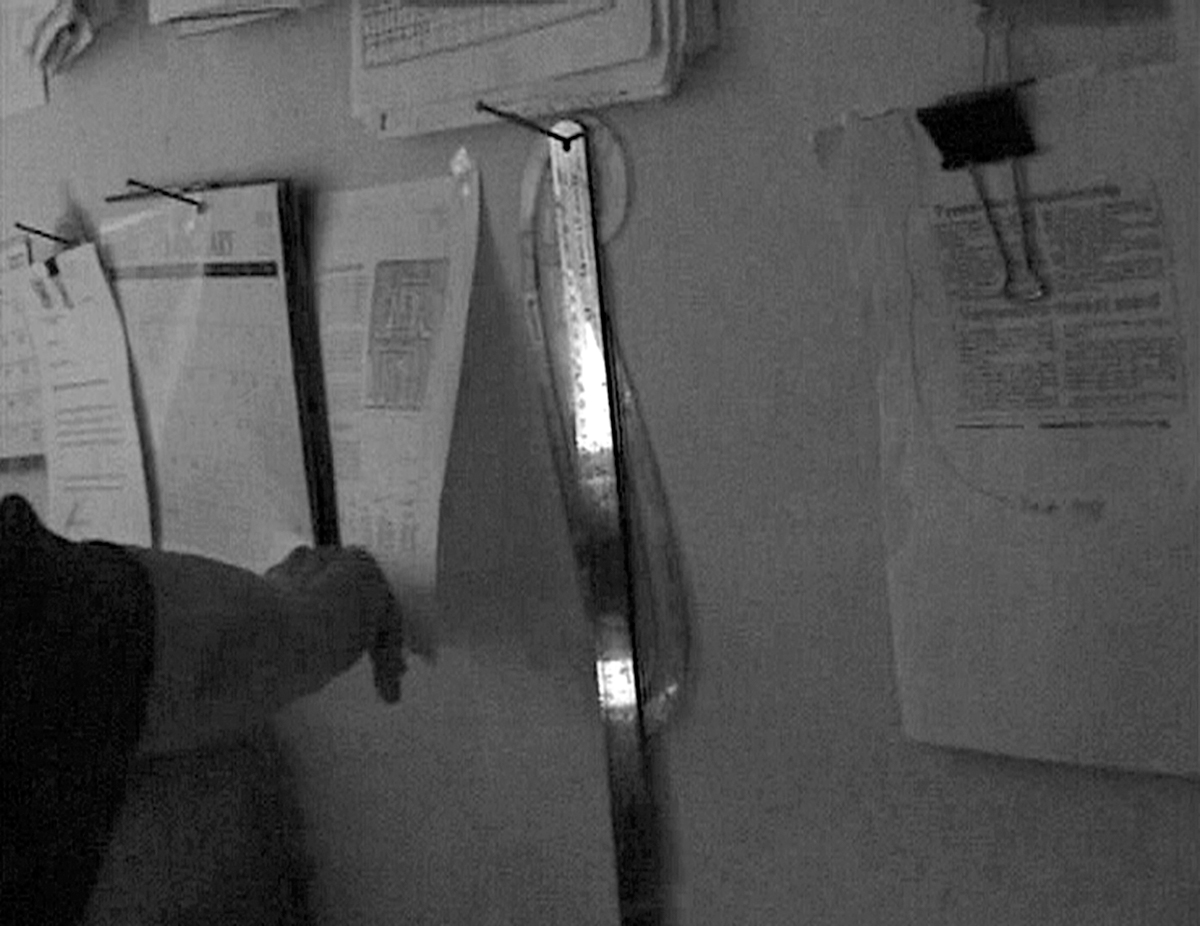
On the sheets you were working on—the Churchward Chinese type—you’ve drawn lines. You have a baseline and a cap height, and you have a line in the middle as well.
That’s for the lower case.
How do you determine how high that line is?—is it the same every time?
Yes, I’ve got it written down somewhere.
So, you just have a number which is a measurement…
70mm, then 25mm down and then the balance is 45mm.
I noticed on the wall over there you had a sheet with the ‘golden section’ printed on it.
One of my artists gave me this years ago, and the reason why I need it is it has the ‘A’ sizes of paper on it.
Actually I thought that 25/45 was a golden section relationship.
But you see, look, look—look how big that is. [Showing old boards] I used to do them at 150mm high, but I was going through so much card. So, I decided to use 70mm because it fits so nicely on an A3.
Cellphones, technology (changes)
[#1 120:51]
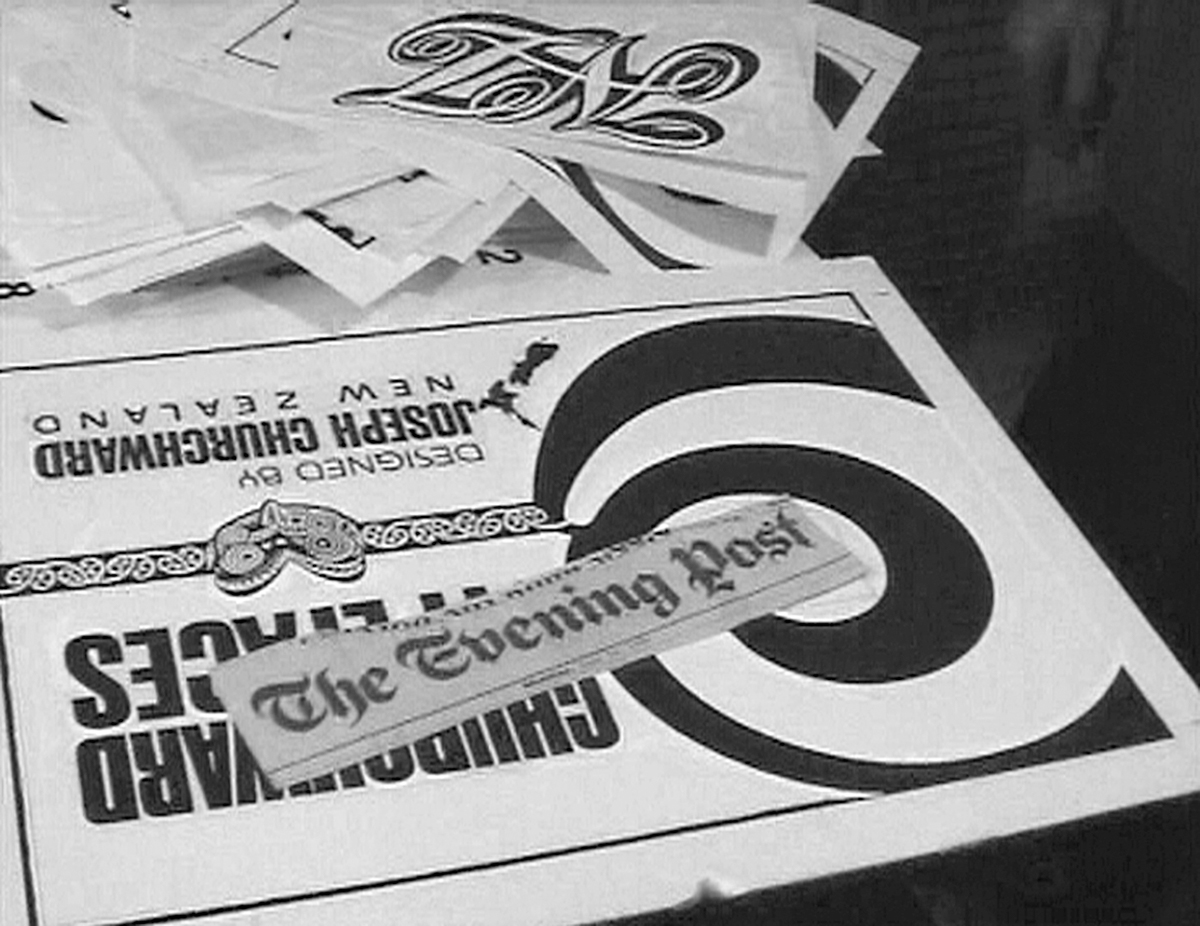
Do you ever look at historic, much older typefaces—like from the 16th century?
Well, the ‘Evening Post’ masthead is a bit like that. But… do you realise how important alphabets are?
Yeah… really important.
If we didn’t have alphabets we wouldn’t have words. Actually in the old old days, before we discovered the alphabet we were all animals—mumble, mumble, mumble… you refine the words when you make up the alphabets.
Do you have a cellphone?
No.
What do you think about how words are becoming shortened now, like with TXT messaging?
It’s man; man keeps changing and changing.
I guess that’s technology isn’t it?
But in my day too, when I went to primary school in Samoa, they were teaching me the numbers—Roman numerals—‘V’ and ‘X’ and ‘I’ and they told me ‘It’s a difficult one to learn, but, there’s a new system of numbers coming in’. Then—not very long ago—I discovered on the TV that we pinched the 1 to 0 from the Indians, it was an Indian discovery.
The metric system.
Why did they keep it so quiet? Why didn’t they tell us it was an Indian discovery?
Vanity I think.
Then all sorts of different things start coming to my mind… the sailing ship was invented by the Chinese…
Charles Haines, working relationship
[#1 72:00]
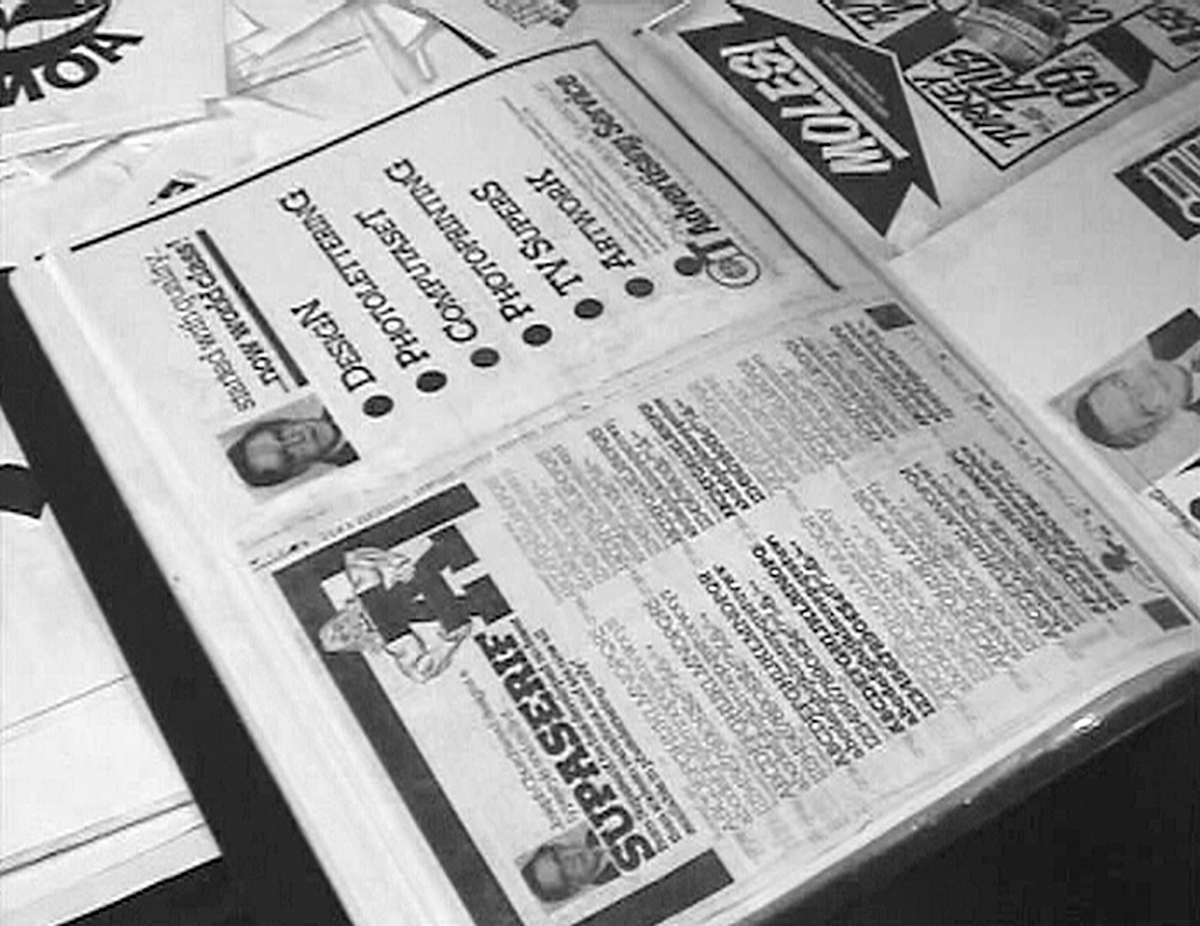
So, that was after you left Charles Haines Advertising that he [Haines] did this illustration for you?
He did a lot of work for me after I left. He did all the illustrations for ‘Woolworths’.
You were still working together even after you left?
We were good friends. When I was at Charles Haines every so often some young fella would say ‘Joe, you look like a bloody Chinese’ and he [Haines] used to get up and thrash the daylights out of them—‘Don’t be so bloody rude!’ he would say ‘His great grandfather was English!’.
Children
[#1 9:00]
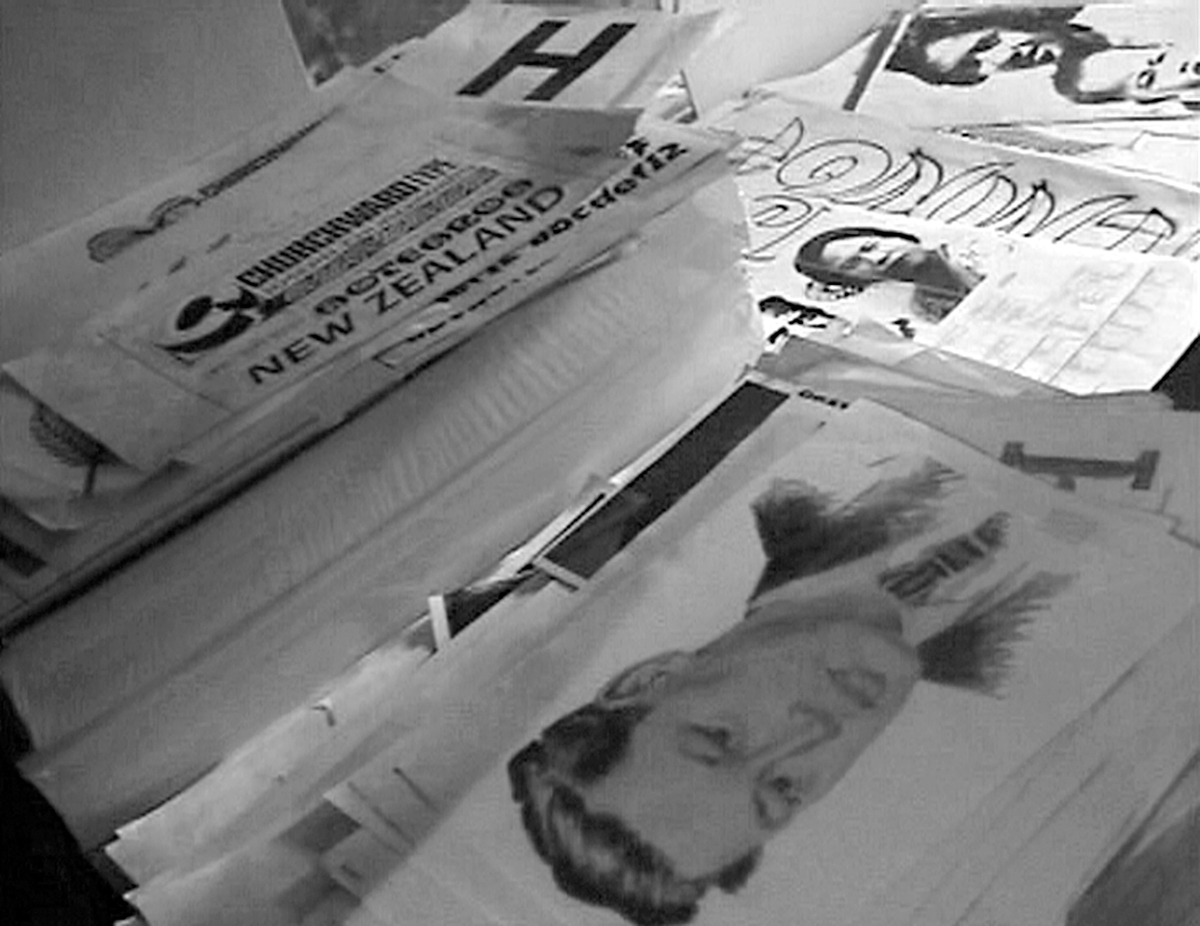
All my kids were working for me. Marianna and Lorina [etc…], they were all typesetters. And Joe [Jr.] was working for me too. And when I started to collapse—they all disappeared.
Were your children also interested in type design?
No, no, they were just typesetting. I just didn’t want them to be involved in hand-lettering because it takes too long.
Churchward Dingbats
[#1 66:17 image / text #2 84:40]
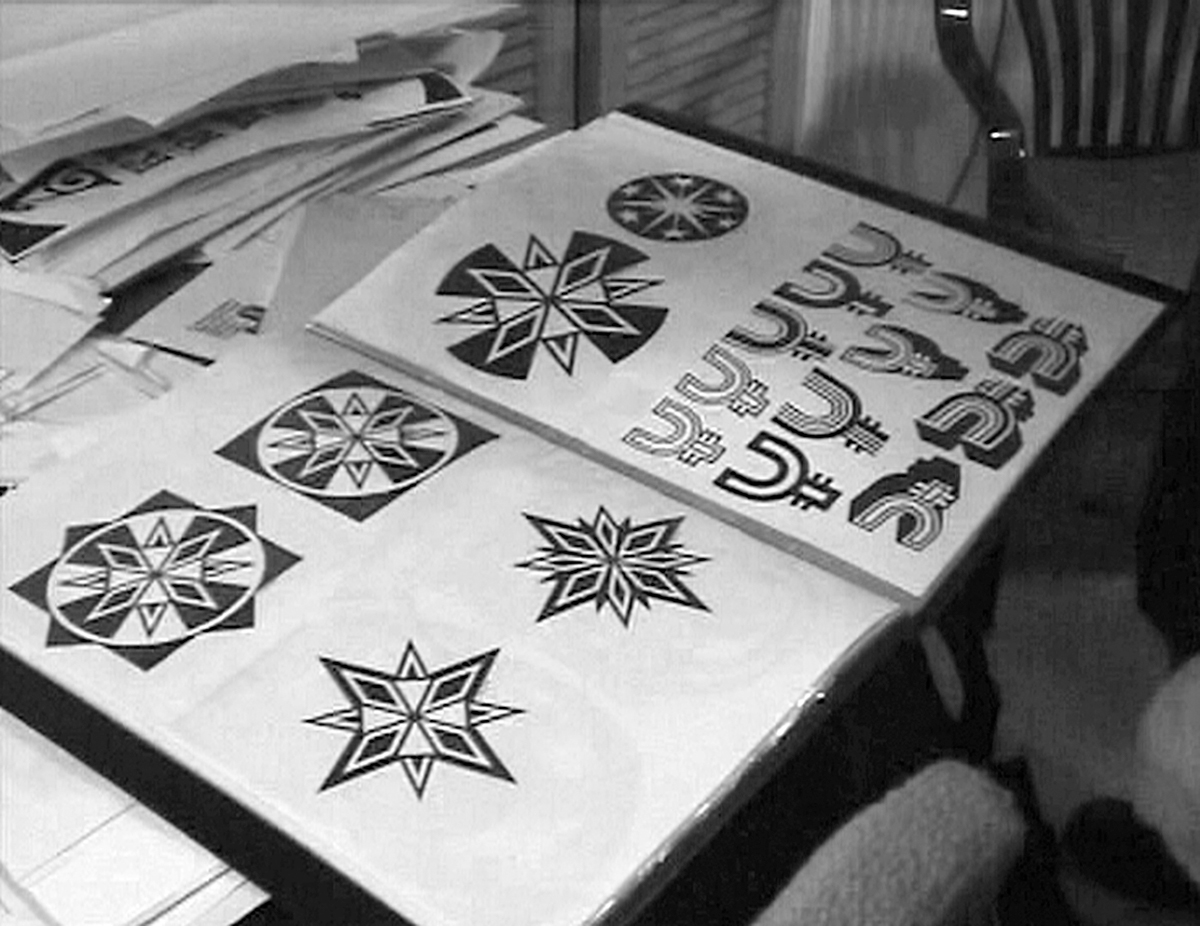
Have you ever made any ‘Dingbat’ typefaces?—with just images or symbols.
No, no.
The Samoan stars you make, the circles and diamonds etc…, They seem a bit like Dingbats—do they have meaning? Are they like words, or, are they patterns?
[…]
Churchward drawing type, demonstration
[#2 72:03]
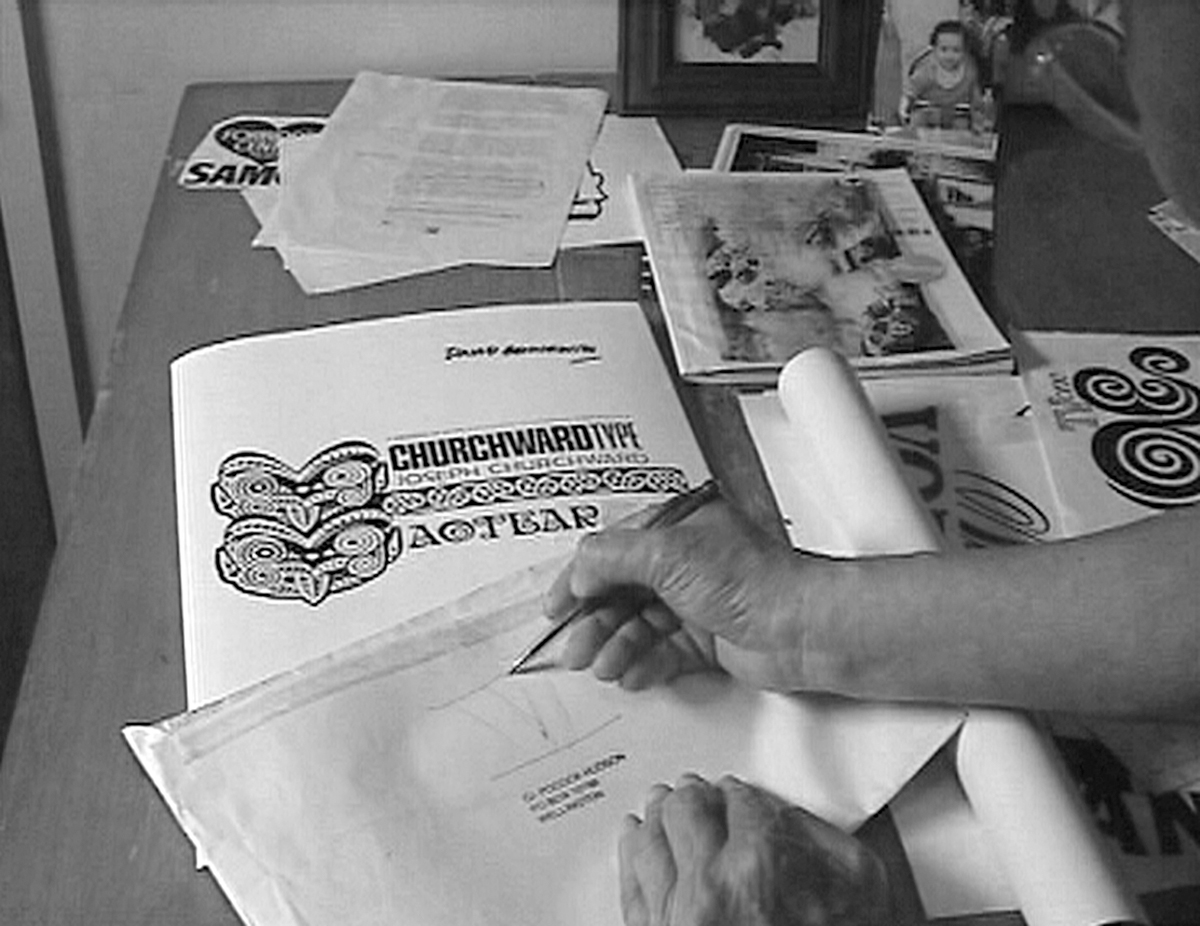
Each letter has many variations; you can change them slightly to make them look like your own. There’s something else I discovered, you can use it a lot, you got a pen
Yep.
I shouldn’t show you, but I’ll show you. Now, ‘V’—most of them are the same thickness there and the same thickness there. I’ve learned if you make it slightly thicker at the top it makes it more attractive, and take this white part to the bottom. Because the way they used to print it—it became blobby there—and it looked ugly. It is more pleasant to take this white bit as far—not too low—down, and it looks cleaner. But you use your eyes and you can see what it is doing. You know, that can be part of the ‘W’, just treat it the same way and repeat it. Don’t forget the downstroke is thicker than the upstroke.
You can know those things, but to actually do them is quite hard.
Well, it’s your eyes and your brain, you can see it.
Do you ever test the letters in a word—or outside the alphabet?
If you do it nicely in the first place when you produce a word it looks good. I’ve also got my own way of spacing—by eye.
Is that something you learned through working?
It’s more a judgement—it has to look even—no matter how fancy the letter is you still have to look at it that way.
Some people say that when you are designing with type you are designing the white area, not the black area, when you are laying it out or spacing it. Do you think about the positive or negative aspect when you design?
That only comes in when you are producing a word. Even when it is on a curve you have to look at it the same.
Do you think that letters can be too close together?
No, I don’t mind this as long as it looks even—sometimes they have to touch.
Churchward's printer
[#1 10:39]
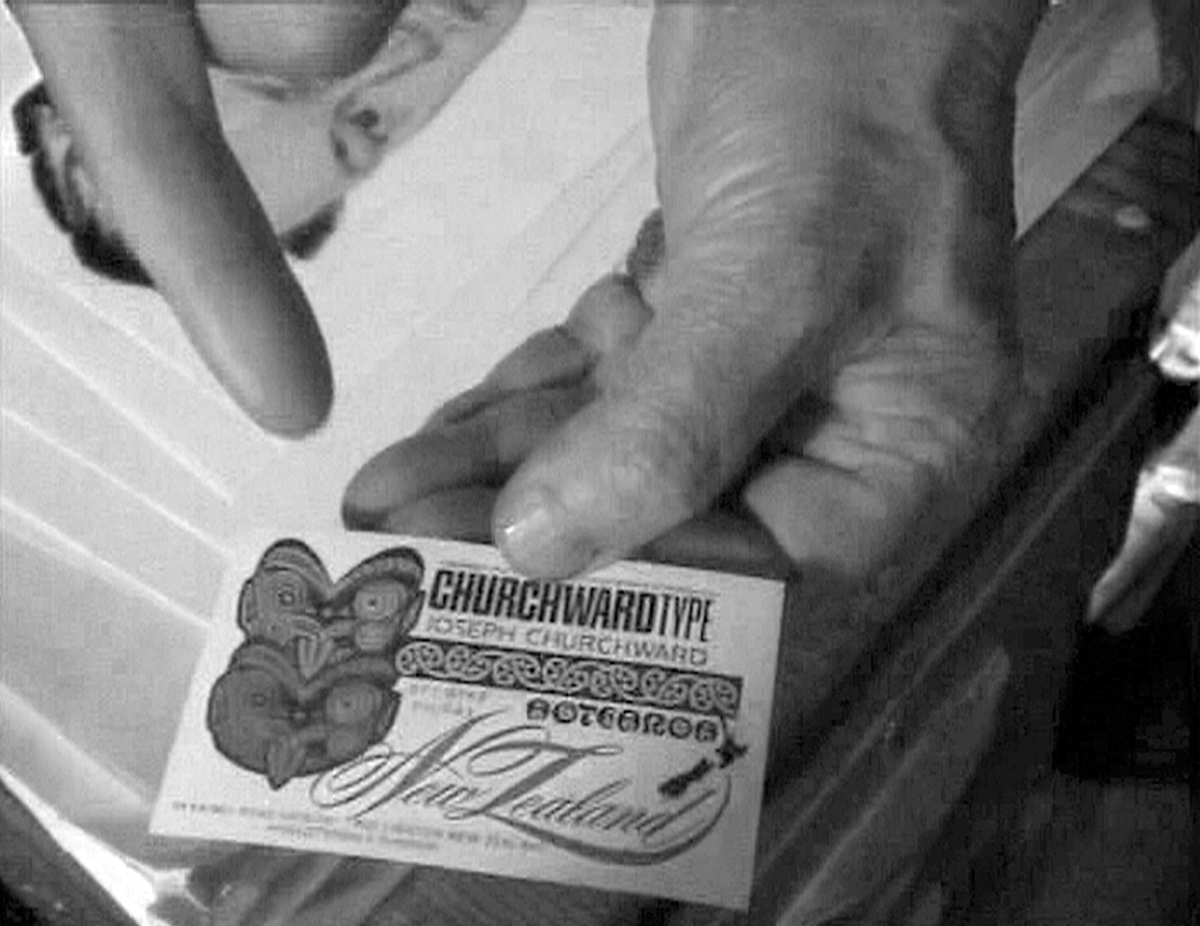
Where do you get these printed?
I’ve got a printer. His name is Charles.
Is that someone you have been working with for a long time?
I discovered him when I came back from Samoa. He’s a good printer. He didn’t print this one, but he printed this one, now he’s printing this one. It’s not going to be ready until after the holidays.
Churchward's Roman
[#2 13:38]
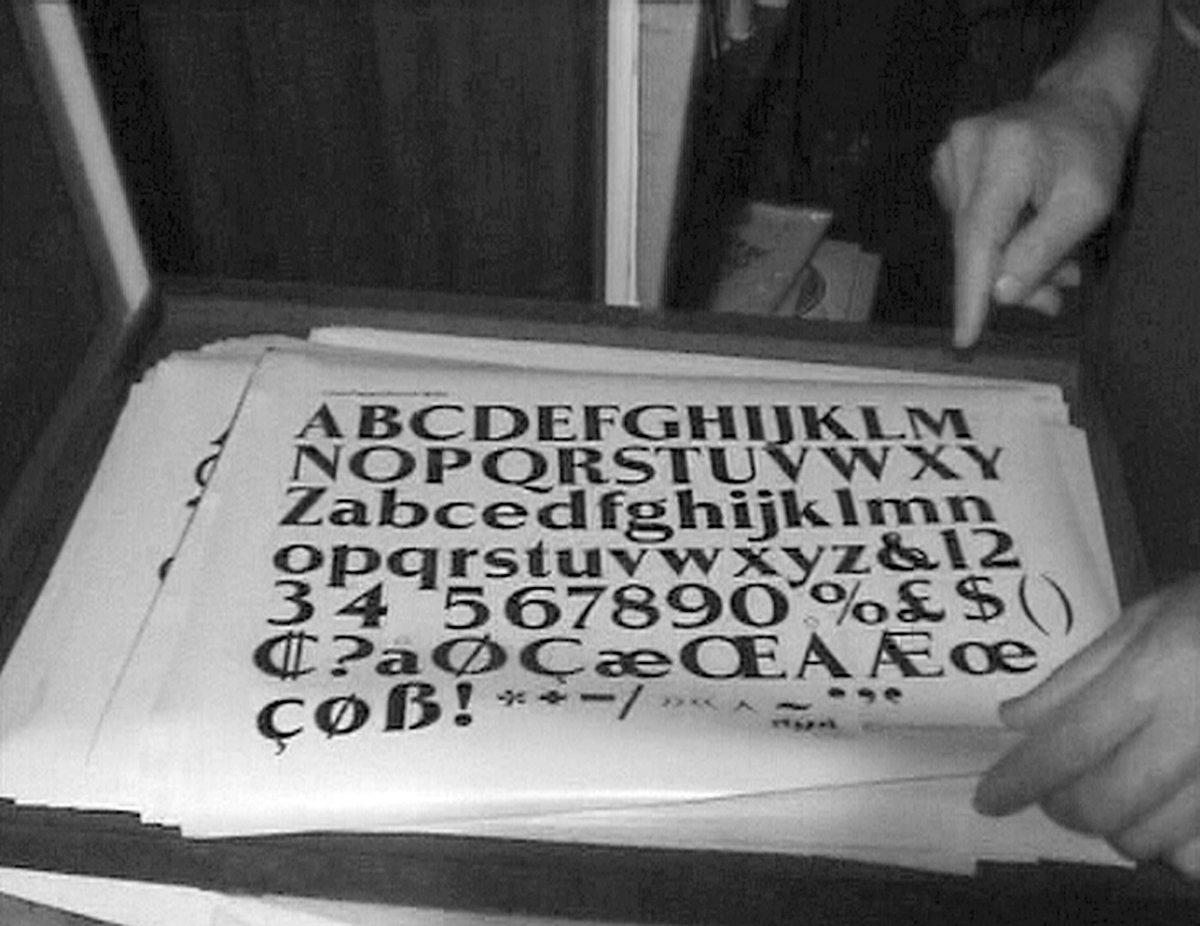
Roman—my own Roman. It’s slightly different from the others.
Clients in Samoa
[#2 41:40]
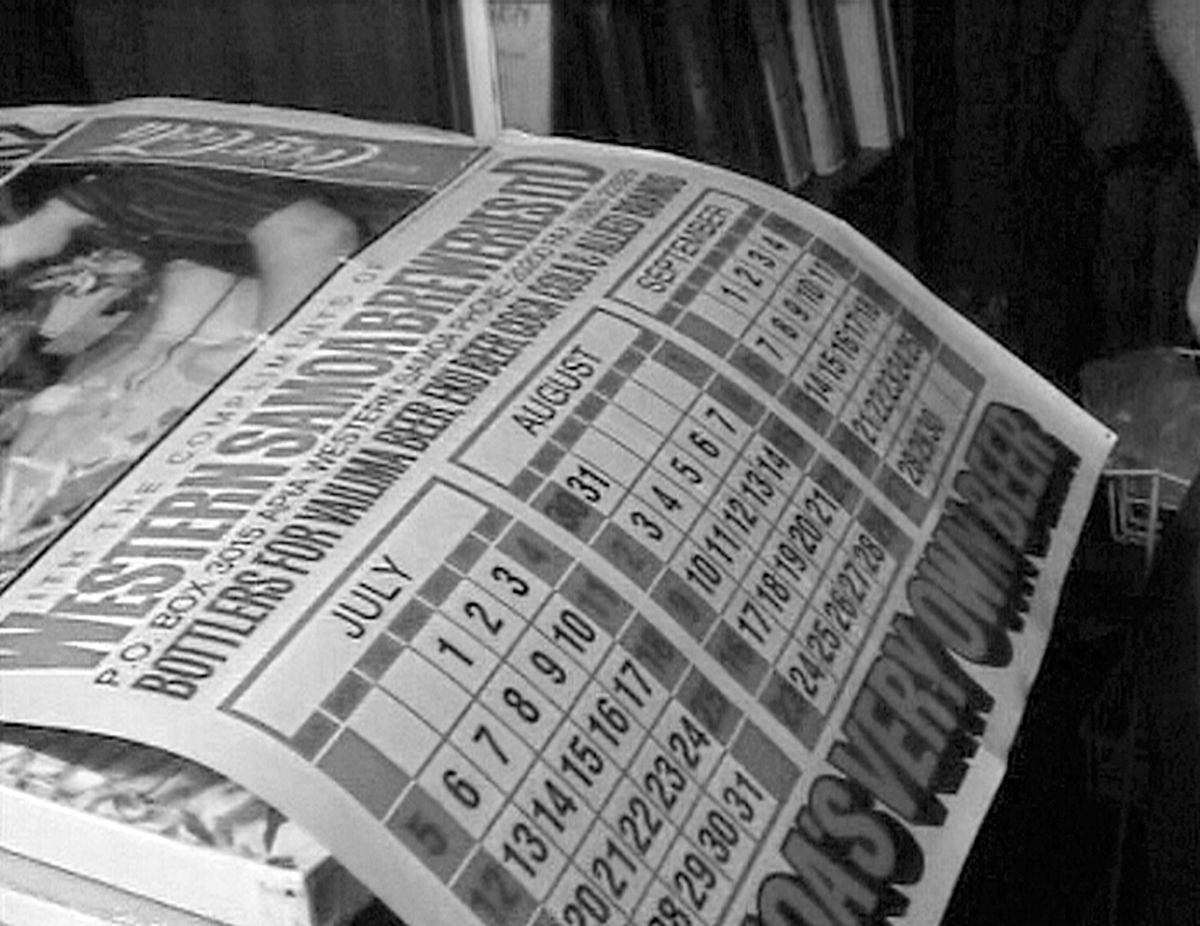
When you went back to Samoa did you have different clients to when you were here?Yes.
Was it different? Did they treat you differently?
I was very popular because of my service. Because when you’re not in time to put an ad in the paper the clients would get annoyed—they are on the losing end then.
You never really had problems?
This is me and this is the client, and we would get closer… hold hands.
Were they different sorts of jobs you were doing in Samoa?
It was all advertising.
Closing down
[#4 04:51]
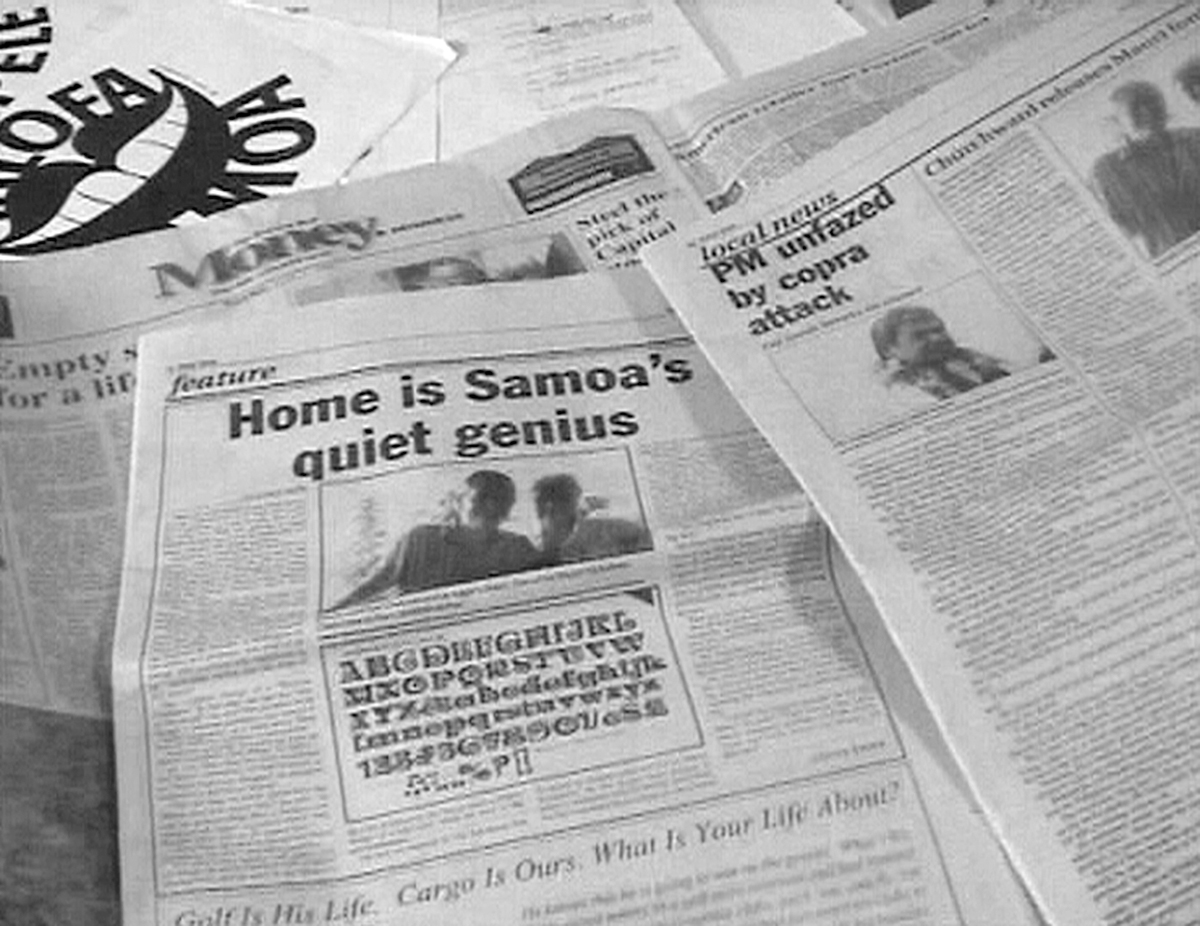
Was it very sad for you when you had to close down?
My lawyer advised me—I said ‘I’m thinking of going to Samoa’—he jumped to it, he said ‘Go immediately’. He said ‘Up Willis Street there are a lot of men that lost their businesses and about 3 or 4 have jumped through the window—committed suicide’. So I left immediately.
It was quite a hard time then?
Yeah, the lawyer told me that up Willis Street there was a big house occupied by some of the business people that had collapsed [gone bankrupt]. He said ‘Bugger off Joe, go back to Samoa’.
Because of the stock market crash?
Yeah, that’s how I lost mine I think. Although I really think the reason I couldn’t continue with my business is because I rejected the Apple Mac. The Apple Mac took a lot of my work.
So, a combination of those two things?
The most important thing to me when I was in business was the gum—the paste-up. I’m so used to it, I still prefer to paste up. Now I’m hearing that a lot of people are getting fed up with the computer—you’ve got to know what to press to do this and that. And I explain to them, if they ask me to draw a circle, I just do it. I don’t have to look for the buttons to press. But the computer is beautiful for other things—a fantastic machine.
Completion, typeface
[#2 21:48]
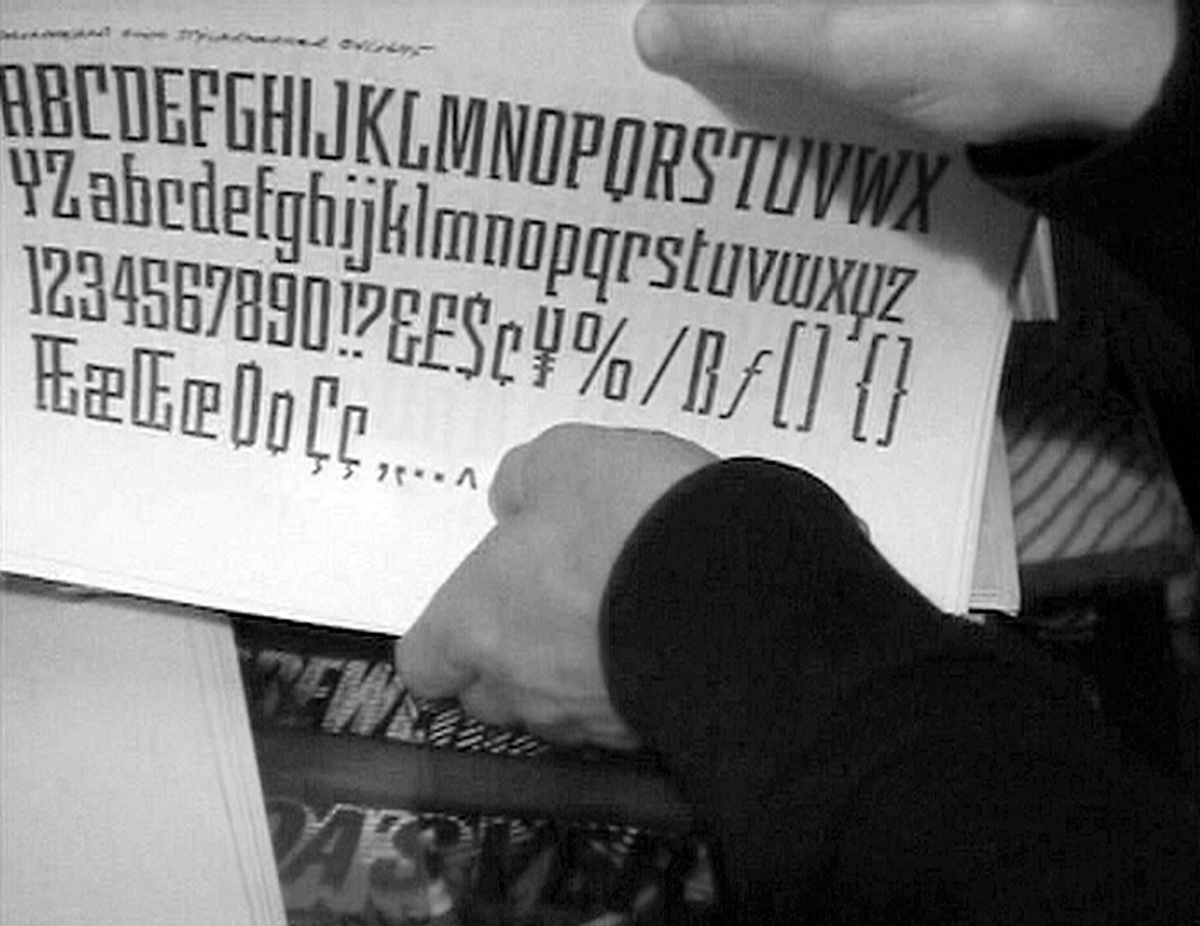
So I guess—for you—it is complete when the drawings of the alphabet are finalised and all the letterforms work or fit together. That’s the completion point. Rather than when it is being used afterwards?
Yes.
Computers
[#2 28:33]
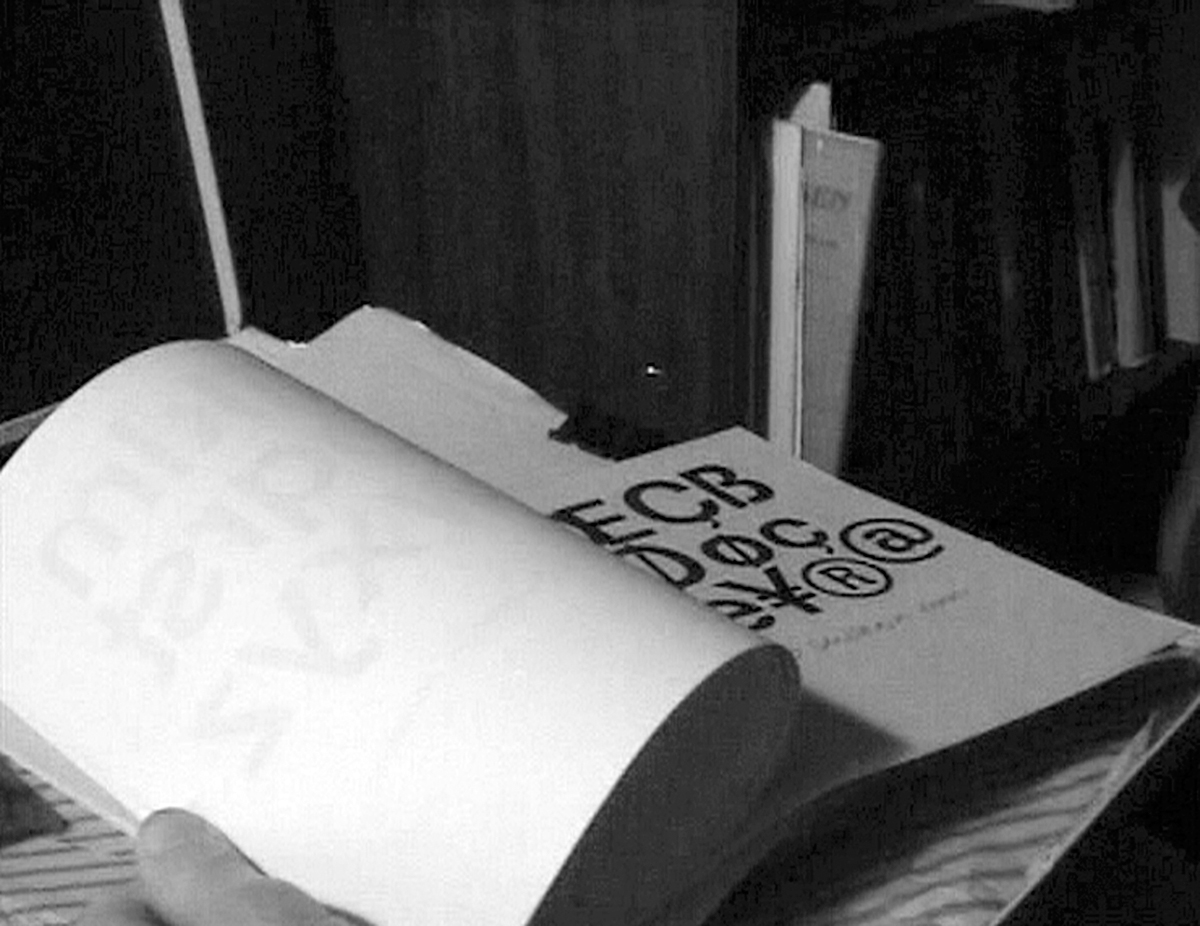
Do you ever use a computer?
Like I said, I don’t like the computer. I used to use DiaType for typesetting and photolettering.
Contract, URW
[#1 60:22]
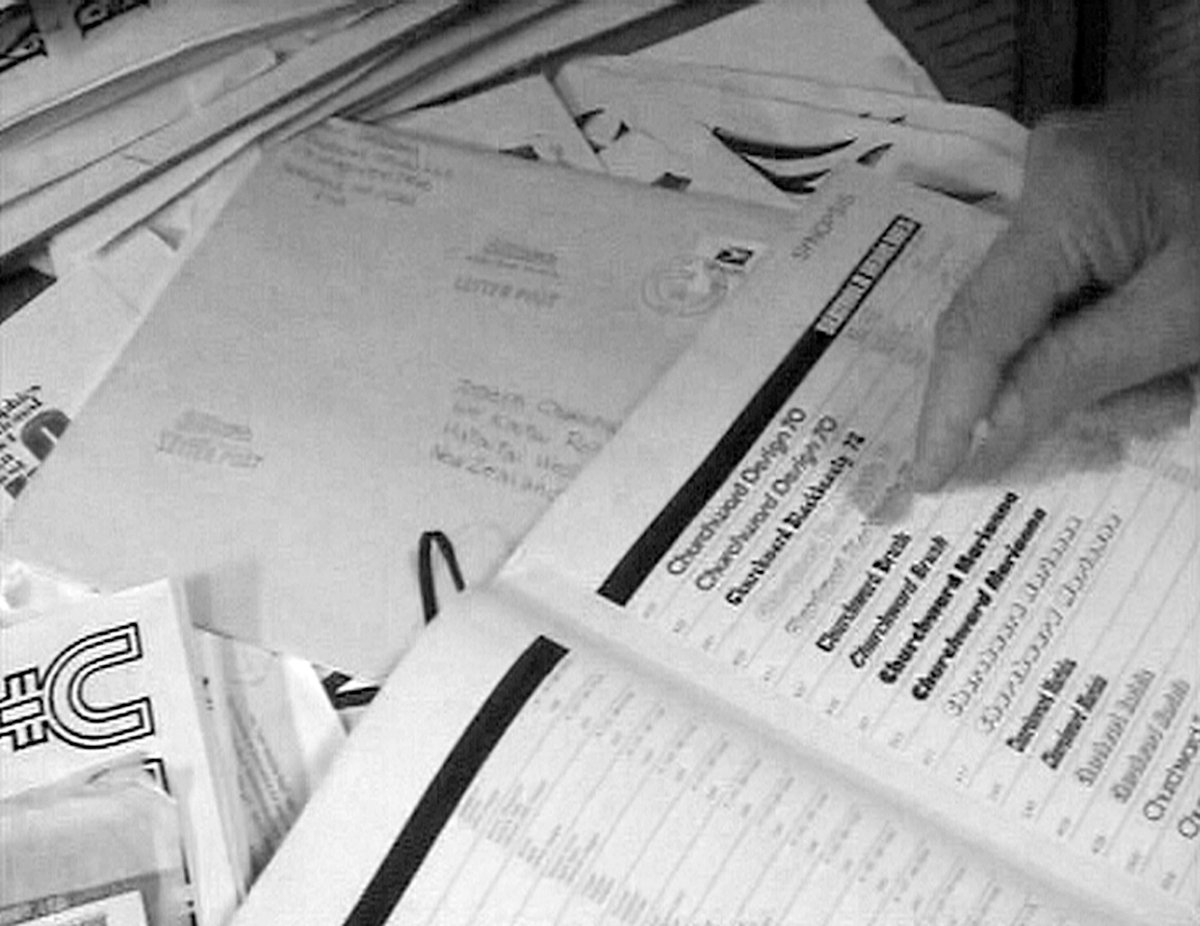
URW—I caught them out. My nephew found them on the computer and I never had a contract with them. And they had been using—I think they pinched it from Berthold—‘Churchward Brush’.
You never had a contract with them?
Now I have. But I had to force them to give it to me.
Cultural aspects, fitting in
[#2 57:15 image / text #3 27:20]
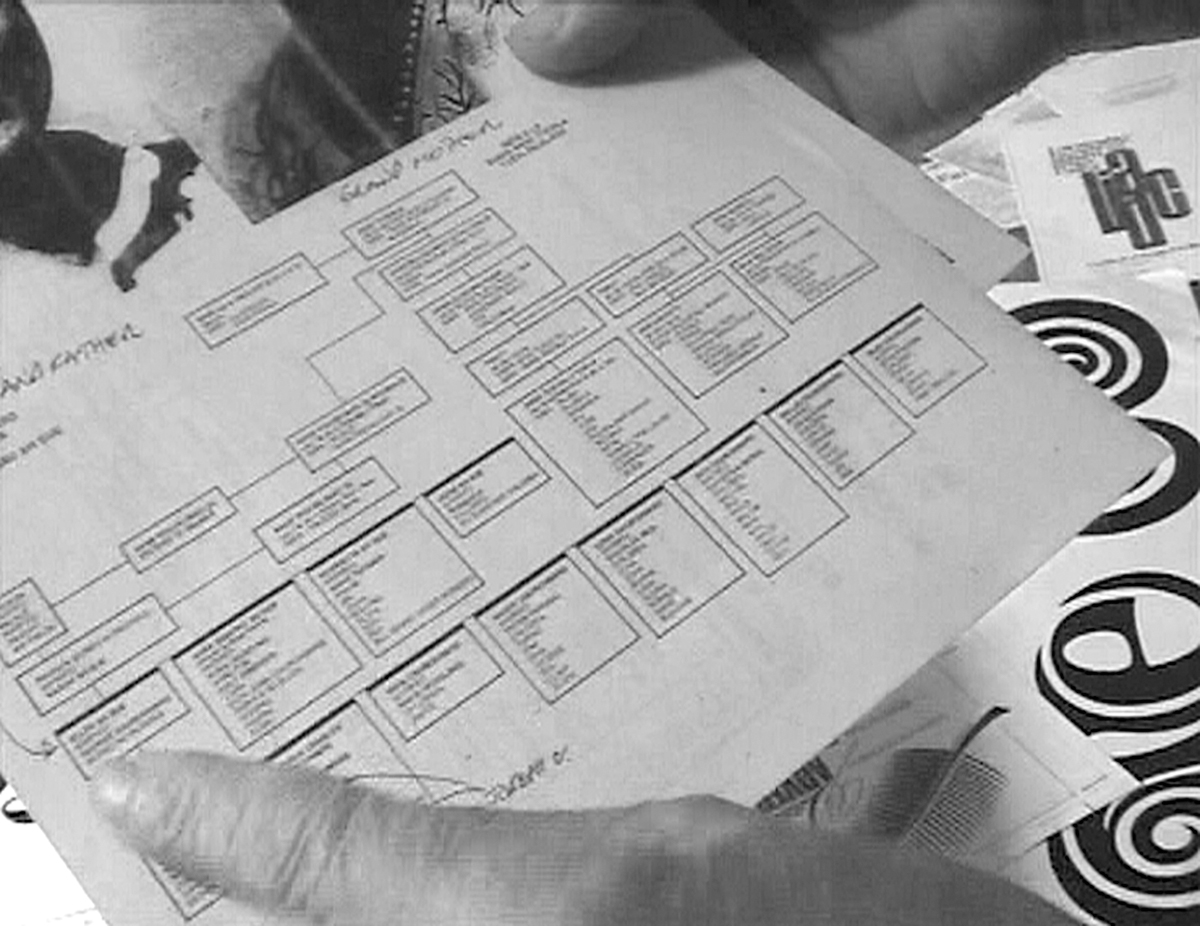
One thing I think is really interesting in your story is your family tree, having all these different cultural ties. Do you find it hard to move between these different cultures?
You grow into culture. When I went back to Samoa I came with relations from the Coe side and they couldn’t speak—they were too ashamed to speak Samoan. In my first few weeks in Samoa a few Samoans were talking bad about me around my [grand]father and there’s a word ‘Fia palagi’—means you want to be a Pakeha. I had to speak Samoan immediately to fit in. I didn’t teach my kids Samoan at all, my reason is, when I was a young fellow I was hanging around with English people and some of them didn’t take much notice of me because I had a Samoan accent. I’d go from group to group and no-one would pay much attention to me. My son, who works for Saatchi, he says ‘Dad, thank you very much for not allowing me to speak Samoan’.
Really?
Because now he goes from group to group and he takes over.
Do you think there is a stigma if you have a foreign accent.
Yeah, I think so. I experienced it myself.
Did you find that when you were working as well?
My staff and clients were very good to me when I had my company. They treated me as a boss. Mind you my English staff respected me because of my English side.
Yeah, you were saying Charles Haines reminded them of that pretty quickly.
Now when I talk Samoan, the Samoan people get a bit of a shock. When I was in Samoa they thought I was either a Pakeha or a Chinese and when I spoke Samoan to them they said ‘Where did you learn Samoan from?’ and I said ‘I was born here’—and they would get a shock.
Differences
[#1 3:04 image / text #3 65:15]
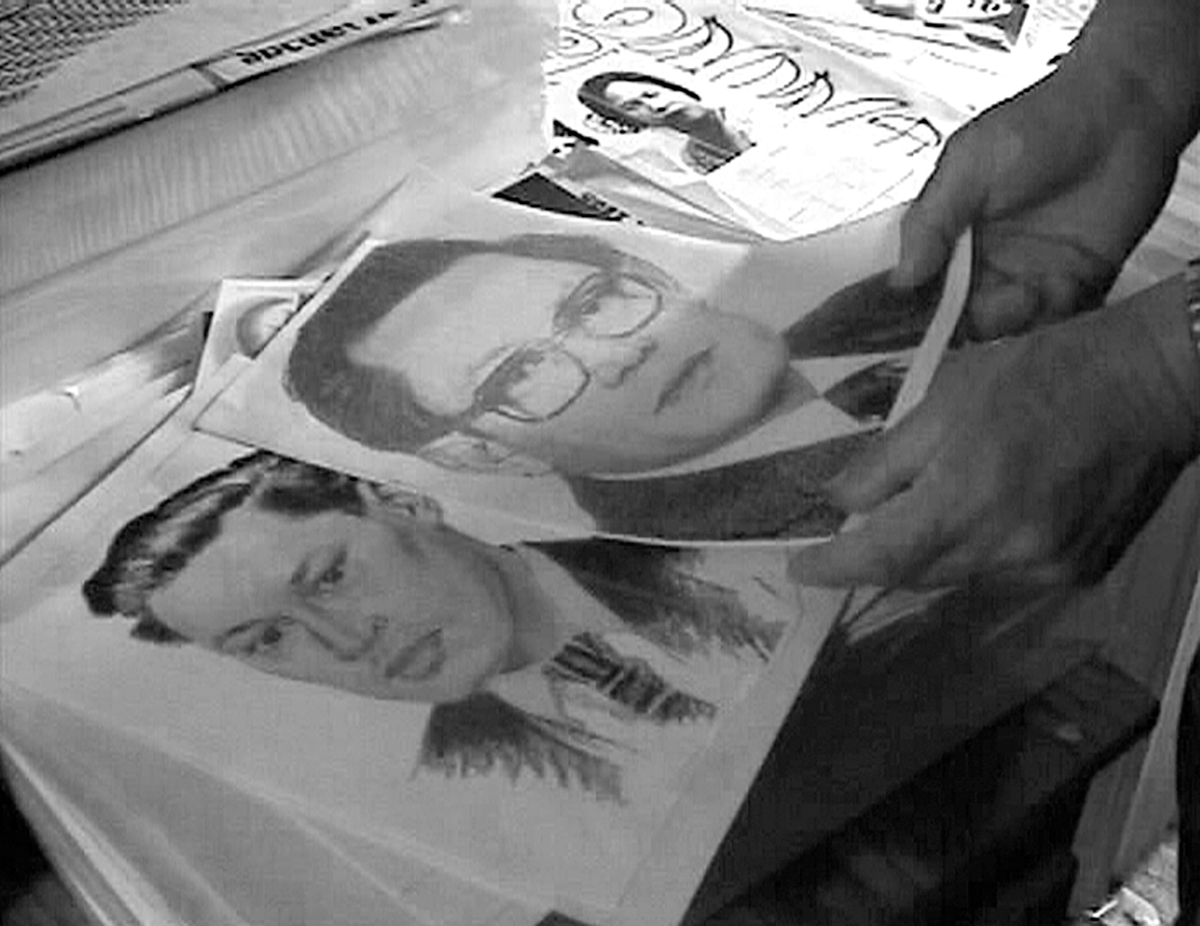
Do you think there is a difference between the work you do now and the work you did then, for example, the work you did at Charles Haines—do you see it differently?You could be right. At that stage I was trying my best, but I’ve retired now. Although when I get fed up I go and do some gardening…
Digitisation, feedback
[#1 56:30]
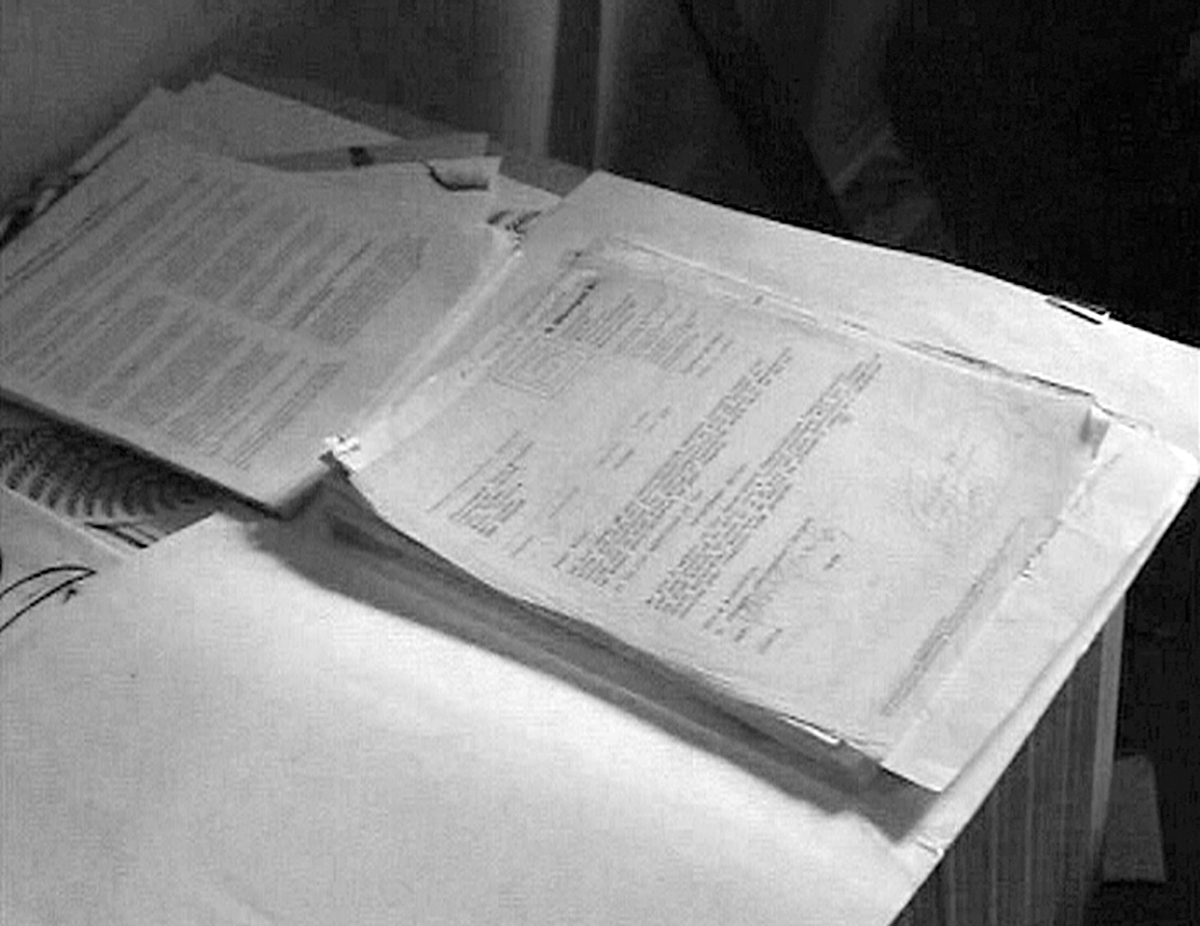
When you work with type companies like Bluhead, do they send you copies of what they are doing to check that it is OK?
No, they just put it into the computer. I haven’t seen the progress of my designs on MyFonts for a long time, I don’t really know what’s going on.
Digital
[#4 0:52 image / text #3 0:00]
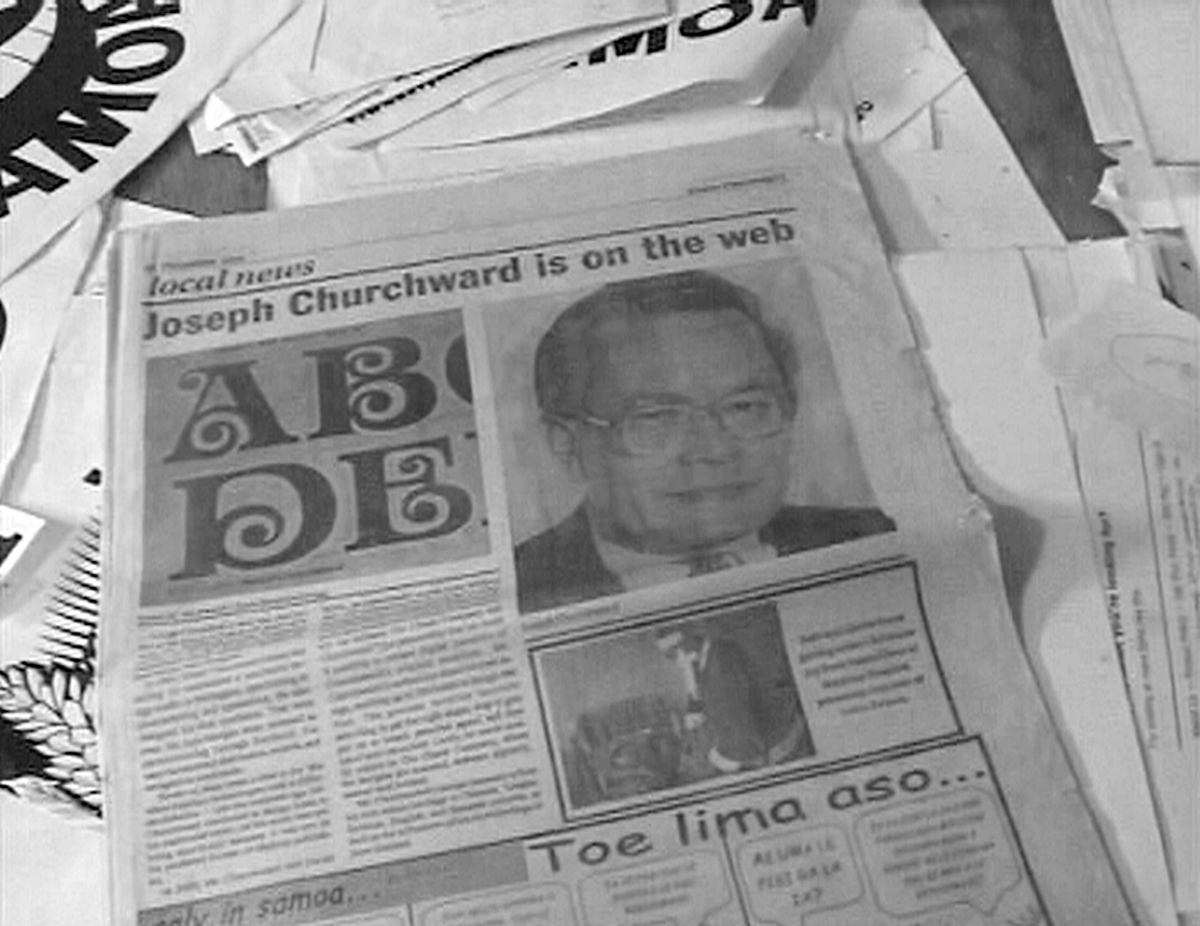
Have you ever considered, when you are designing your alphabets, that they would be used on a screen or in a digital medium?
No.
‘The computer is the enemy of Joseph Churchward’—is it?
Well I hate it because it cost me my business because I wasn’t interested in the Apple Mac. I had a computer from Berthold (for typesetting) and it was enormous, took 10 people to carry it, and it cost me 150,000. And when I collapsed they sold it for 40,000. But, this machine couldn’t do what you can do on the Apple Mac—you can do all your artwork there—no paste-up. I was so disappointed, I turned my back completely on it.
What do you think about the studio process? Is the time it really takes to do stuff actually helpful for making a work good?
Well, some work it doesn’t take so long, it’s very quick. I shouldn’t say this but I’ve heard now from certain people that they are getting brassed off with computers now. And the reason is, if I have to draw something like that [draws a curve in the air]—now I’m telling people this is my computer [pointing to brain]—what I can do quickly with my hand can take a long time on the computer.
People are out of the habit of making those forms by hand.
Mind you, the computer is terrific for other things.
Yeah, I laugh when I see people trying to make images look like they are photocopied using the computer, when they could actually just photocopy the image... It’s a thing we think about quite a lot because we were never taught to do hand pasting and hand setting. So, you could say, the relationship for us is quite different.
I’m so used to pasting up letter by letter.
The belief is that it takes a longer time to learn your materials, therefore you understand them a lot more. Whereas with a computer the idea is that it speeds everything up.
There aren’t many people similar to me left. When I’m gone it will all be computer people.
Nah, everyone will go back to handlettering again. It’s like Finnegans Wake…
Digitisation, first attempt
[#1 27:23 image / text #2 60:00]
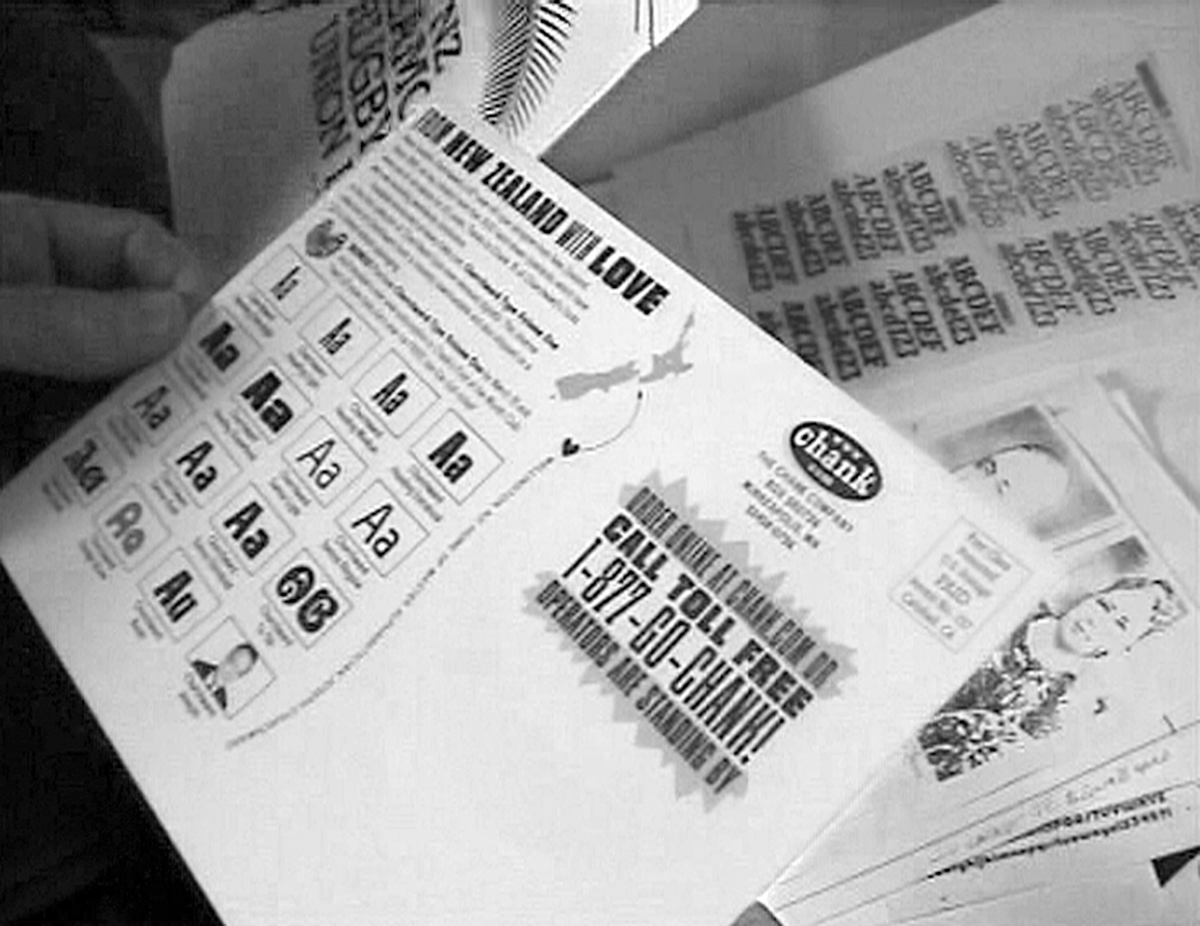
This was from ‘Chank’ of America.
How did they find out about you?
This fellow I split up with—David Buck—I got annoyed with him aye. They had an argument, I had a feeling it was a fight about women, because he brought an American woman back here. He also bought all my alphabets that were with Chank.
David Buck contacted you because you knew his father right?
No. It was through Ramsey Margolis, Ramsey brought him here, he wanted to handle my alphabets… he took my nephew for a cup of coffee and asked him if he could buy a big machine to make fonts for the both of us... And then he brought this fellow David Buck and said ‘I’ve got somebody who might be interested in fixing your fonts [for the computer]’. When I collapsed I lost all my connections in Germany. The minute David got in he said ‘Joe you went to school with my uncle, Don Buck’, so straight away I said ‘Right—You and I’.
How did Ramsey know you were a type designer?
When he first came here he bought a woman that was friends with my daughter and he said my daughter told this woman that I designed typefaces.
Had you had contact with Chank before this?
I didn’t even know Chank, but David Buck came over for a holiday—he was working for them. And once again—it’s so stupid—the thing that got me annoyed when he had a fight with them—he came back and got me involved with MyFonts immediately. Now, the thing that annoyed me was that he pinched all the originals of the fonts from Chank. He made them while he was earning a wage, he was being paid to make the fonts. Then he brings the fonts here—the originals—and then when he put them into MyFonts he wanted a percentage of the earnings. I said ‘You have already been paid to make those, why do you want a percentage from me?’ Then I discovered a few other crooked things he was trying to play.
Does he [Buck] still have your original drawings?
Marianna, my daughter, went and got them. When I got mad I told Marianna the address, and it’s funny, Marianna went there and came back with three bags full of my alphabets.
Why do you think he just gave them to her?
I don’t know.
Employees, apprenticeships
[#2 38:39]
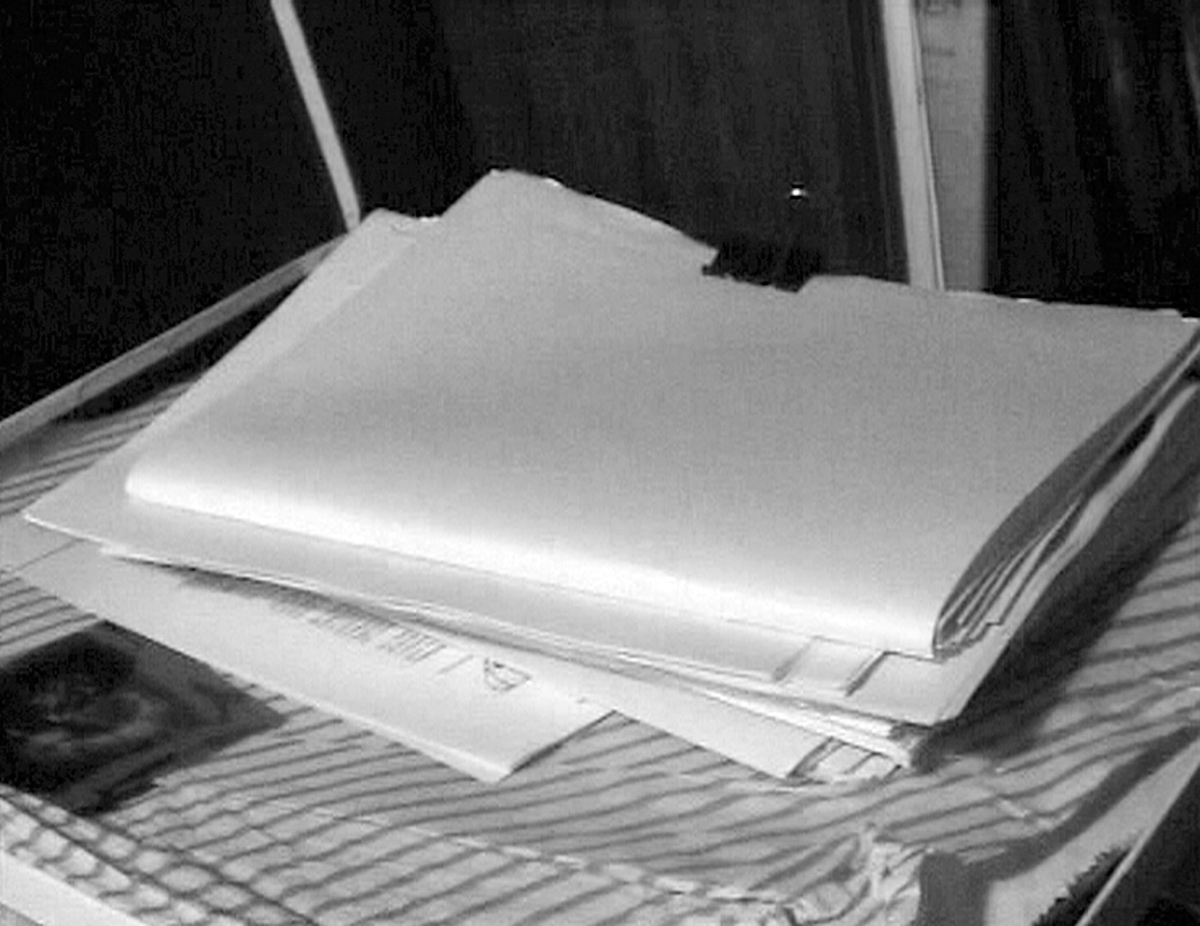
You had a good relationship with your staff?
Yeah, not only would I give them the weekly party, but when I’d get big cheques I would give them a percentage.
Did you do apprenticeships?
I had a few apprentices but every now and again I’d take on the old people—nobody wants them.
Where were those older people from?
There was one Swiss fellow; his name was Karl. And one of my grandsons is called Karlos after him… Marianna’s son. She just added on ‘OS’ because I had a typeface called ‘Karlos’.
Employees, female
[#4 03:30]
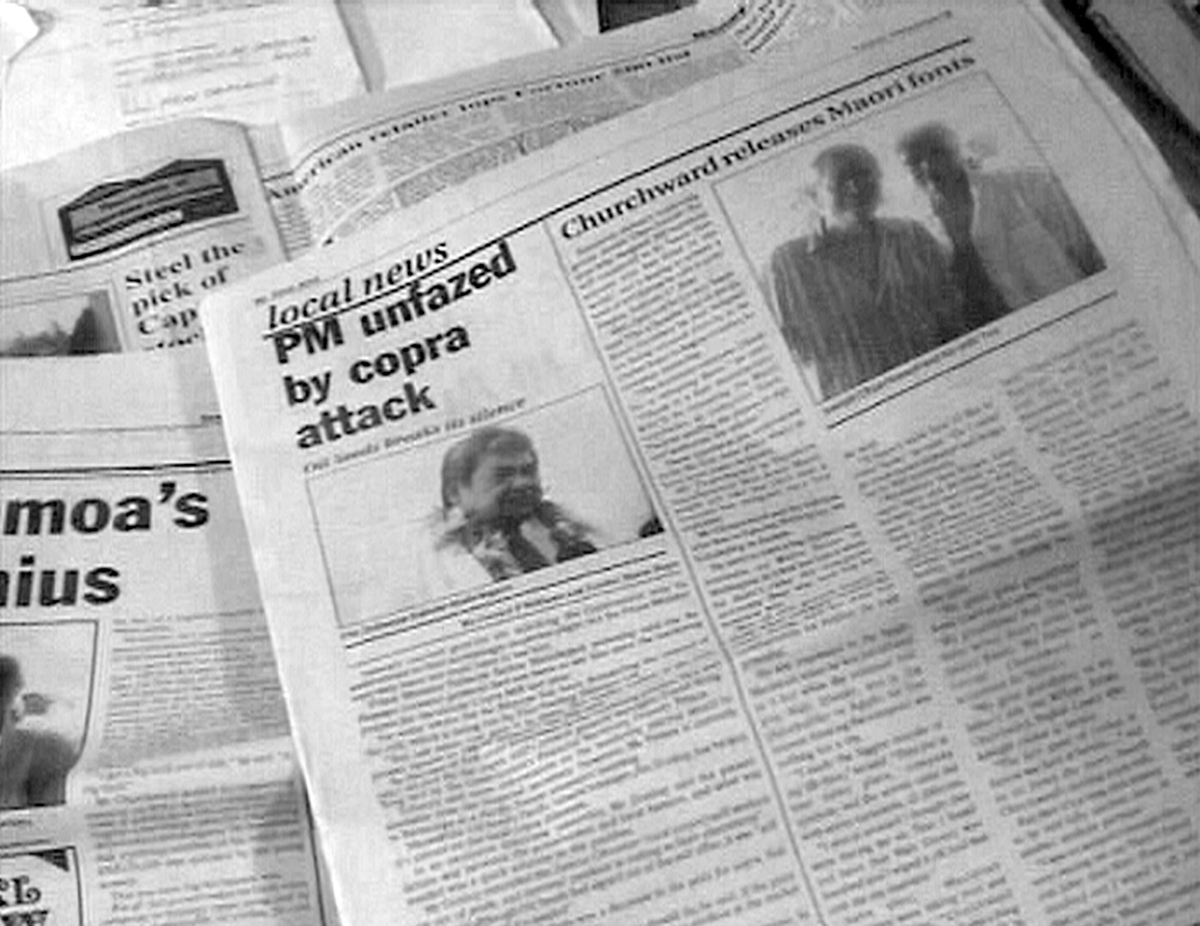
You said your daughters were working for you when you had your business—were there any other women working for you?
Yeah, there were plenty of them, they came and they went.
Were they working as finished artists as well?
No, they were typists. My daughters were typesetters, Marianna was a typesetter. We had finished artists, proof-readers, typists… lots of different jobs.
Ethnic Art International Studios
[#1 91:21]
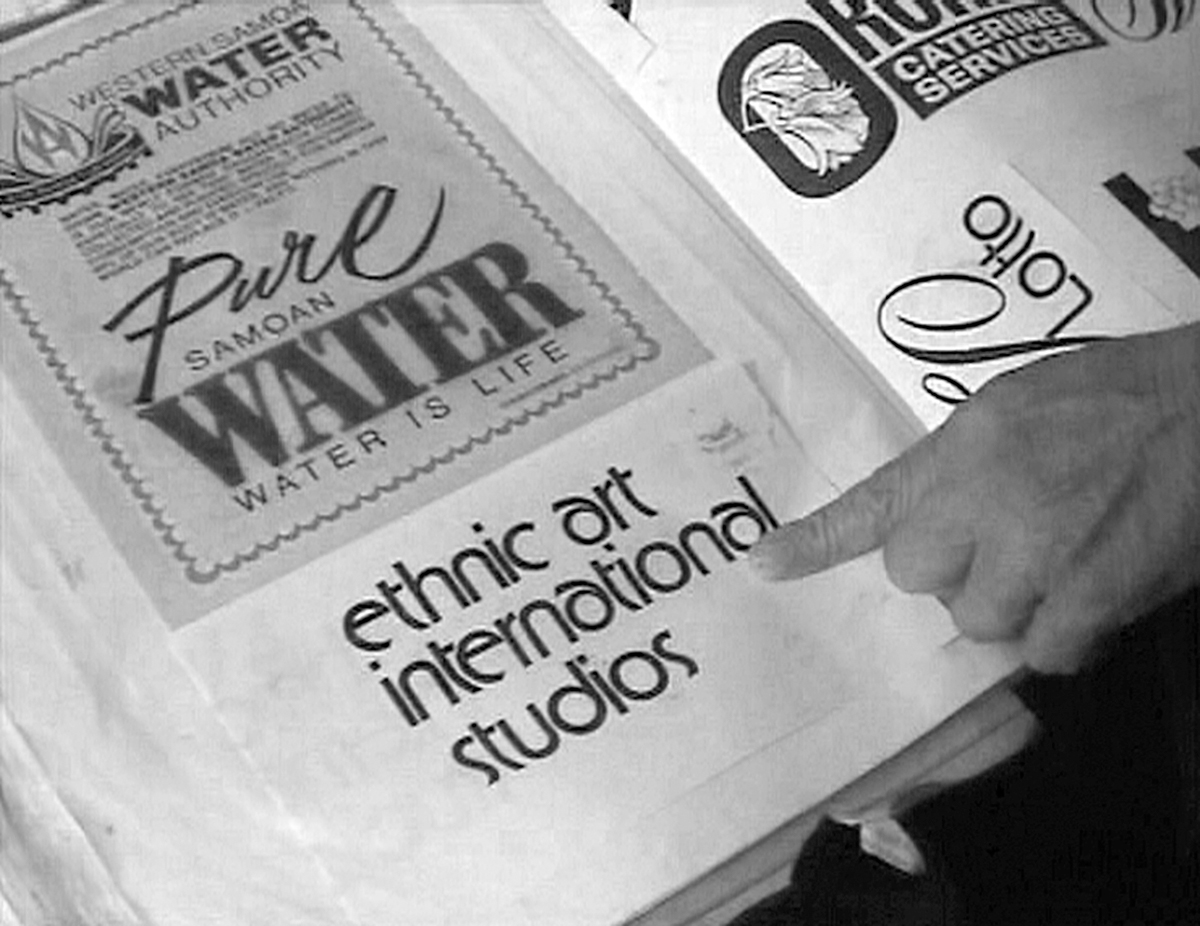
What was this for?
I did this for a client overseas. I’ve forgotten where. I did it before I went back to Samoa, but I held onto a copy—I want to start an alphabet from it, but I never got around to it.
Family photo, banking
[#3 8:39]
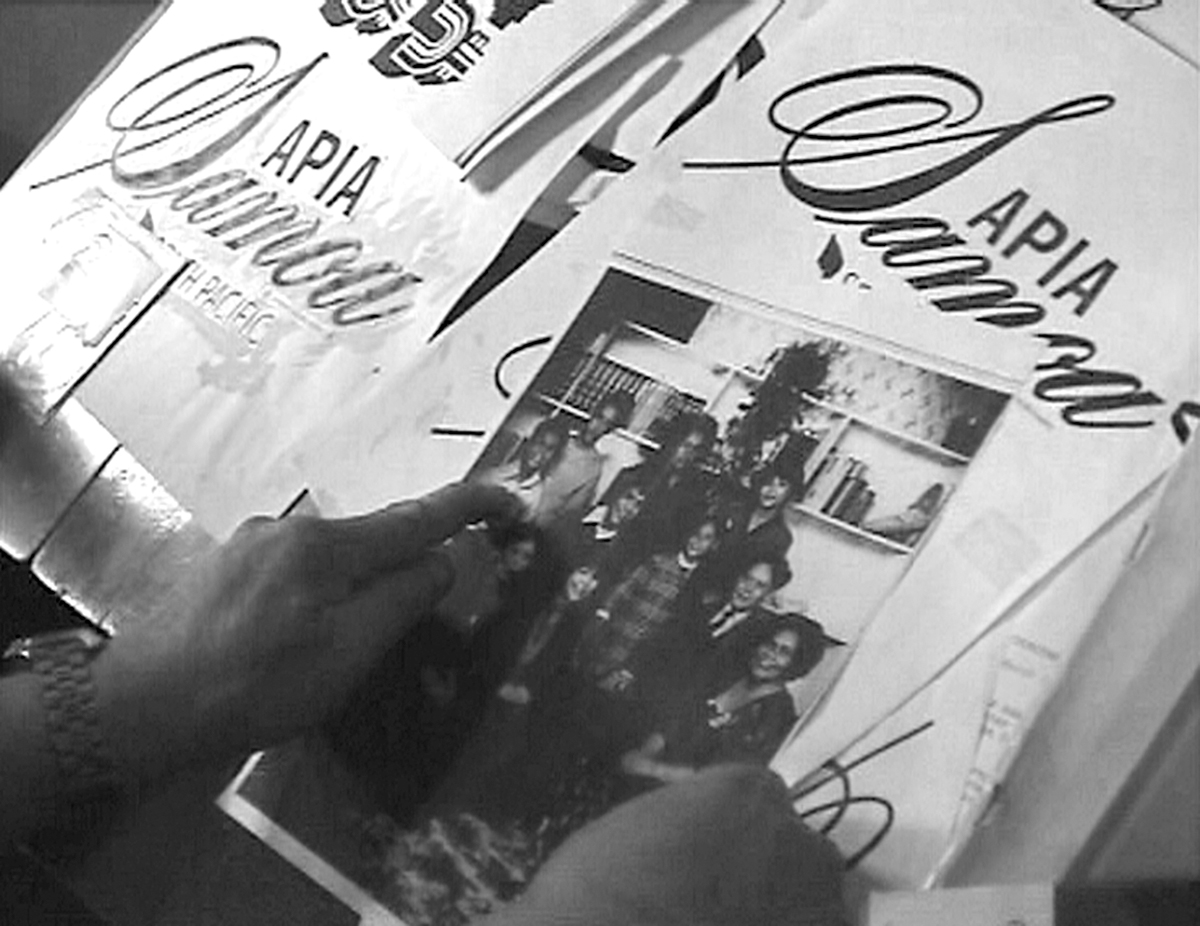
That’s Marcia, that’s Marianna, there’s Georgina, there’s Joe [Jr.]—Saatchi and Saatchi. We’ve lost this one, his name was James, that’s Paul—he’s the printer. That’s my wife, and that’s the little fellow [pointing to himself]. This was taken in Levy Street. We used to live behind the Embassy theatre. I had a beautiful house there. It was owned by a German and he wanted 25,000 for it. I said ‘I’ll give you 20,000 for it’ and he says ‘Give me 23 and it’s yours’. And you know they’ve been selling it since we lost it. It’s now worth nearly 1,000,000 dollars. And you know who took it off us—the bloody bank. I changed my bank from BNZ to ANZ; it was ANZ that killed me. I spent most of my life with BNZ. I’m back to them now.
Finished, suggestions
[#1 30:45]
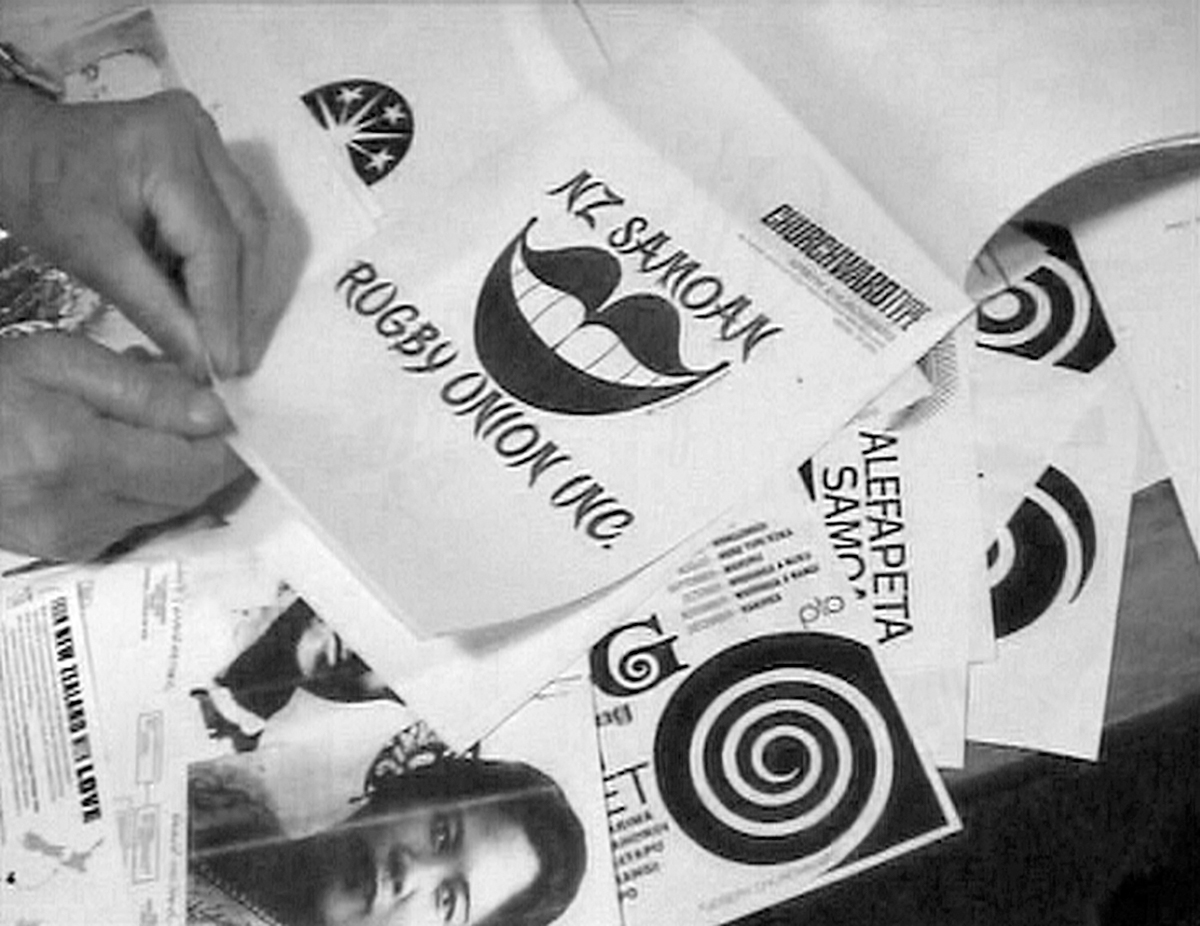
How do you know when something is finished? Do you like to propose a lot of different variations?
They are all suggestions – I call them suggestions – and they have to pick one.
First letter, hardest letter
[#2 19:09 image / text #3 04:00]
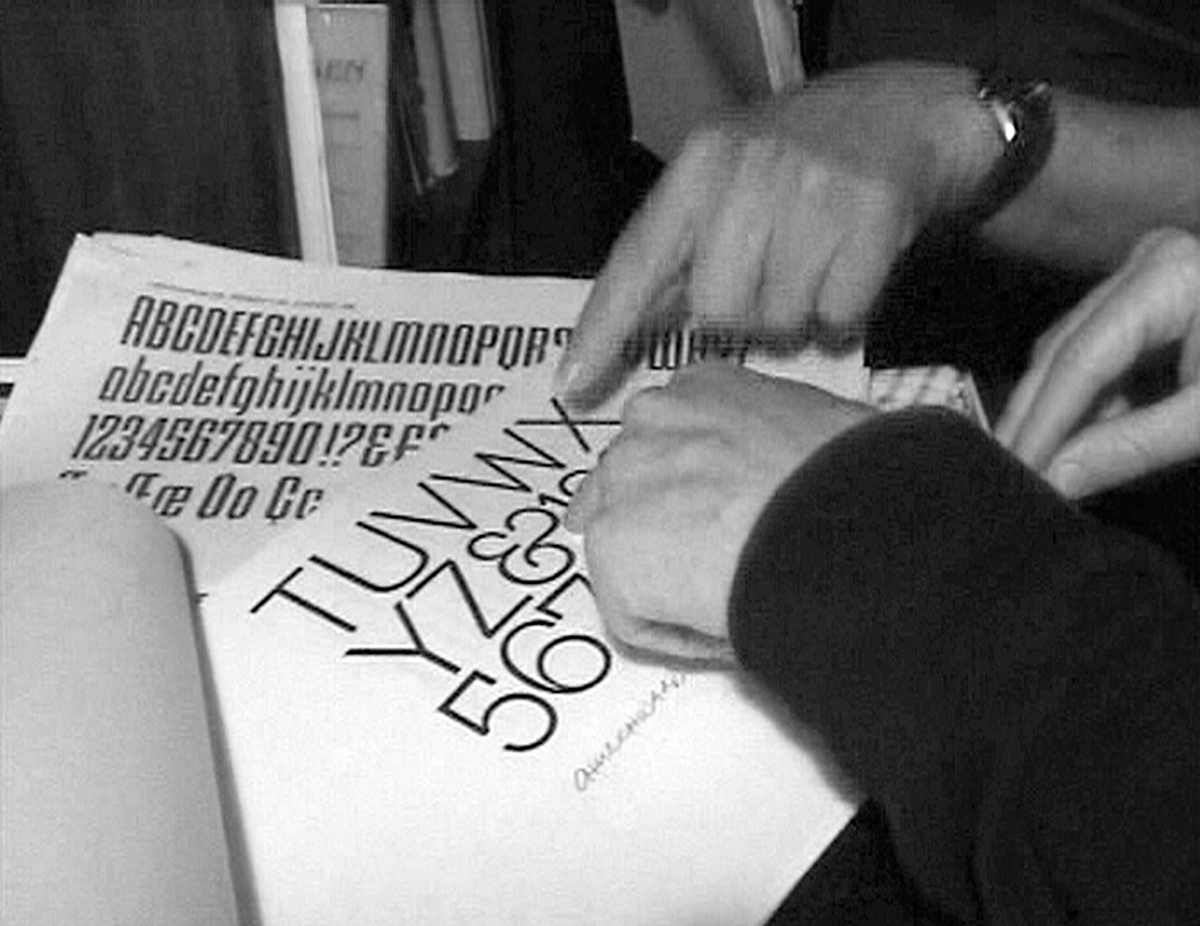
I design one letter and I think of half-a-dozen others.
I think there’s always that temptation to design the whole alphabet as well—to make a complete set. Do you have a letter you always start with?No.
What’s the hardest letter for you?
Sometimes an ‘M’ is really hard.
One of the things I really like about your typefaces is that when you get to the ampersand you always do something kind of expressive with it—like a flourish.
It’s there. You just have to find it.
First business card
[#1 97:03]
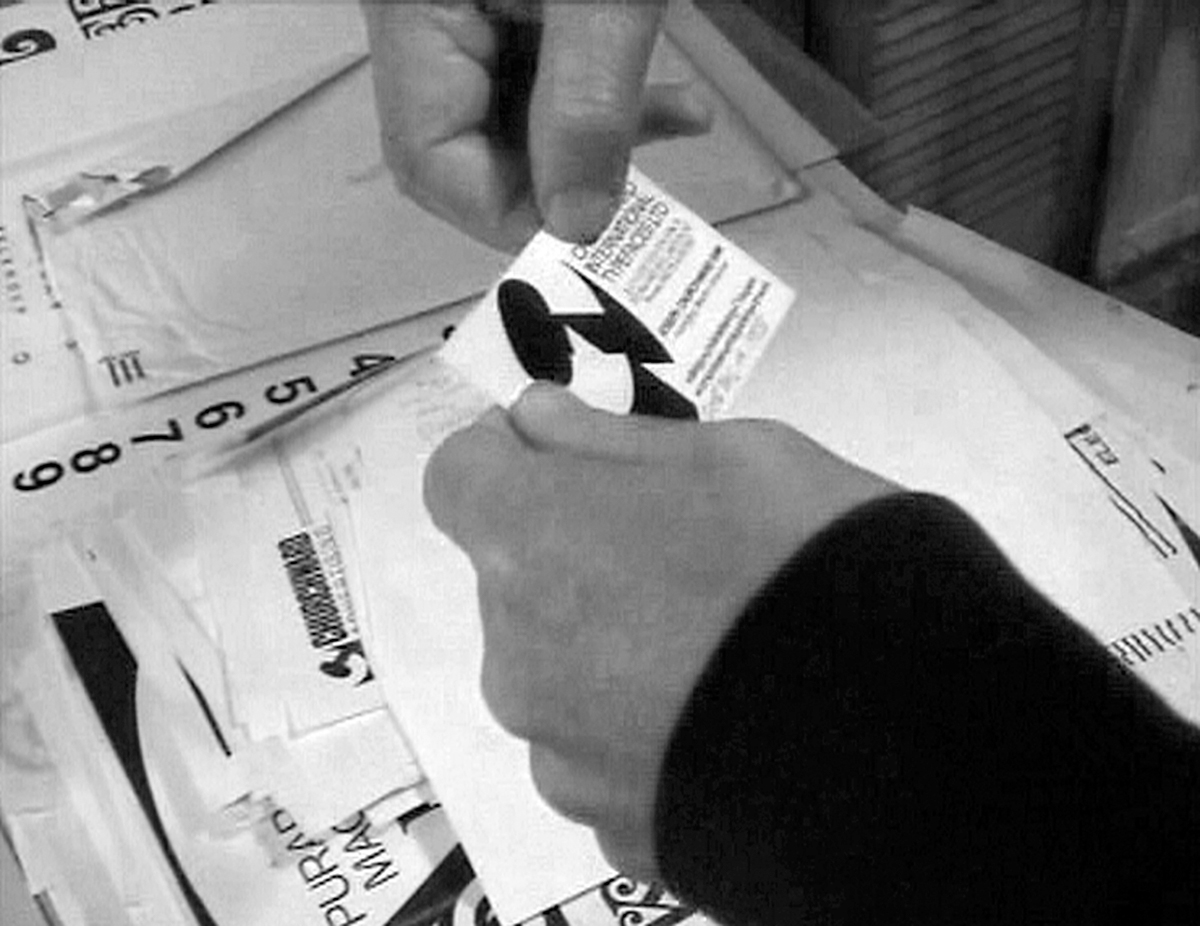
First drawing instrument
[#2 08:42]
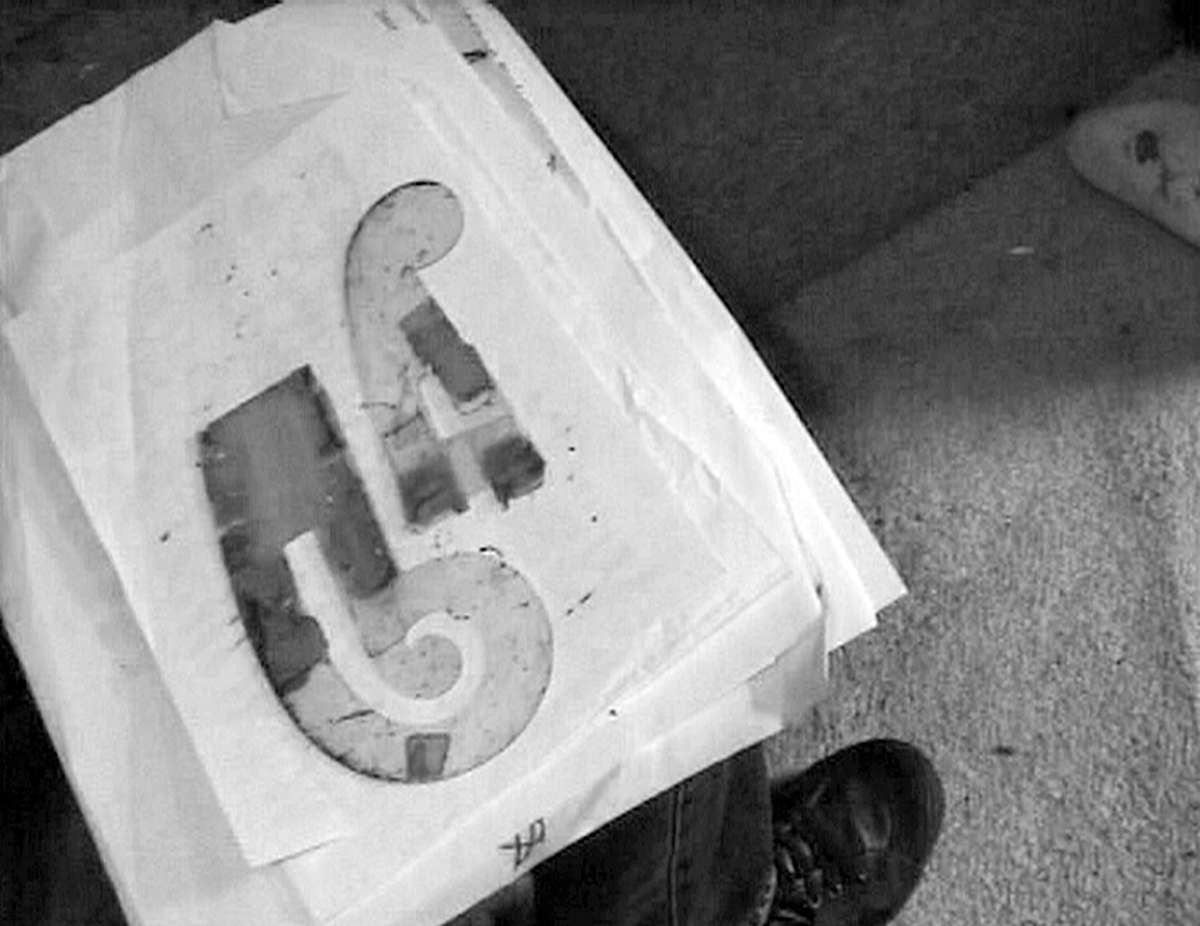
Look, I still have this—my oldest instrument—that I first got when I started work at Charles Haines. The poor thing has fallen apart. I used it all the time. It’s worth a lot to me. That’s the first instrument I bought when I left Wellington Technical College. It’s broken, I bashed it up, and I’m still using it!
That’s amazing. Looks like there’s been a hole burned through it here…It’s over 50 years old.
It’s like an artefact.
Fixing or remaking typefaces, cooking
[#2 65:01]
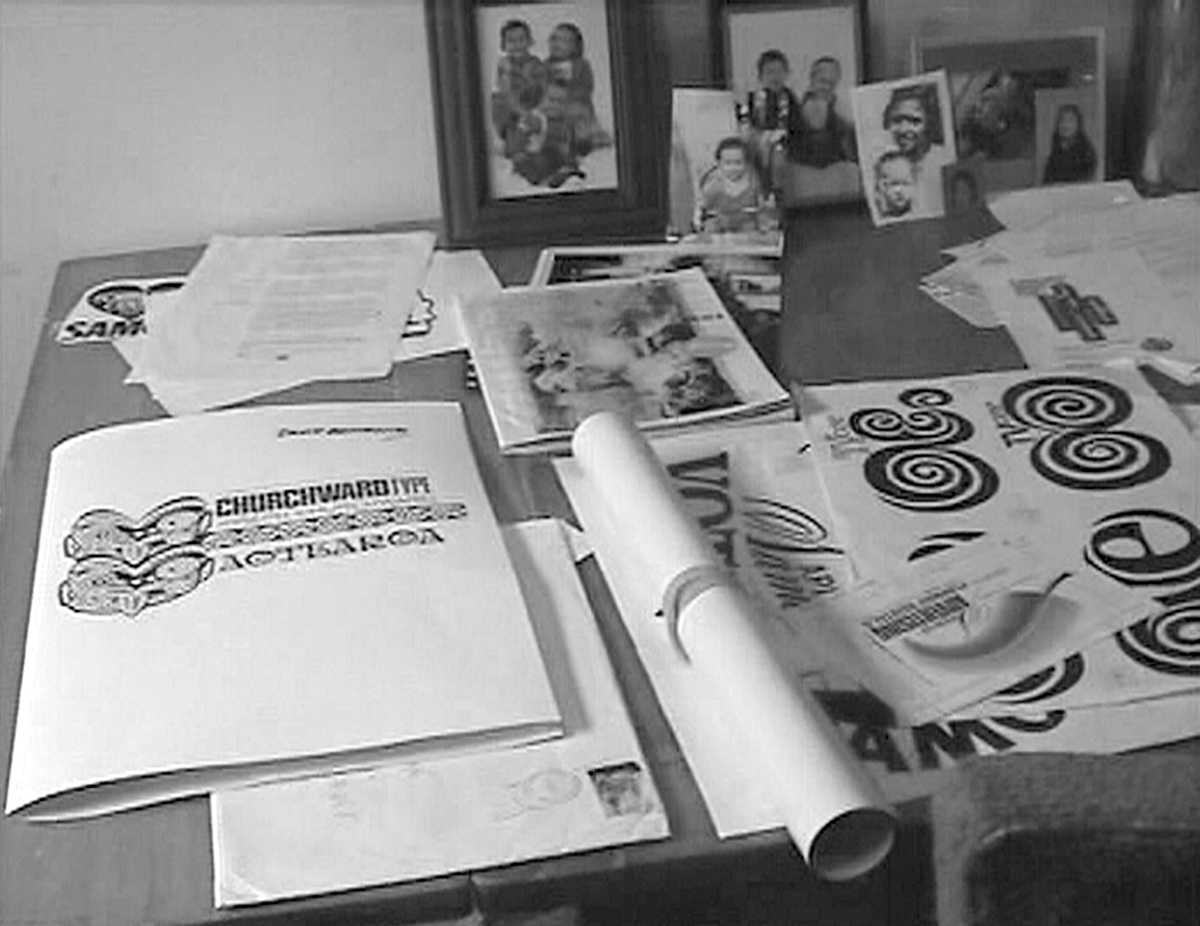
You were saying that you would see other peoples typefaces on the TV and they weren’t working—perhaps made by amateurs—do you ever think about fixing them or remaking them?
No, I’d rather go my own way. Actually, sometimes I see half-a-dozen letters, and I can do it better and do the whole alphabet based on them. There are suggestions everywhere. All I need is half-a-dozen letters and I can make up the rest.
Do you like wandering around town?
Yes, but I prefer to sit down and do my work. Once a month I go down to Woolworths to buy my shopping. I make my own meals.
What’s your favourite food?
I just discovered something. It’s a little rice cooker; it’s called ‘3 cup cooker’ and you just put rice in, push a button and forget about it. I put all sorts of different things in and heat it up. Every combination is a recipe—so much of this, so much of that… It becomes a recipe.
Cooking is like design isn’t it? It’s a similar process, you’re designing the meal.
It’s an art—dancing is an art, cooking is an art—and perhaps flirting is an art.
Well, we’ve been led to believe that.
Flamboyant
[#2 90:45]
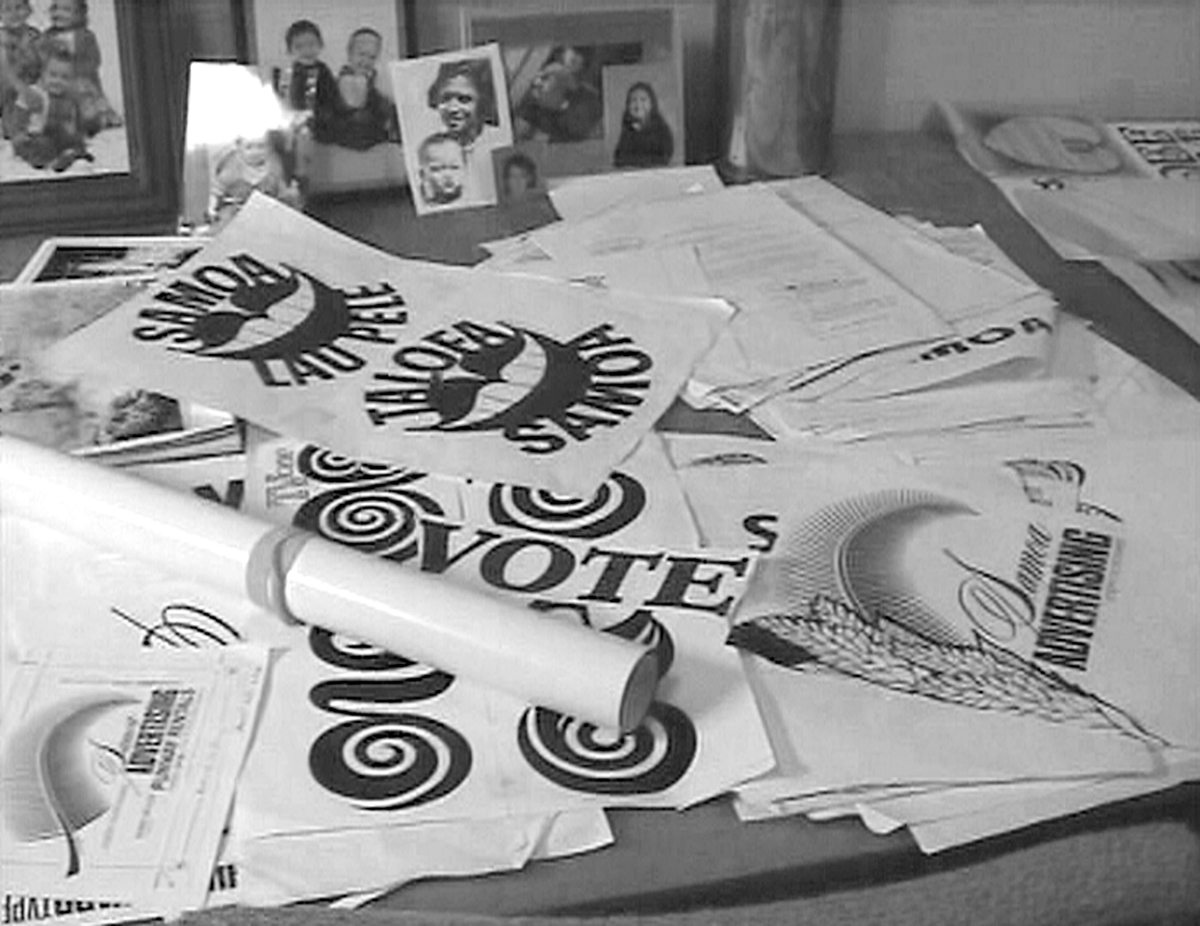
With all your stories, somebody might describe you as being flamboyant—what do you think about that?
[Laughs] No, that’s just my Samoan talk.
I was just wondering because when you look at the typefaces, the personality that you add to them, those little flourishes seem quite flamboyant as well.
Well probably. It’s probably my Samoan talking going into it…
Fred Dagg, studio
[#1 55:36]
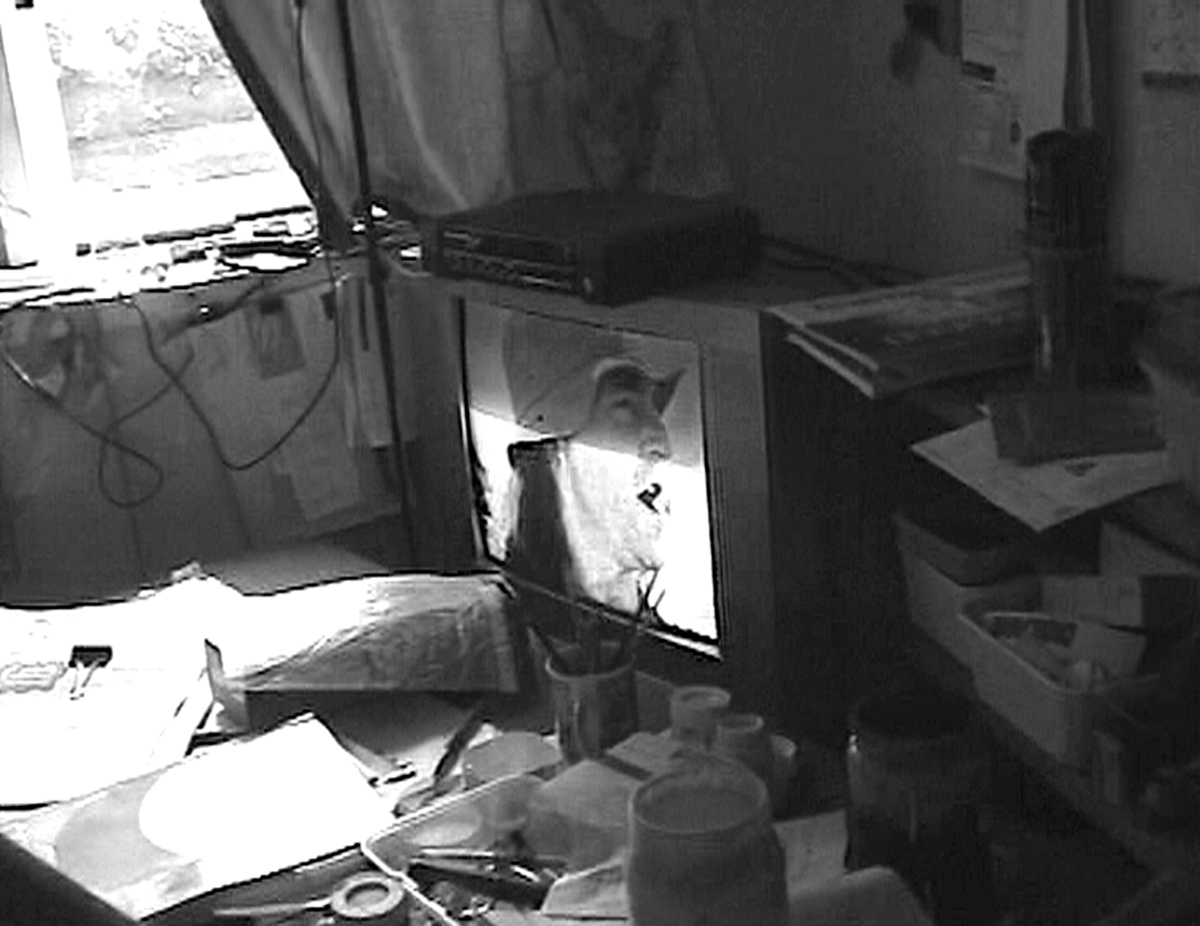
Future, of letters
[#2 79:11]
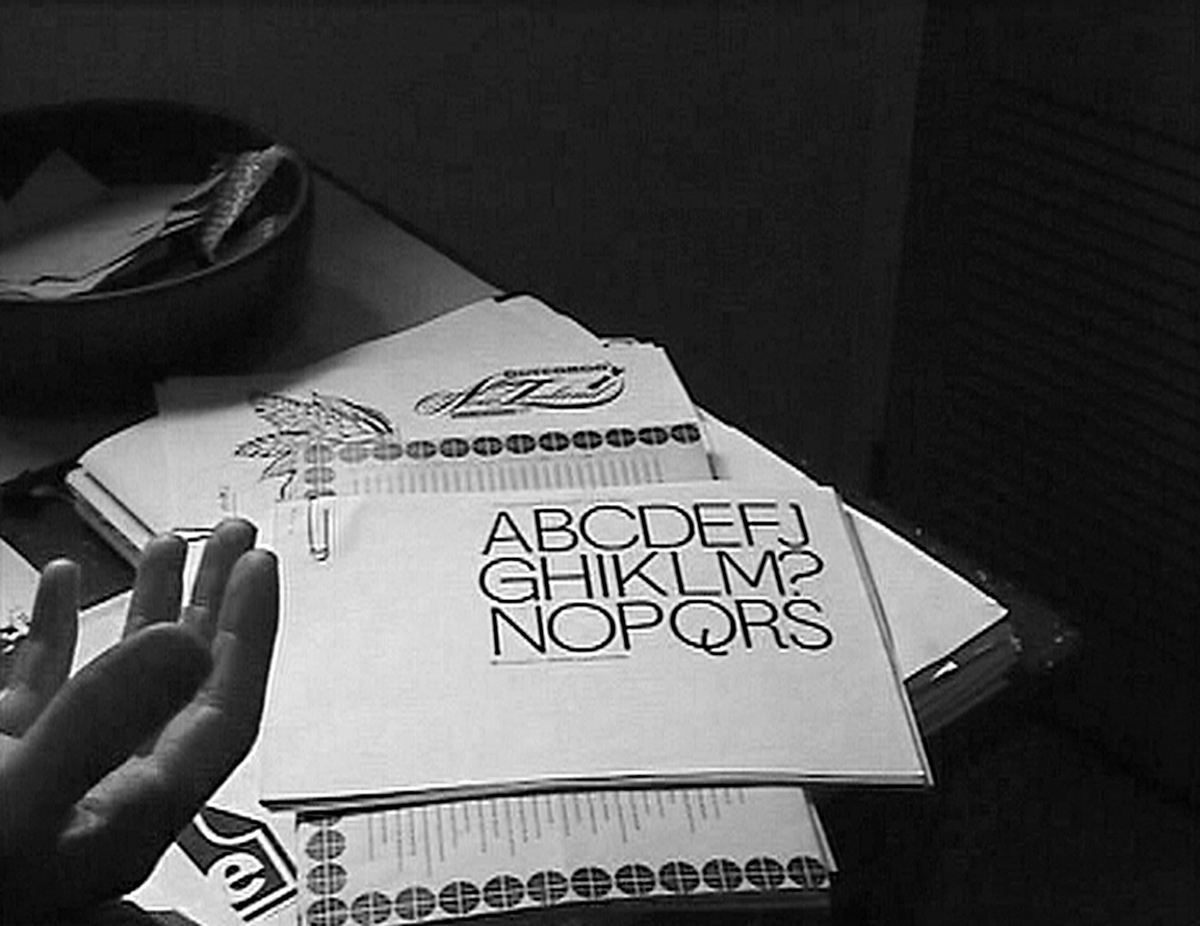
What do you think is going to happen to letters? Do you think letters will keep changing? Or will they stay as we know them?
Well, this is the only way we can do it. 26 of them—the ones we are familiar with. The only method is to find another way of contacting one another.
Do you think letters might become extinct? Like vowels… or, do you think we need 26 letters?
Once we forget about the alphabets then we are going back to being monkeys again. But also the only reason why we make a word is so we can remember it.
We make letters for history?
We can keep a track of things we’ve said or done. Before the Roman alphabet it was just ‘blah, blah, blah' [oral histories], or pictures [hieroglyphics].
Gardening
[#1 7:32 image / text #3 65:00]
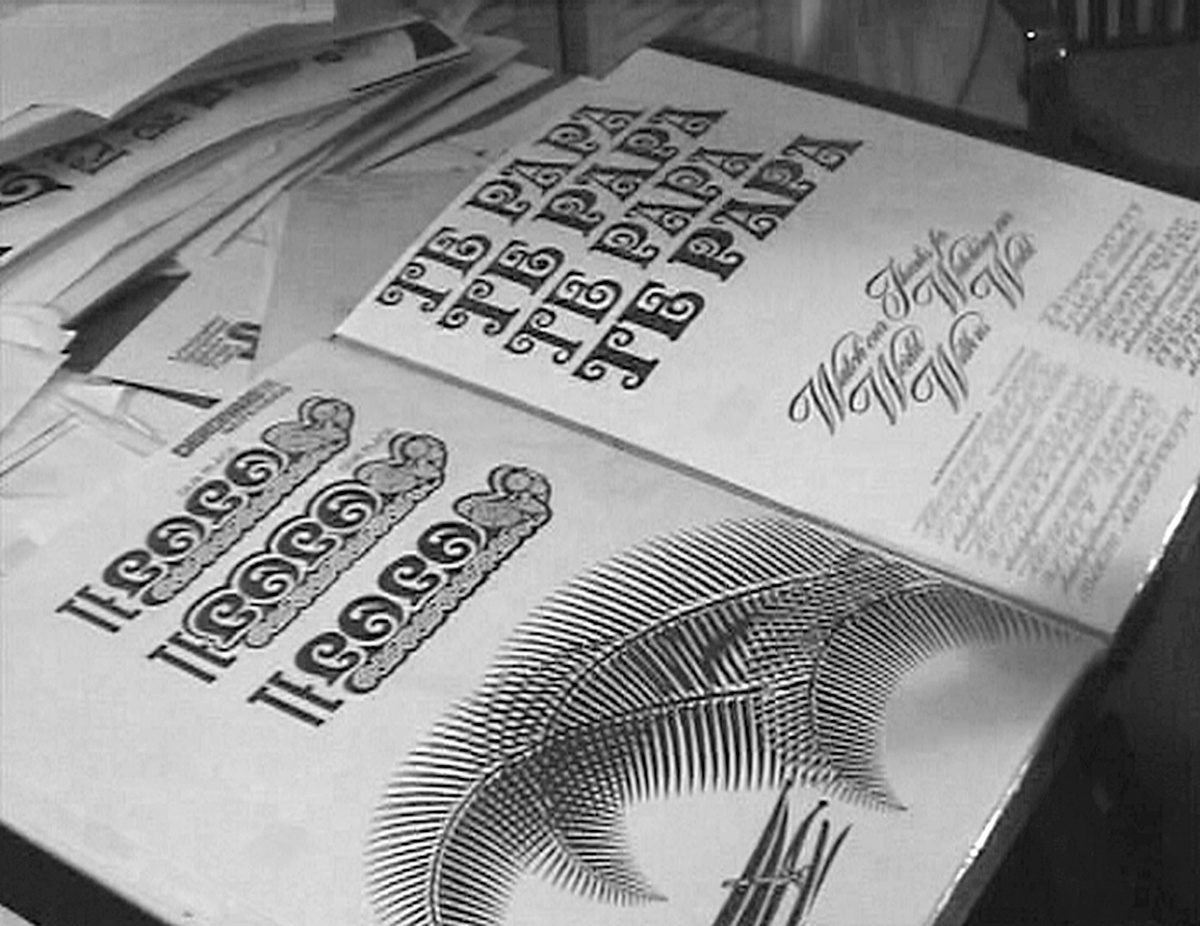
When I get fed up I go and do some gardening. I can feel someone pushing me inside and they say ‘Do the bloody work!’ Perhaps it’s my Chinese side that’s pushing me. Chinese ghosts. Well, they are all very hard workers aye? I always get that, as soon as I get brassed off—even when I’m out gardening—I can feel somebody saying ‘Get back to your alphabets’. Perhaps it’s the right thing.[…]
[#1 69:15]
What sort of gardening do you like to do?
My grandfather was a gardener but he had no money—I heard people say my grandmother bought him. She was a wealthy Chinese woman. The Germans taught him how to plant and he always told me ‘When you take a branch off a tree and you want to plant it, put it straight in’. There was an enormous hedge there [pointing outside]. But it started to grow through the windows, that’s why I chopped a whole lot off. Now I’m starting to plant creepers. I’m only doing it as a pass-time.
Gift, school
[#1 84:43]
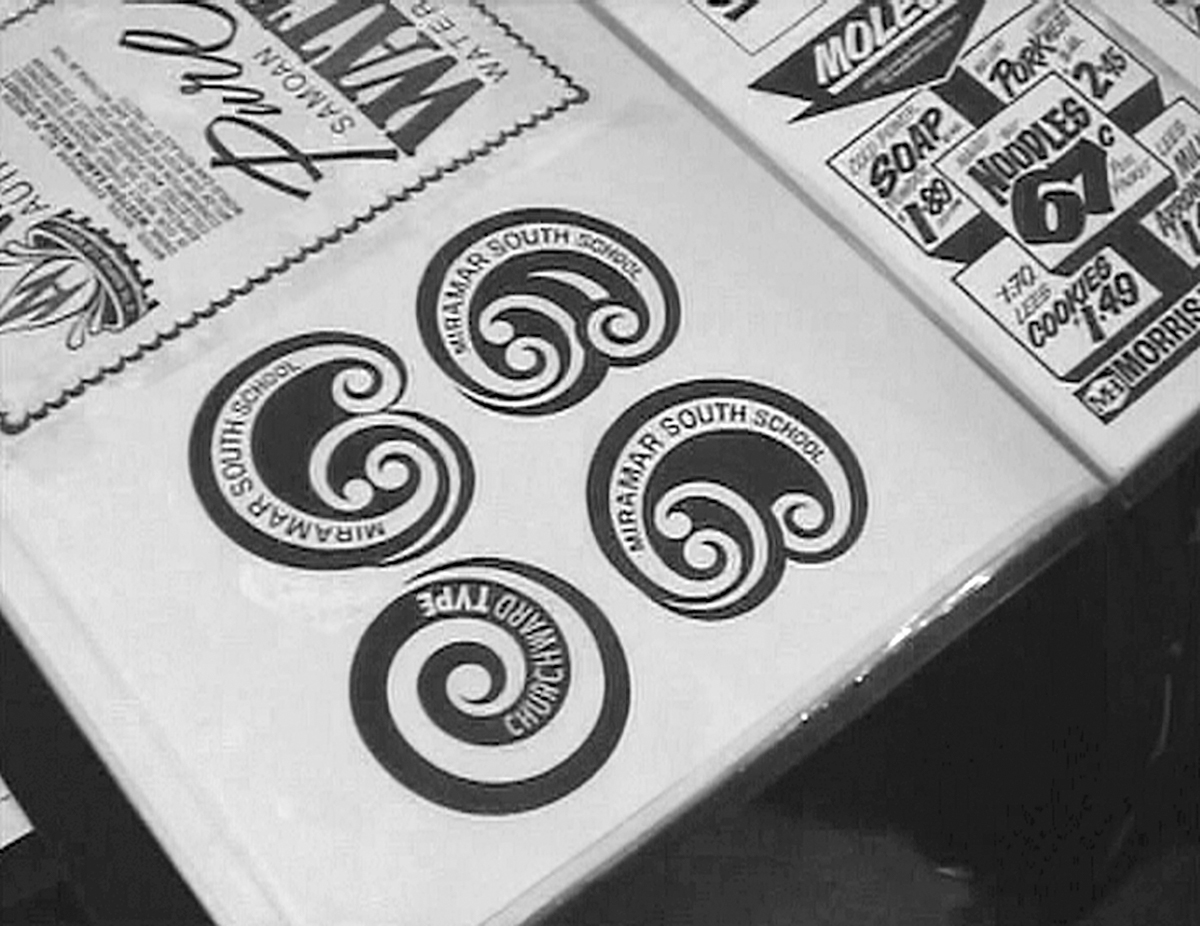
When I came back from Samoa, I did this for my old primary school [Mirimar] for nothing. My gift to them.
Did they use one of these?
Yes, they were using it.
Going to Auckland by train
[#1 84:43]
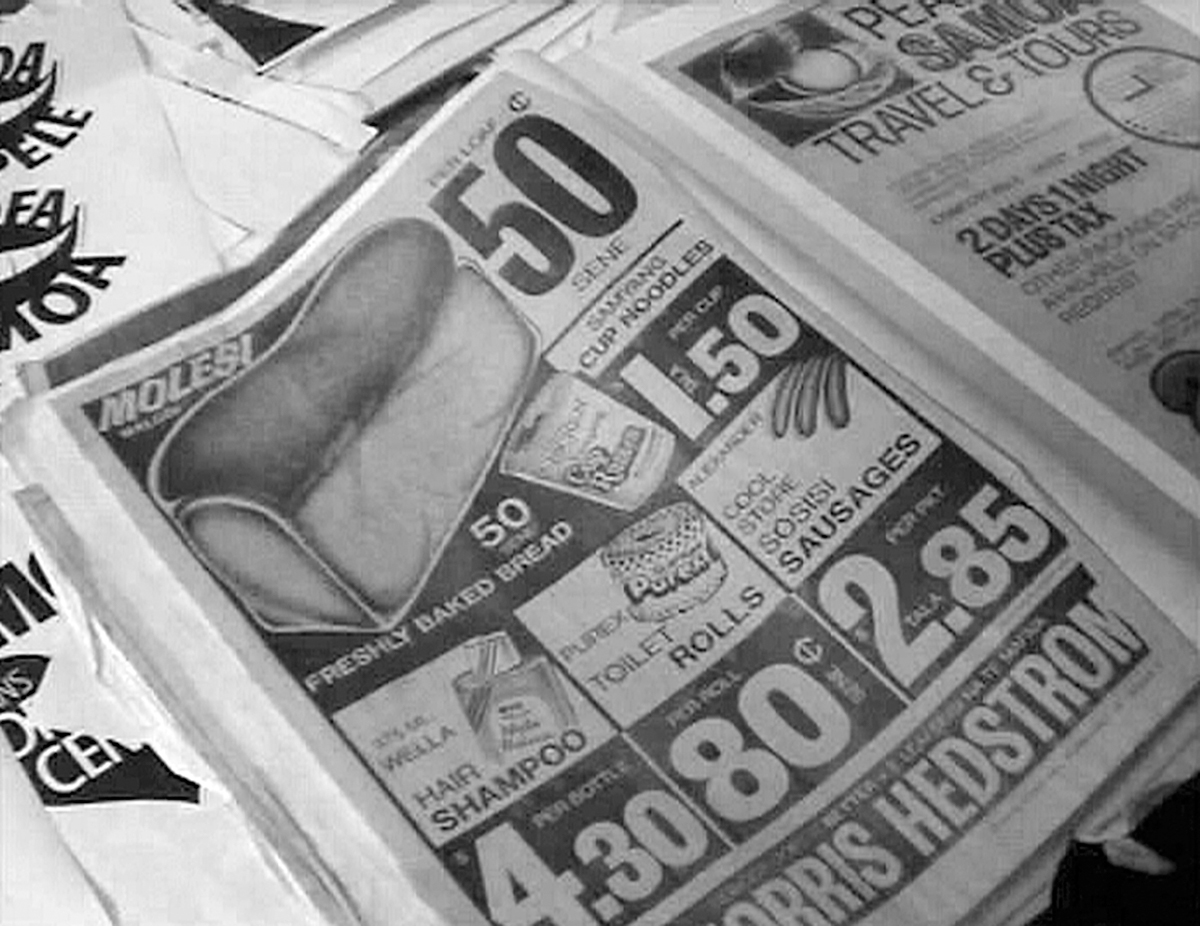
Have you been to Auckland?
Oh yes, many times, I used to go every school holiday. I’ve got an aunt there. I used to love going by train, it was very cheap—4 pounds 10 return.
It’s a good trip isn’t it? Did you take the one in the night or the day?
Night. Get there early in the morning.
Did you go just by yourself?
Yeah, I used to like watching the birds.
Handlettering
[#1 82:50]
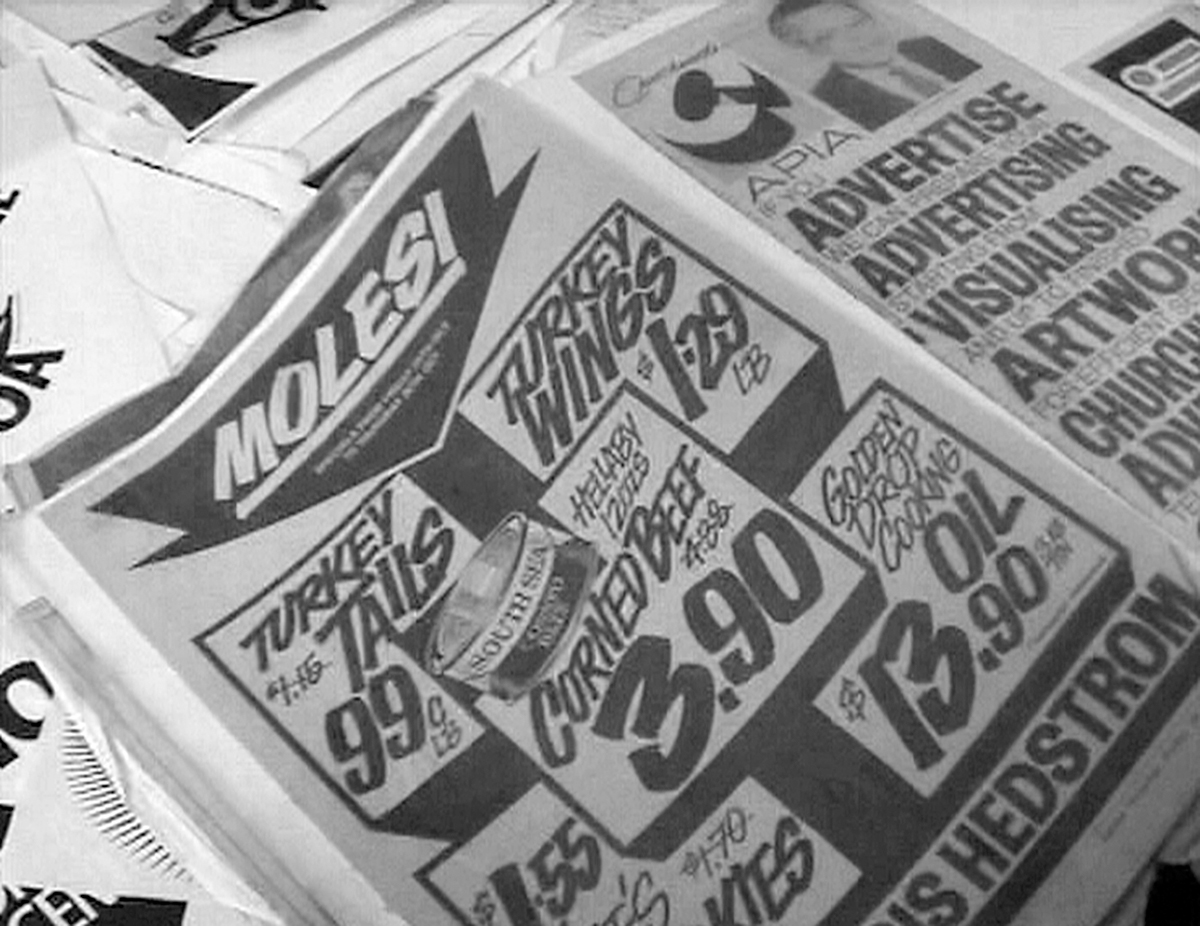
When you would do these hand-lettered works would you keep that same alphabet? Or would you re-draw it every time?
Re-draw every time. I would just pencil it out quickly. I used to be very fast at it.
Handlettering is superior
[#2 74:03 image / text #4 07:50]
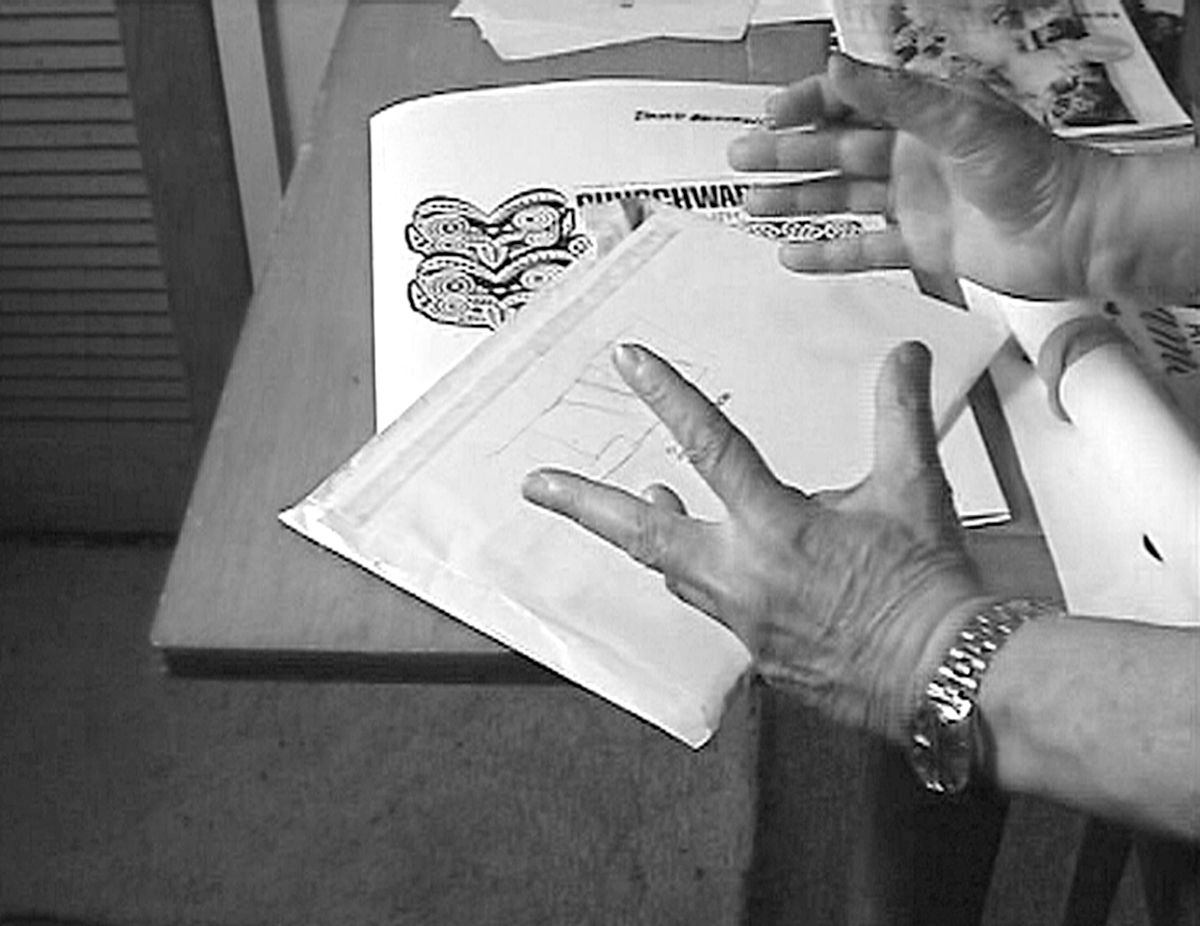
I was wondering why you wrote on your business card ‘Handlettering is Superior’?
Well, it’s my own thoughts. It is superior. Like I was saying, in a computer if you expand an alphabet or condense it you bring it out and you still have to correct it—it looks wrong. Where as if you do it the way I do it, it looks right.
Identities
[#2 23:38]
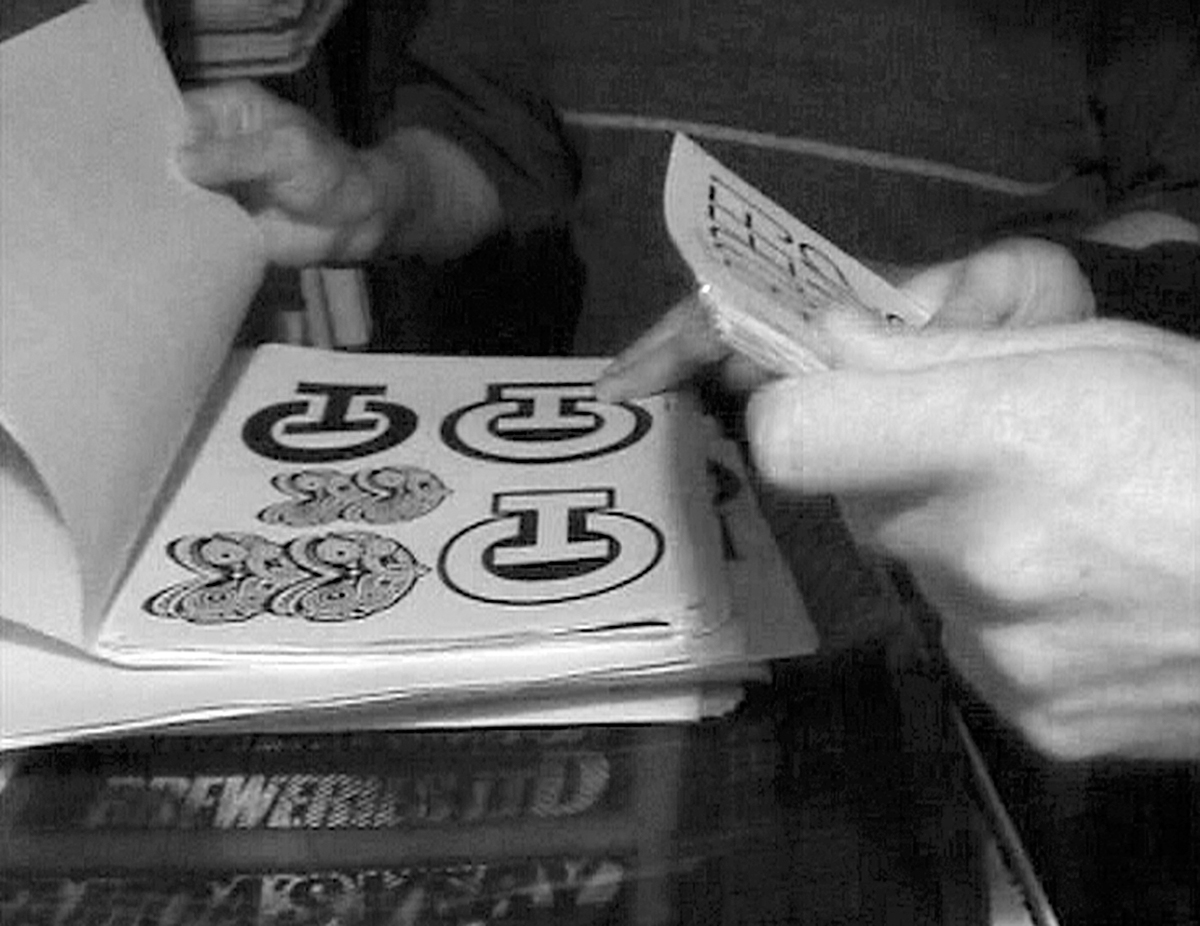
You have changed your logo quite a few times, and you change your business card quite a lot too. Is there a reason why you change them?
I just got fed up with the previous ones. And of course with my Maori one they said ‘You have no right to use Maori designs’. What I’m doing now is going back to my original ‘C’—and a couple of people have said ‘You’ve done the right thing I used to love that design’.
That ‘C’ was one of the first things you designed for your company?
I also had a globe. But the ‘C’ is what sticks the most in my mind.
When you had your company, would you change the logo when you would move offices or when you moved to Samoa?
No, just when I got fed up with the old one. I get fed up with seeing the same thing for a long time—so I change it.
Is that a reason why you make new typefaces as well?
Yeah, yeah… well, not because I get fed up of seeing it. But it’s more just to be different, to be creative.
You weren’t worried that when you changed your logo people would think you were a different company or person?
Well, there used to be Churchward Advertising; then I slowly changed it to become Churchward International Typefaces and Advertising.
Was there a reason for that change?
Because my designing was getting stronger and stronger.
You were doing more typefaces?
Yeah, and I was getting more interested in designing—although my staff were still doing the advertising work.
But you wanted to make it more about the typefaces?
Yes.
Influences
[#1 118:21]
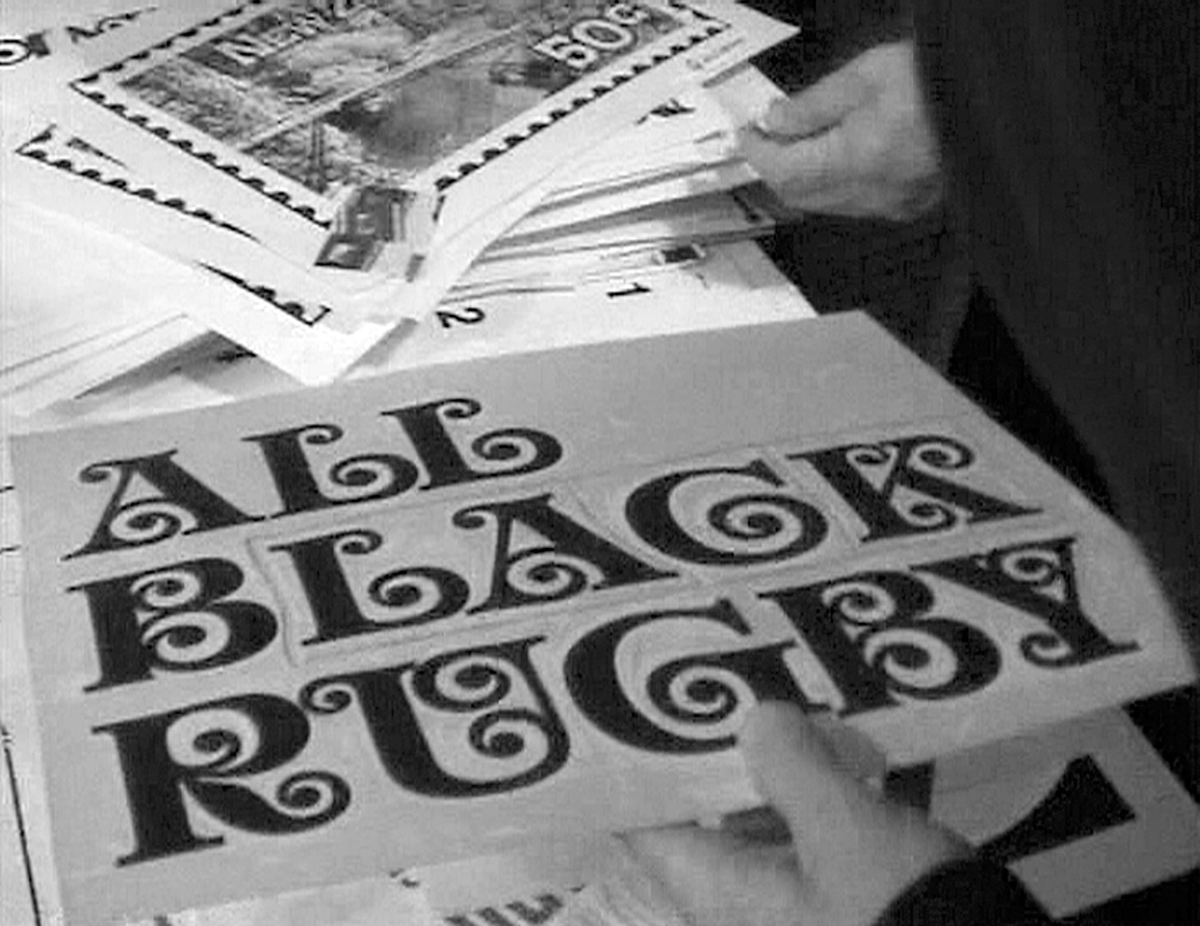
Are there other people’s typefaces you see that you like?
Sometimes I see a couple of letters and I like them very much, and I don’t know, perhaps I put them in my head and use them when the opportunity comes. Because normally, you don’t know when opportunity comes. You are just bashing away and it comes. And usually you are too proud to trace it back, but it probably comes from something you have seen before.
Inkwells
[#3 76:29]
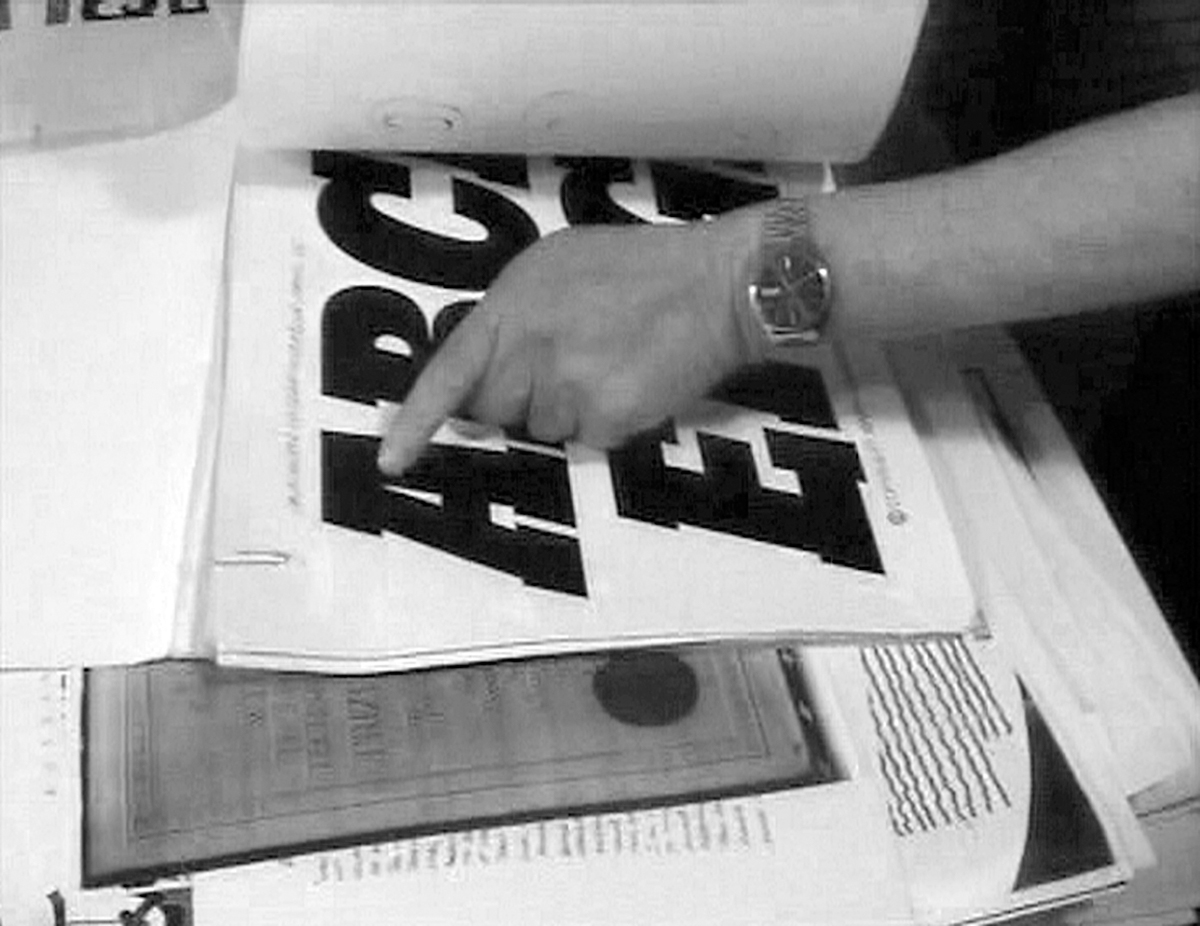
I’ve always taken special interest in these parts [inkwells] to make it clean. Otherwise if it is printed too heavy, this part becomes too black.
Inspecting the Mac
[#3 87:47 image / text #4 7:10]
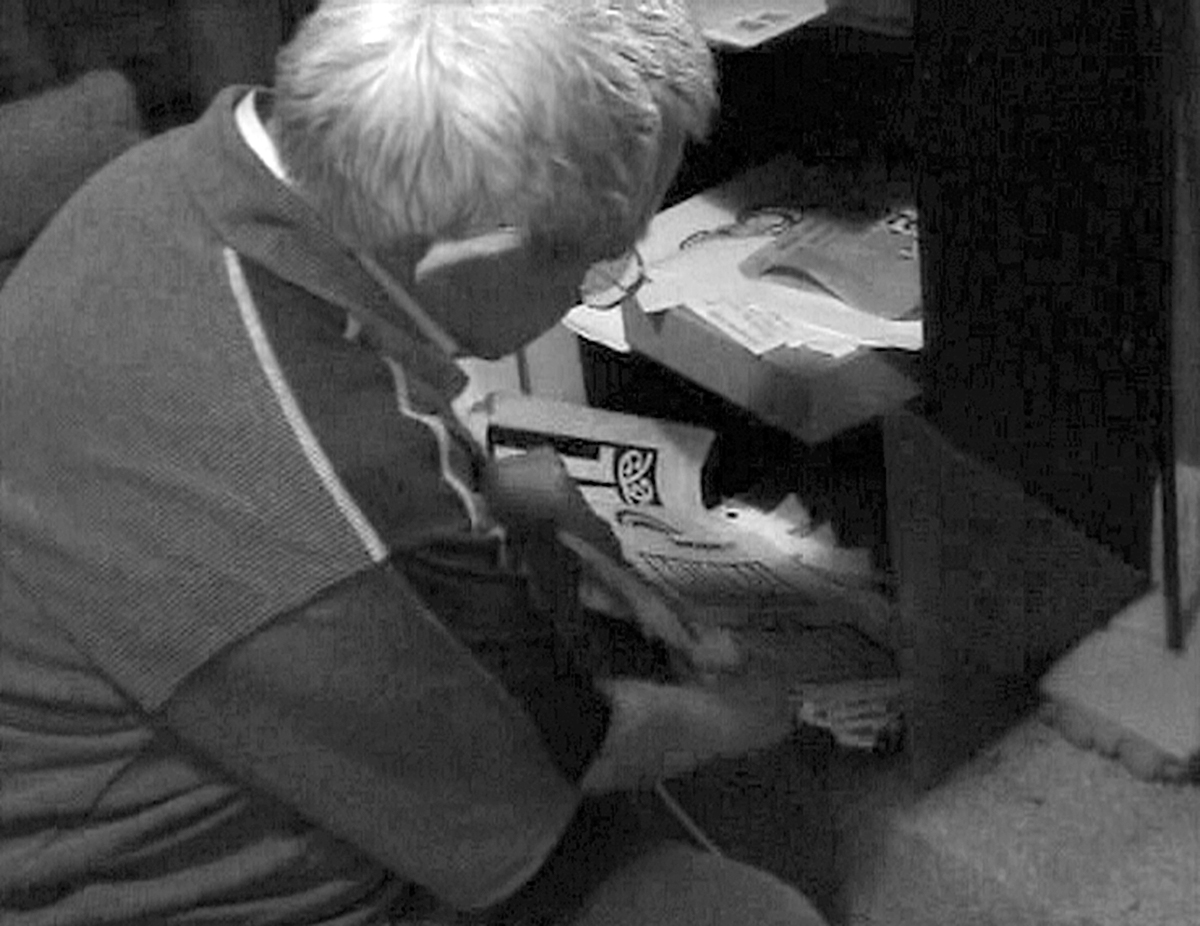
You know I was the first one to inspect the Apple Mac. They invited me to inspect it in Wellington and I was the only one there. They took one of my symbols and fed it into the computer, and blow me down, they produced a half-a-dozen variations with it. I thought ‘It’s a cartooning machine’. Then I discovered Walt Disney was the biggest shareholder. So I said ‘I don’t want a cartooning machine’, and blow me down, it killed me.
Jesus
[#1 77:13]
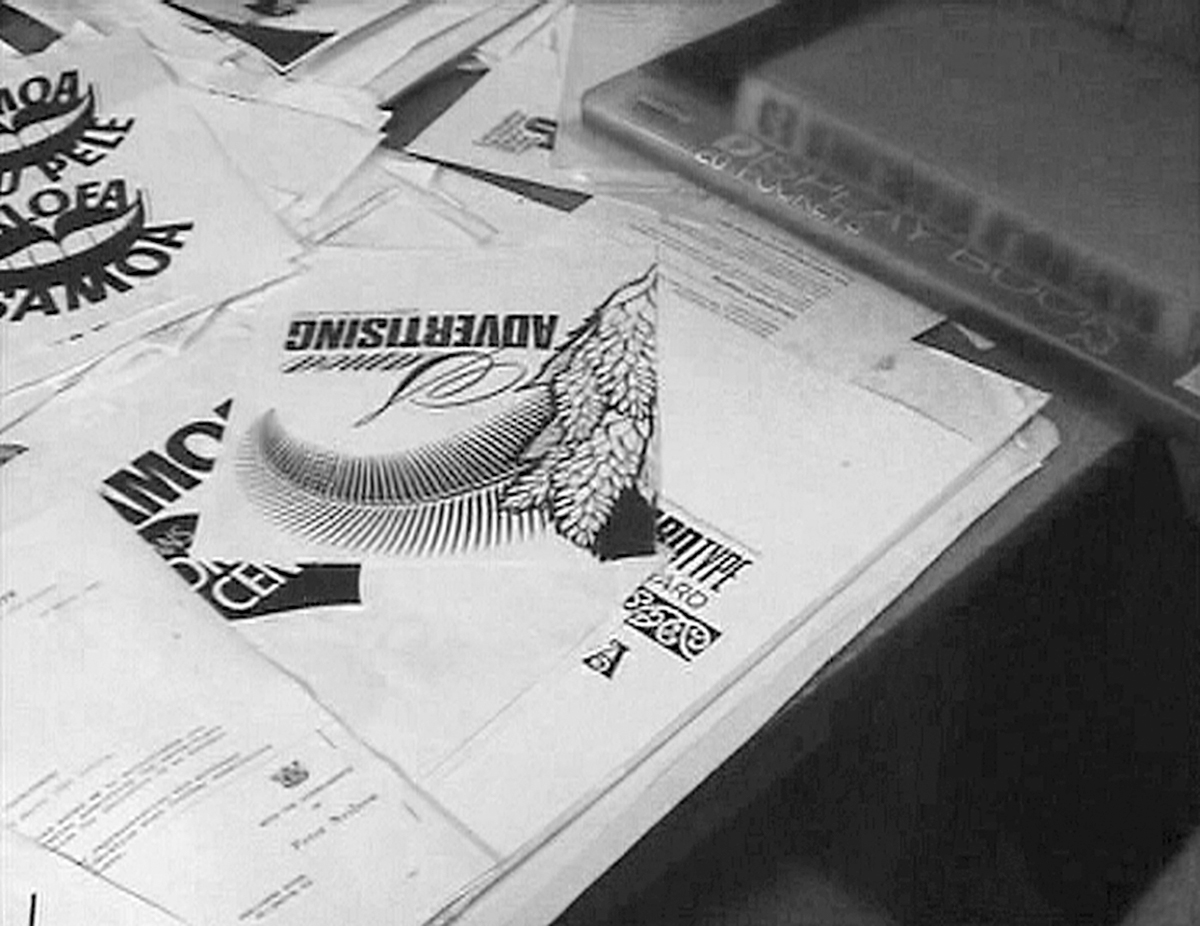
You said you were living at the church when you moved back to Samoa [1988].
I was living in their flats—it was cheap. It was 120 a fortnight and then they raised it to 450.
That’s a big increase.
When they discovered I wasn’t Jesus they charged me 450.
So, what church was that? Anglican, I think.
John Trash
[#3 88:04]
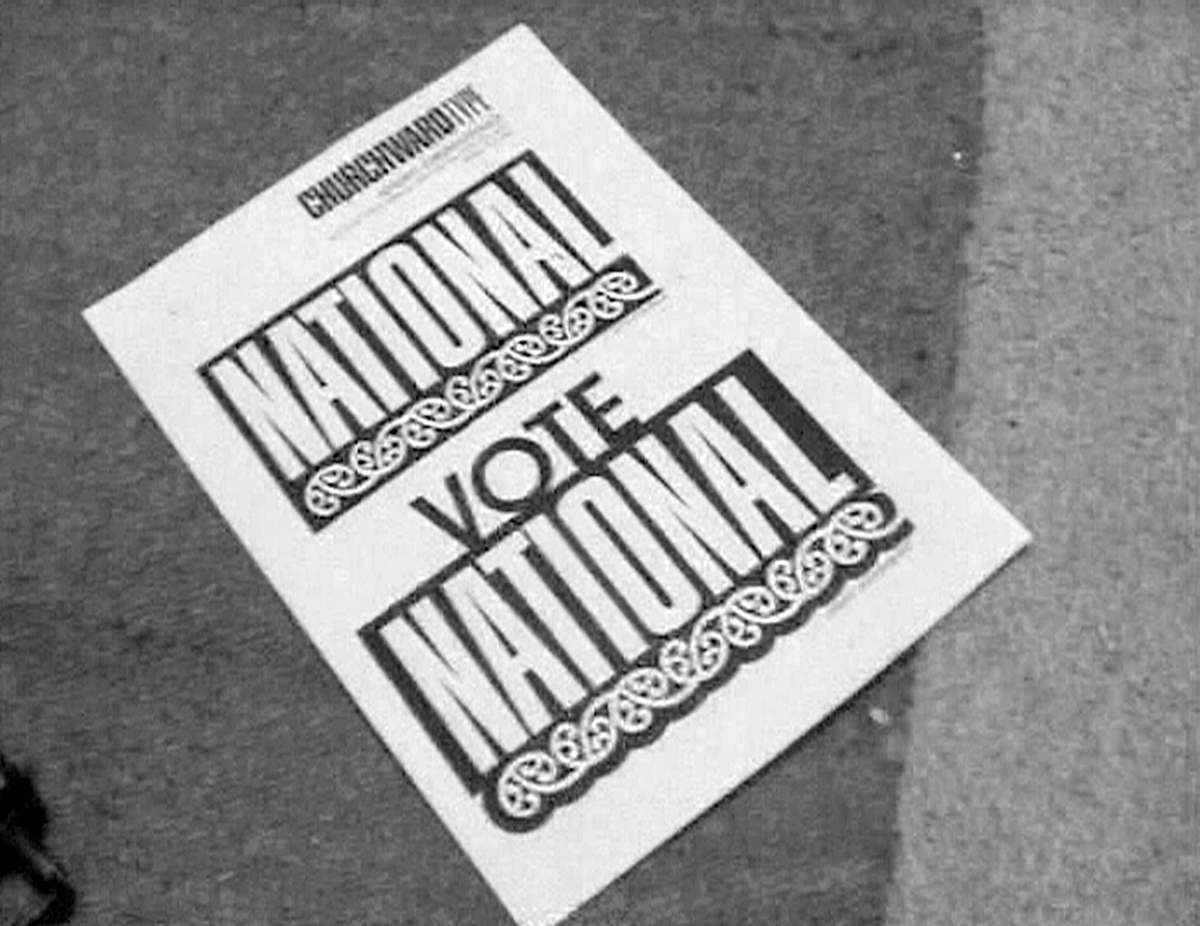
I sent some [suggestions] to Helen Clark and some to Don Brash. I met Don Brash when we were both young. My friend Ian Fairburn introduced me, he was about 14, his family had a shop in Kilburnie. But when I met him I said ‘Gosh! Your name would be better spelt with a ‘T’—'TRASH’. And he laughed like anything.
Just a little thing
[#2 21:10]
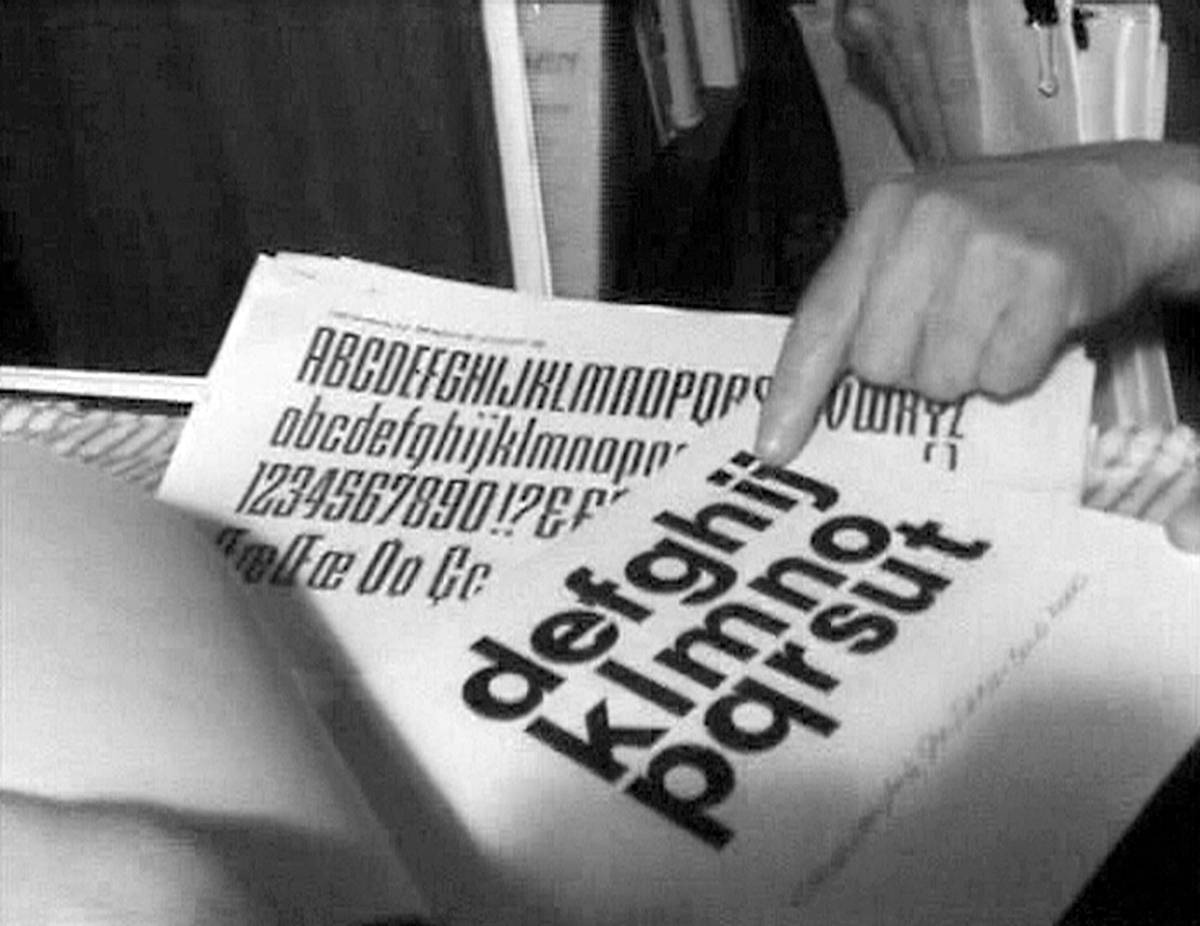
See? Just a little thing to make it different. Just a little thing to disturb it a little...
To be continued...
